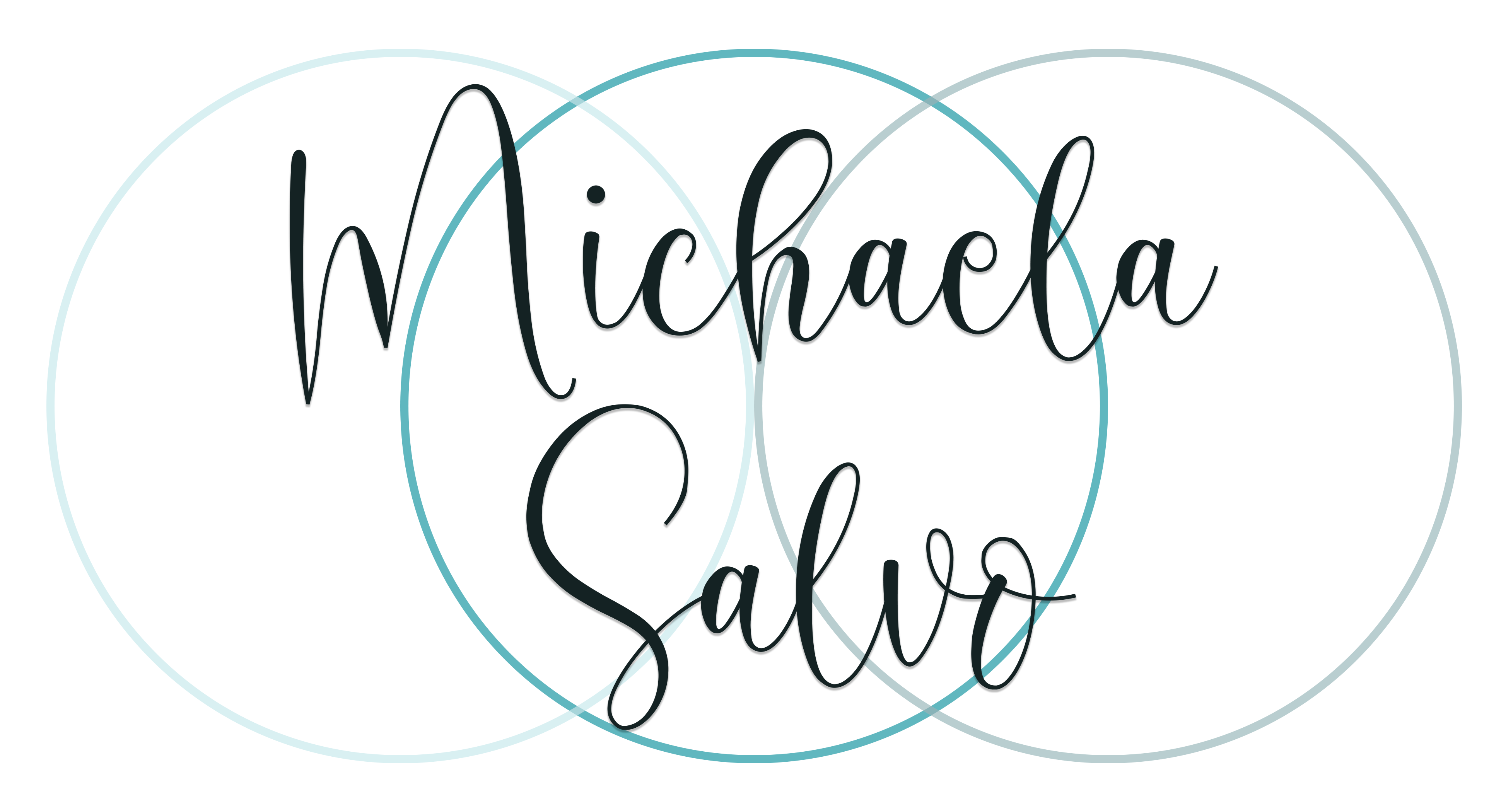Journal: Week 1: 22 January 2020
My day at the NBMAA frequently starts with gallery maintenance. On January 22th, 2020 I started with dusting the paintings. First, I put on my Nitrile gloves, then I dust the frame with a feather duster before I lightly dust the painting itself with the horsehair brush. I got through the whole museum that day which took me about an hour. Some of the galleries I completed were the Johnson Gallery, the Warrington Gallery, and the Boudreau Gallery. While I was dusting a group of kids stopped me to ask how I clean the Chihuly, since I have never done this before I asked Gabby who informed me that she tapes a feather duster to a stick. Once I was done dusting, Gabby found me and brought me to the Kara Walker exhibit. We were still completing set up and she wanted me to meet Bob who does the vinyl and Lisa who was curating the exhibit. Bob went to install the vinyl but before he did anything, Gabby, Keith, and Lisa approved it. Keith taught me a bit about lighting today, he told me that the Kara walker pieces are behind UV Protected Glass so they can handle more light than most pieces. However, the Walker pieces are not to exceed 15-foot candles of light. After the vinyl was approved, we headed down to the basement where Gabby and I wrapped photos in archival plastic for storage. The museum had just gotten a massive donation of film photographs, so we had to put them into storage. The photographs I wrapped were by: Edward Quigley, Erika Stone, Bill Owens, Paul Caponigno, William Witt, Jacques Lowe, Lou Stoumen, Larry Colwell, Leonard Freed, Ray Mortenson, Lou Stettner, and Danny Lion. Before I left for the day, I worked with Keith to create the labels for the Kara Walker exhibit. First, we adhered the printed labels to the mat board, then I cut them with a nice bevel on the mat cutter and lastly we hung them with Command Strips 57 inches off the ground.
Journal: Week 2: 27-29 January 2020
Week 2 at the NBMAA was dedicated to taking down the For America exhibit. I worked with Keith, and Mike like normal but we also had Amy from the museum in New York and Shawna who works in Events at NBMAA helping us out. Amy had to oversee everything we did since to work belonged to her museum. I was not allowed to touch very much because I didn’t have clearance. All of the work was packaged in travel frames or as Keith calls them, the nesting dolls of crates. I couldn’t touch any crates with work in them but I they did have me open all the empty crates. The front of the crates all needed to be screwed off. Once the others removed a piece from the walls, I removed the labels which were adhered to the wall with command strips. They wrapped most of the pieces in plastic, except the ones with gilded frames. This had OZ clips connected to them so they could be screwed into the crate which held them in place. The pieces had deep frames were wrapped with acid free twill tape before being wrapped in plastic, this prevents the plastic from clinging to the piece. I asked Shawna if I was allowed to take photos, but she said no for insurance reasons. On the 29th, Keith, Mike, and Amy were still taking down For America in the backrooms while I worked in the front rooms. First, I removed all the remaining wall labels. Next, I unscrewed all the hardware before I filled, the hole with spackle. Lastly, I scrapped the vinyl off the walls using a blade. Below I have attached some photos of that process.
This week I read Buck and Gilmore, MRM5: Section 1: The Profession and Miller, American Encounters, chapter 3. The MRM5 discussed museum professions. I learned that museums really begun to get organized around 1874-1877 after librarian, Melvil Dewey developed the Dewey Decimal System in Amherst, MA. Museums attempted this system for their own use. In the 1900s museums started labeling works first by the year and then by the number of works acquired that year. For example, the 3rd piece acquired by a museum in 1909 is 9.3. This is interesting be-cause this system is still used by the NBMAA except they used the full year, so the 103rd piece acquired in 2011 would be 2011.103. The American Encounters talked a lot about life in the Americas when the European powers like Spain, England and France were fighting to conquer. They mentioned that The Henry Whitfield House, the oldest stone house in New England had a hole for a canon facing England, which showed how bad relations were. The reading then went on to dis-cuss city planning. Because of the way I work, I was mainly interested in the cities I’ve lived near-by. Boston was designed organically which basically made it the worst city I have ever lived in in terms of navigation. However, New Haven which was inhabited but Puritan was modeled after wood cut of New Jerusalem, so it was designed on a square grid. William Penn also designed Philadelphia on a grid. He said it was to be a, “a green and pleasant town that never will burn.” Philly was built on a grid for protection whereas New Haven is on a grid for religion. Fun fact about William Penn and Philadelphia that I learned going to high school 30min outside of Philly; on top of the Philadelphia City Hall designed by John McArther Jr. and Thomas Ustick Walter there is a sculpture of William Penn holding a scroll by Alexander Milne Calder and from certain locations in Philadelphia it looks like Penn is peeing on the city. I guess everything was not planned out too well, or maybe it was just a fun way to get people exploring the city. It was interesting to learn about the planning that goes into every city.
Journal: Week 3: 3-5 February 2020
On February 3rd we removed the Chairway to Heaven Exhibit from the M. Stephen and Miriam R. Miller Shaker Gallery. Most of the furniture belonged to Steve Miller who was there for the deinstall. While Keith and Gabby were off site dropping off the furniture, I reset the gallery which involved removing the vinyl, unscrewing the hardware, and spackling the holes. Once I finished, I went to find Mike. He was painting the gallery after the deinstall of the For America exhibit. He had me paint a tricky corner were brick meets wall and around the exit sign. I had to get very high up on the ladder. After finishing that I worked in Photoshop creating scale replicas of all the pieces of an Anni Albers exhibit that goes up in the future. When I arrived to the NBMAA on the 5th and continued working on the Anti Albers mini pieces. Once I finished in Photoshop, I printed them, and mounted them on mat board. I tried cutting them with the box cutter, but the board was thick, and I wasn’t strong enough to cut all the way threw so Mike cut them, and I labelled them with the accession number, year created, and title. Once I was done, I did some more painting with Mike, while it was drying, he had me go find Keith. Keith had me follow him while he tried to figure out what to put in Shaker Gallery. Keith also taught me about dove tail which are like notches that the Shakers cut into wood so they could fit pieces together free of nails. While we were in the Shaker Gallery, we were called to loading dock because the people had arrived two hours early to pick up the For America exhibit. Keith and Gabby checked the paperwork multiple times to make sure this was correct. Mike joined us and we loaded all 10 crates into the truck. We watched to make sure all the crates were properly secured. Once the truck left the museum the work was no longer under the NBMAA’s responsibility, this shifted back to The National Academy of Design. I went upstairs to paint another coat of paint with Mike before I went home.
This week I read Buck and Gilmore, MRM5: Section 2: Policies and Miller, American Encounters, chapter 4. American Encounters discussed consumerism in the Americas. Imported goods were consider luxurious and showed wealth, especially those from China. Everyone wanted silver spoons and porcelain bowls. Ben Franklin’s wife bought him a silver spoon and porcelain bowl when he began gaining success. We still trade a lot with China but no longer due to high quality but because of low cost and child labor. Then, it discussed slavery and how that’s how African customs reached the Americas. Slaves were often forced to have many wives so they would reproduce more, and the masters could keep their children as slaves or sell them. In the South it became common to plant a pathway of trees leading up to your front door, this was adapted from Italian villas. Italians use the trees to symbolize good government and order. I found this funny because at least now Italy doesn’t have good government. America took a lot of architectural influence from Italy. Four Books of Architecture by Italian architect, Andrea Palladio was a book that many American architects took inspiration from. When Spain invaded the Americas, they took some native influence when building and incorporated it into their own style. This is mostly because after the stole their land and ripped down their existing structures the Spanish forced the Natives into slavery, making them build their villages and churches. One example of this is a church called San Xavier del Bae. San Xavier is a Spanish saint and Bae is an Indigenous word meaning “watering place”. The Spanish were horrible to the Indigenous people, when the girls turned seven, they were locked away from everyone else in an unescapable compound. People enjoyed investing in high quality goods. Trade professions like silversmiths, became popular. Artisans learned through apprenticing rather than going to school. This means they learned on the job. I wish this was still a common practice. Actually, in England you can still be an apprentice and it’s a common path taken. Whereas Ryan chose to study film at University, his brother did an IT apprenticeship, so he got paid to be trained in his field. I would have chosen to do this if it was offered to me. Commissioning artists to create portraits was a sign of wealth by the early 18th century. Artist at the time marketed through word of mouth. Most of Copley’s sitters were family members.
MRM5 was about collections management policies. Collections is responsible for documenting, caring for, and developing the museum’s collection. A collections department needs policies to ensure everything is done properly and efficiently. Policies dictate how intake is documented, collections are stored, monitored, and inventoried, the storage environment is monitored and how activities with the collection are documented. Policies are in place to protect the collection. They dictate how the museum operates and are written by a governing authority. Procedures are a bit different; they tell the staff how to implement the policies. Procedures are created by the staff rather than a governing authority. Policies are typically created by a team, who then reviews the legal, ethical, and professional standards and use that information to draft s policy. The drafted is redone until it is to everyone’s liking and is then either approved or denied by a governing authority. A policy starts with the introduction (mission, history, etc.), then discusses: acquisitions, appraisals and authentications, deaccessions, collections care, access and then loans. Ad hoc policies are flexible responses to frequent requests made by guests and staff. Rules related to photography is an ad hoc policy. No flash photography, all cameras must be registered, no photography, and no pictures of certain collections can all be ad hoc policies. Museums also need policies related to no display uses of artwork, for example, scientific sampling. Ad Hoc policies may include photography in galleries (general public, public relations, movie shoots), special events (access, plants allowed, and food and beverage allowed), photography in storage areas, sketching in galleries, education programs in galleries (size, materials for workshops, and physical activities like dancing), family festival guidelines, and animals in the galleries and/or gardens. Some ad hoc policies are relevant to only staff, these include scientific testing, treatment and display of scared objects, scared ceremonies, allowable live exhibitions, using historical objects, documentation and care of contemporary art, maintenance if galleries and objects, staff access to storage, access to exhibition areas in preparation, art in offices (personal, museum owned), and art on campus. It was cool to think of myself in a position to be writing museum policies, that’s a way off but hopefully I will be reading the policies of a museum that employs me next fall.
This week I read Buck and Gilmore, MRM5: Section 2: Policies and Miller, American Encounters, chapter 4. American Encounters discussed consumerism in the Americas. Imported goods were consider luxurious and showed wealth, especially those from China. Everyone wanted silver spoons and porcelain bowls. Ben Franklin’s wife bought him a silver spoon and porcelain bowl when he began gaining success. We still trade a lot with China but no longer due to high quality but because of low cost and child labor. Then, it discussed slavery and how that’s how African customs reached the Americas. Slaves were often forced to have many wives so they would reproduce more, and the masters could keep their children as slaves or sell them. In the South it became common to plant a pathway of trees leading up to your front door, this was adapted from Italian villas. Italians use the trees to symbolize good government and order. I found this funny because at least now Italy doesn’t have good government. America took a lot of architectural influence from Italy. Four Books of Architecture by Italian architect, Andrea Palladio was a book that many American architects took inspiration from. When Spain invaded the Americas, they took some native influence when building and incorporated it into their own style. This is mostly because after the stole their land and ripped down their existing structures the Spanish forced the Natives into slavery, making them build their villages and churches. One example of this is a church called San Xavier del Bae. San Xavier is a Spanish saint and Bae is an Indigenous word meaning “watering place”. The Spanish were horrible to the Indigenous people, when the girls turned seven, they were locked away from everyone else in an unescapable compound. People enjoyed investing in high quality goods. Trade professions like silversmiths, became popular. Artisans learned through apprenticing rather than going to school. This means they learned on the job. I wish this was still a common practice. Actually, in England you can still be an apprentice and it’s a common path taken. Whereas Ryan chose to study film at University, his brother did an IT apprenticeship, so he got paid to be trained in his field. I would have chosen to do this if it was offered to me. Commissioning artists to create portraits was a sign of wealth by the early 18th century. Artist at the time marketed through word of mouth. Most of Copley’s sitters were family members.
MRM5 was about collections management policies. Collections is responsible for documenting, caring for, and developing the museum’s collection. A collections department needs policies to ensure everything is done properly and efficiently. Policies dictate how intake is documented, collections are stored, monitored, and inventoried, the storage environment is monitored and how activities with the collection are documented. Policies are in place to protect the collection. They dictate how the museum operates and are written by a governing authority. Procedures are a bit different; they tell the staff how to implement the policies. Procedures are created by the staff rather than a governing authority. Policies are typically created by a team, who then reviews the legal, ethical, and professional standards and use that information to draft s policy. The drafted is redone until it is to everyone’s liking and is then either approved or denied by a governing authority. A policy starts with the introduction (mission, history, etc.), then discusses: acquisitions, appraisals and authentications, deaccessions, collections care, access and then loans. Ad hoc policies are flexible responses to frequent requests made by guests and staff. Rules related to photography is an ad hoc policy. No flash photography, all cameras must be registered, no photography, and no pictures of certain collections can all be ad hoc policies. Museums also need policies related to no display uses of artwork, for example, scientific sampling. Ad Hoc policies may include photography in galleries (general public, public relations, movie shoots), special events (access, plants allowed, and food and beverage allowed), photography in storage areas, sketching in galleries, education programs in galleries (size, materials for workshops, and physical activities like dancing), family festival guidelines, and animals in the galleries and/or gardens. Some ad hoc policies are relevant to only staff, these include scientific testing, treatment and display of scared objects, scared ceremonies, allowable live exhibitions, using historical objects, documentation and care of contemporary art, maintenance if galleries and objects, staff access to storage, access to exhibition areas in preparation, art in offices (personal, museum owned), and art on campus. It was cool to think of myself in a position to be writing museum policies, that’s a way off but hopefully I will be reading the policies of a museum that employs me next fall.
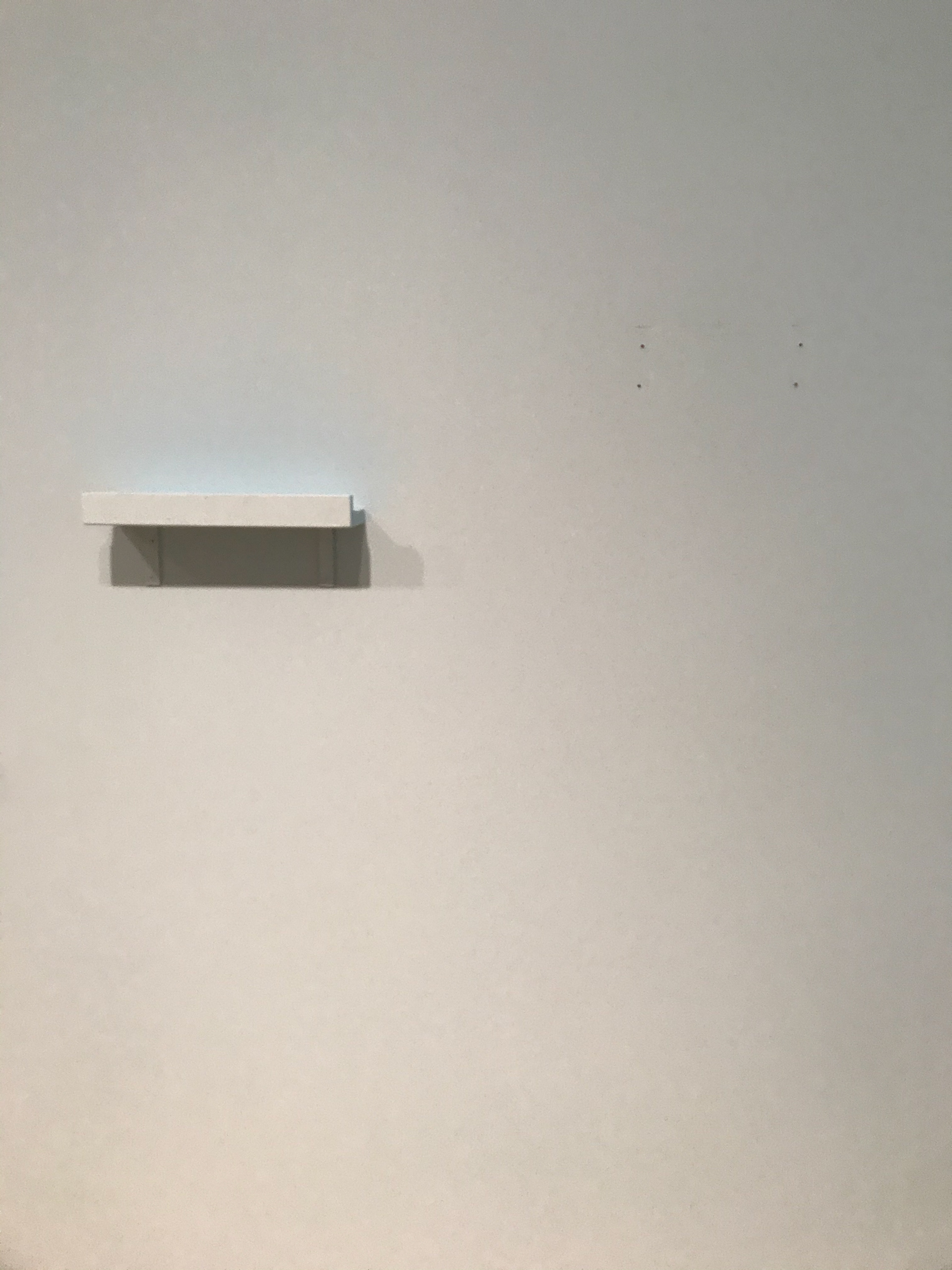

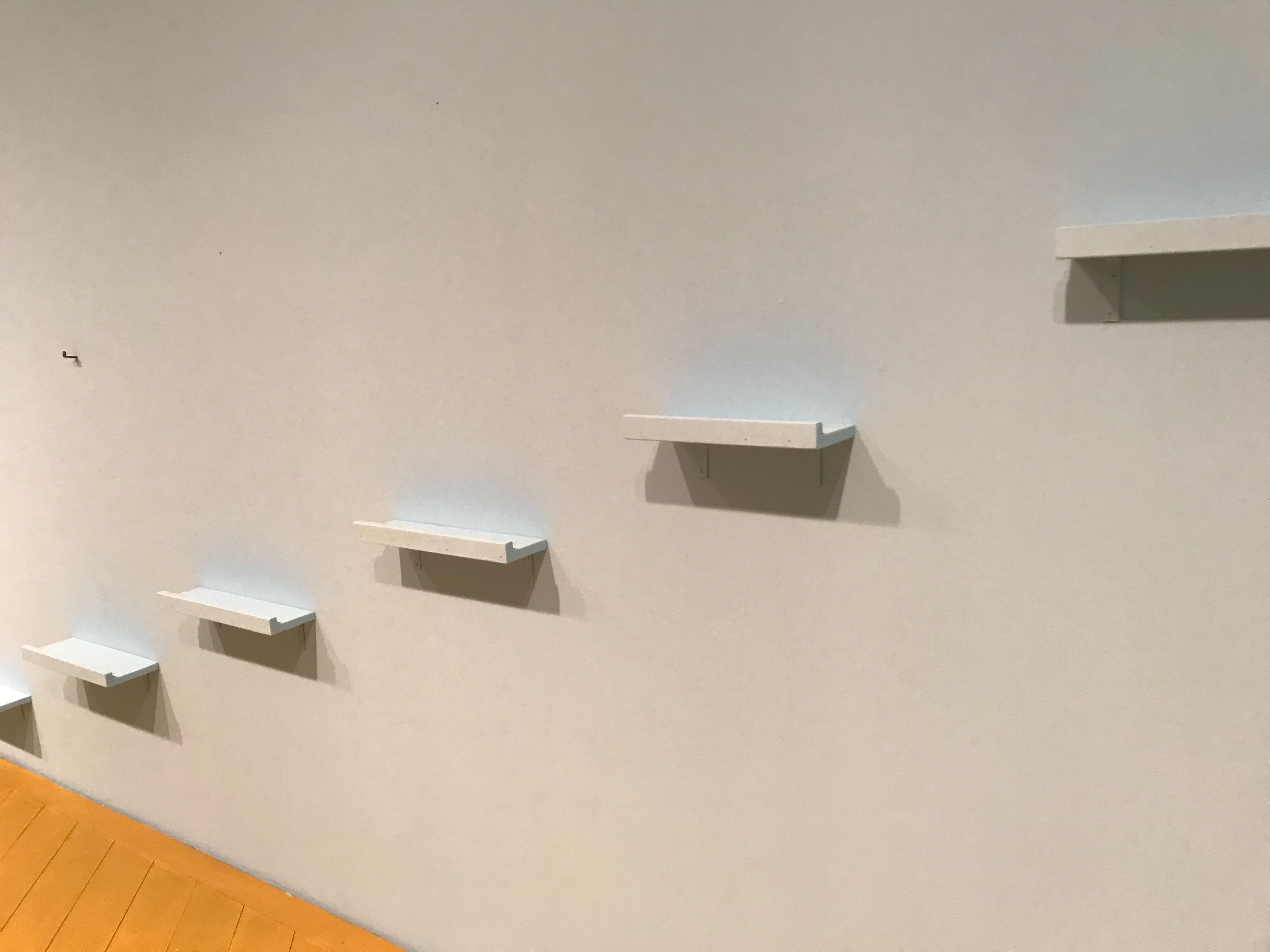


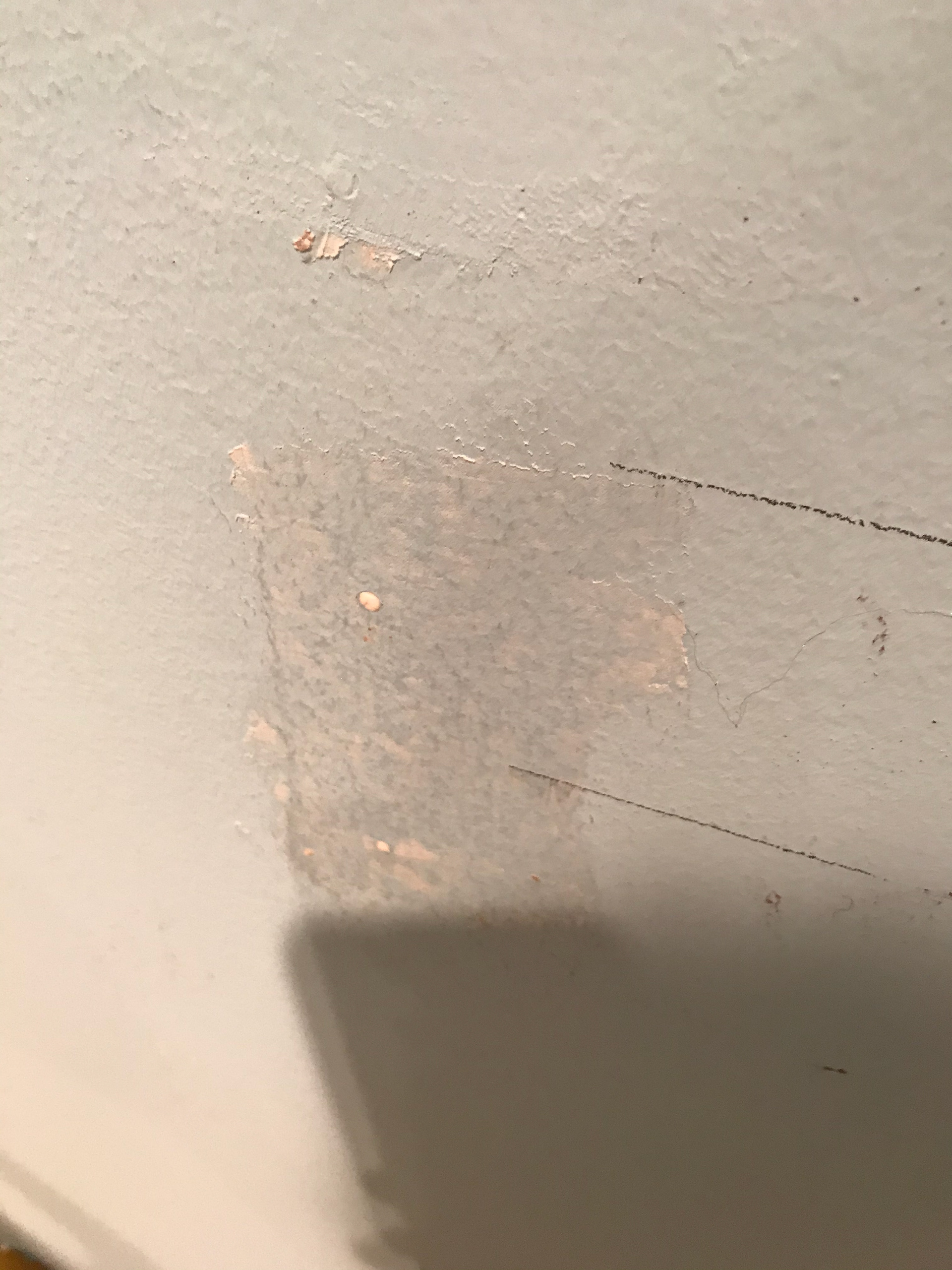
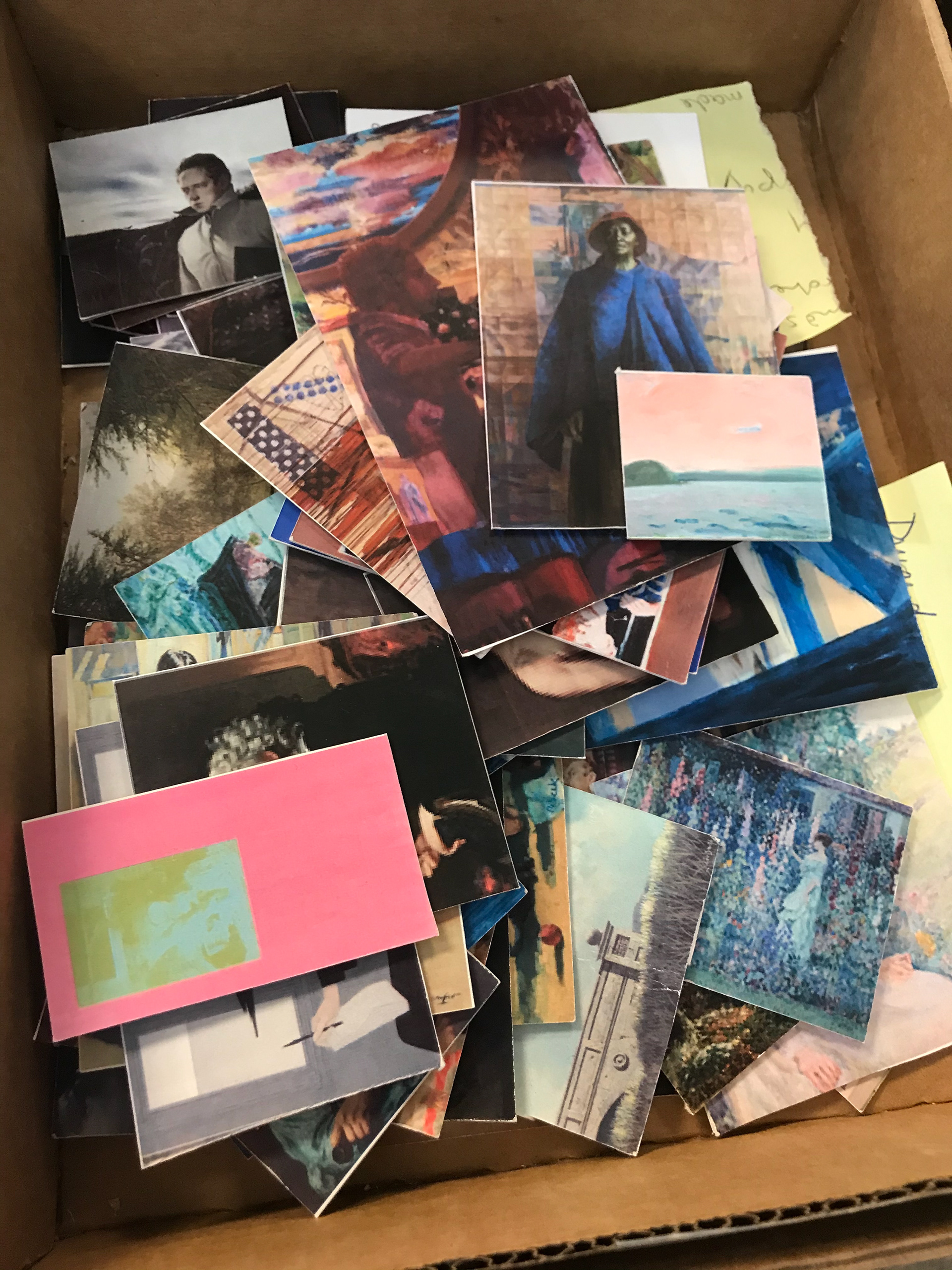
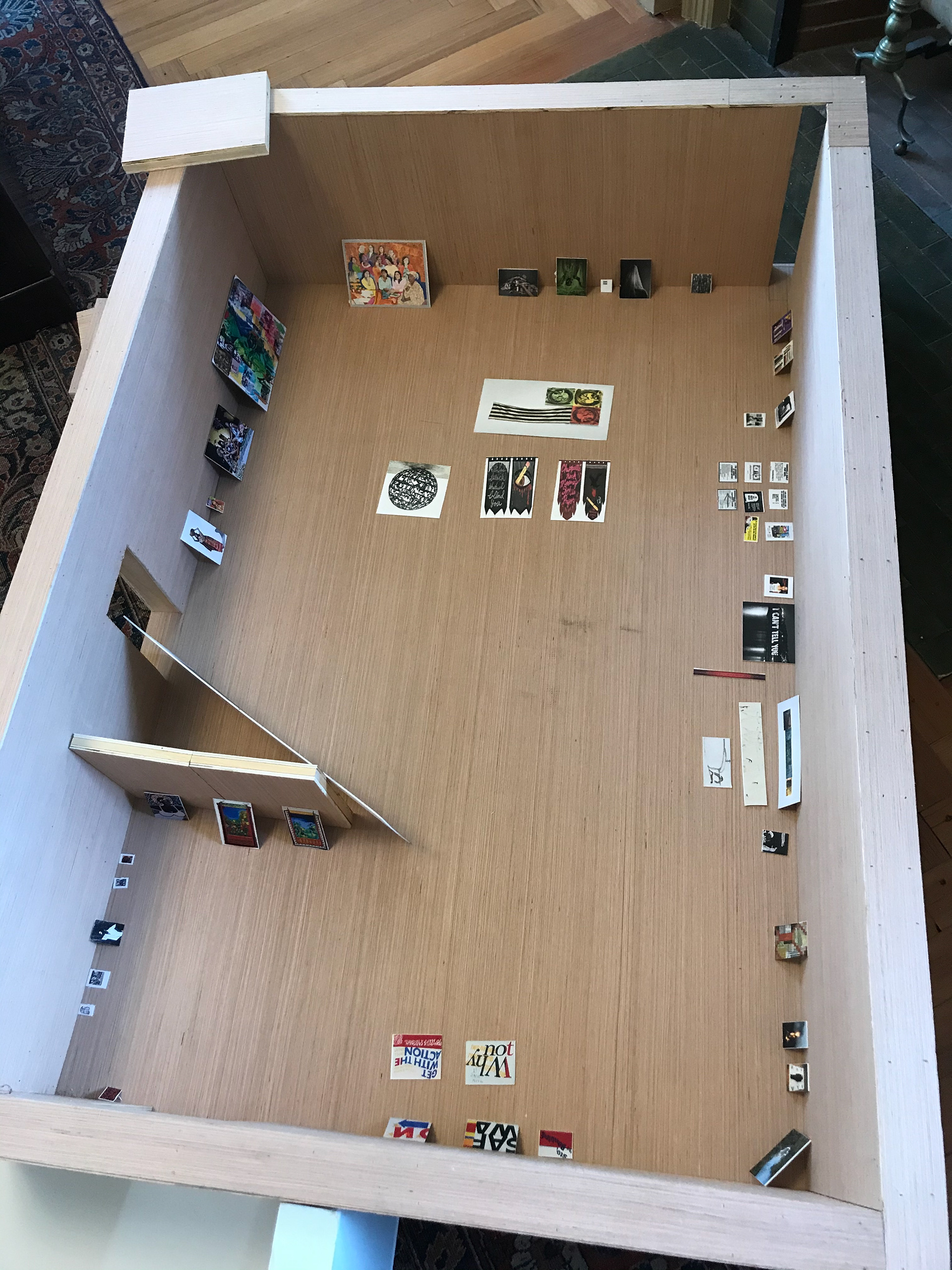
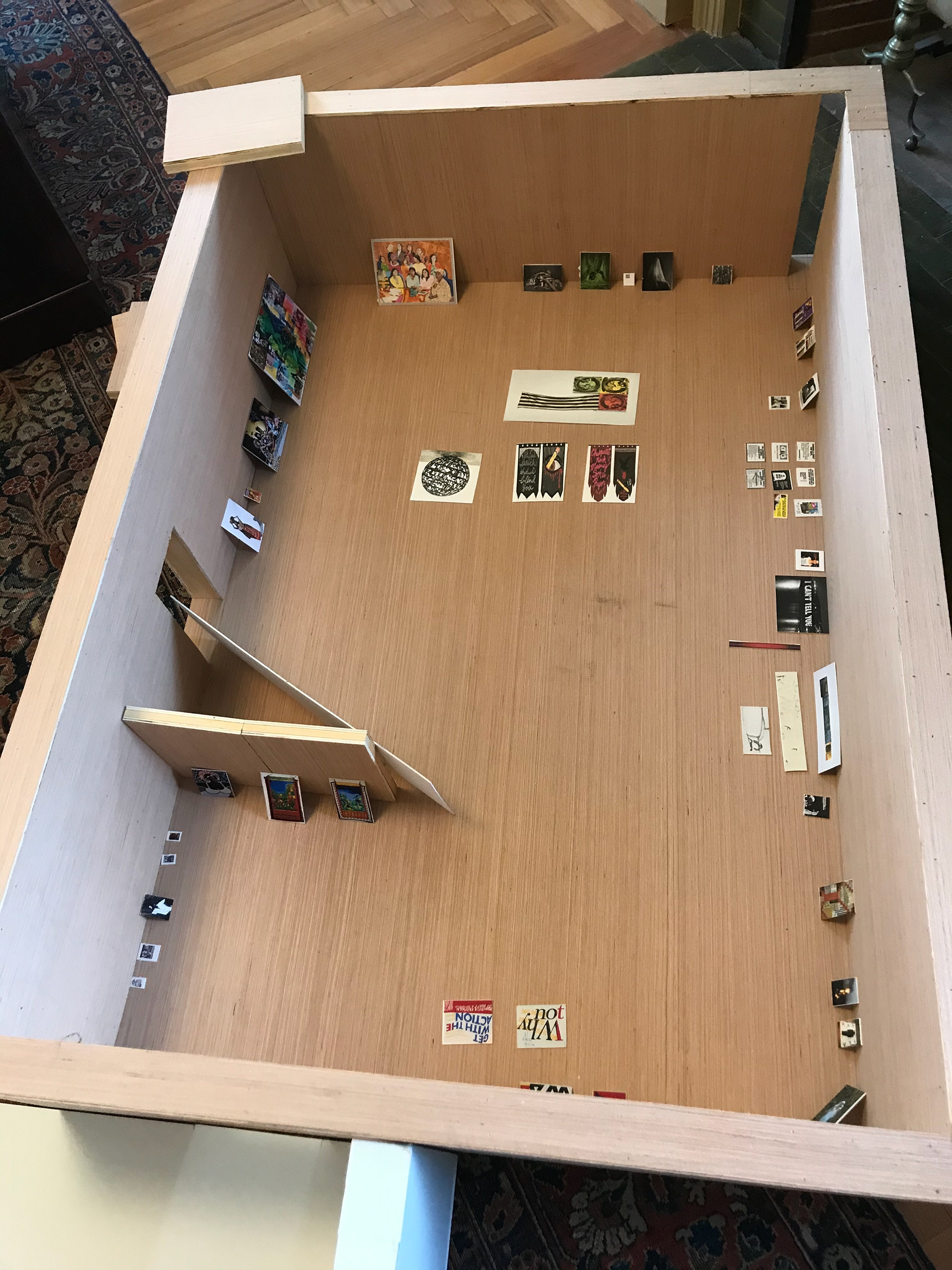
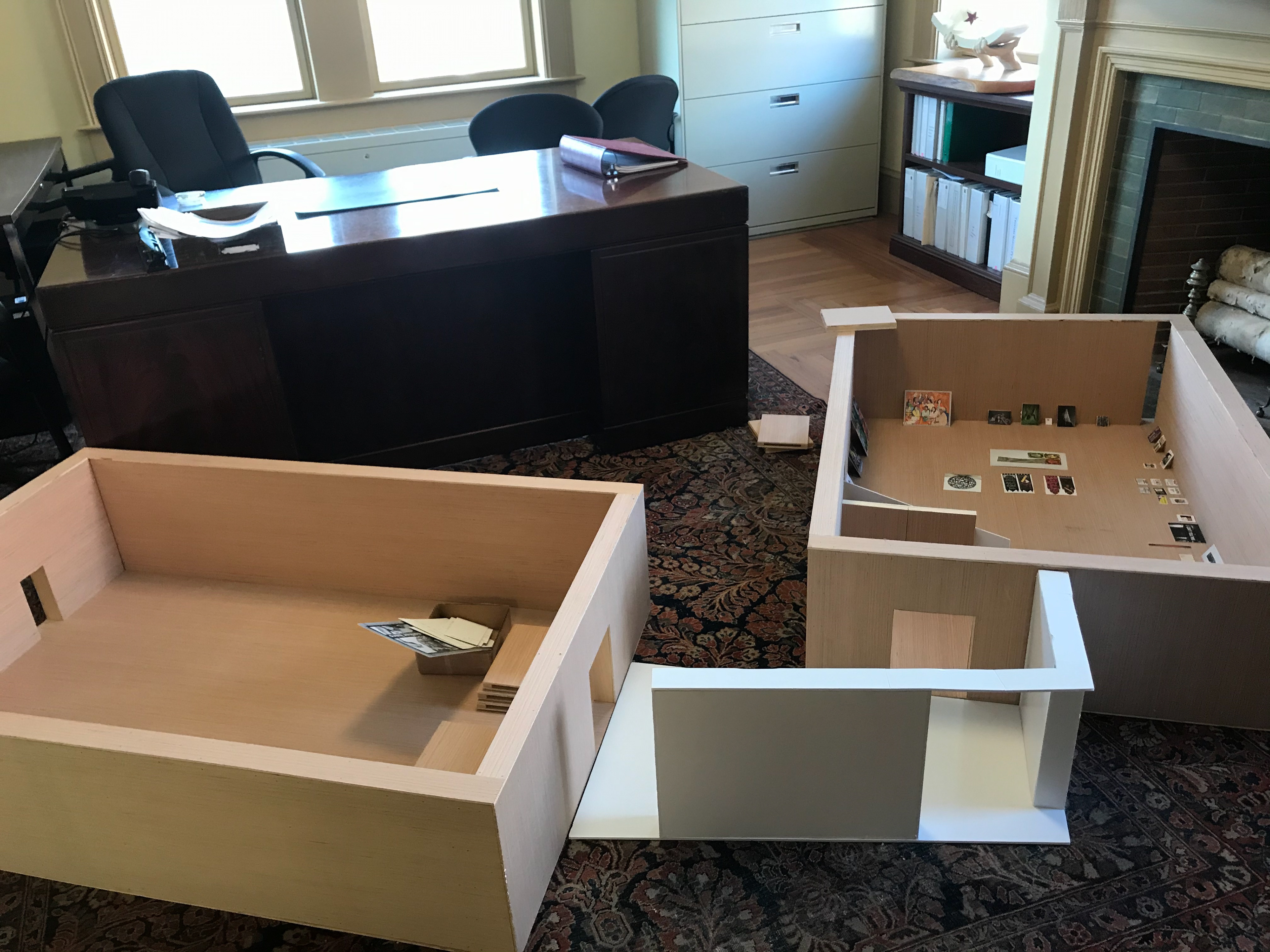

Journal: Week 4: 10-12 February 2020
What I did at the NBMAA…
On February 10th I started with helping Mike change the lightbulbs in the Kara Walker exhibit. He climbed the ladder and I passed them. Today was favor day, Mike and I did a lot of favors for people in different departments. We started by packaging a piece for Rashmi. She sold the piece and had to mail it. First, we wrapped it in plastic, then bubble wrap, making sure to include courtesy flaps in the tape so the person who unwraps it won’t struggle. We then created a box custom to the piece and taped it up. We then adhered fragile stickers outside the box to lessen the chance of damage in transit. I then helped Gabby by cutting labels for the new Shaker exhibit. Then we helped another department by building them a self to hold liquor for events. The shelf already had a frame, but we used a power saw to cut a piece of wood that became the top and the base. I then joined Gabby in the Shaker Gallery to help with lighting. Keith wanted to try out floods instead of spotlights. Gabby taught me the term “Jeweled lighting” which she described as when the gallery is dark but the light on the paintings is very bright, creating a lot of contrast. She also taught me that the metal cross on the lights is called a baffle and it controls the light. Gabby didn’t like the flood lights, but Keith did so the decide to try them out for a while. On February 12th I was told to bring my camera. The had me photograph Kara Walker, the Create Space, and Shaker. In the Walker exhibit I was sure to put the flections on easily removable areas, like over the mat so it wouldn’t be a struggle to photoshop later. Then I helped Keith build a massive weaving wall for the Albers Exhibit. First, I helped him make sure all the screws were at an even level, so they looked nice. Then I filled in the screw holes with wooden dowels. The dowels were too big, so I had to whittle them down, hammer them into the hole, then saw the dowel and sand it down.
On February 10th I started with helping Mike change the lightbulbs in the Kara Walker exhibit. He climbed the ladder and I passed them. Today was favor day, Mike and I did a lot of favors for people in different departments. We started by packaging a piece for Rashmi. She sold the piece and had to mail it. First, we wrapped it in plastic, then bubble wrap, making sure to include courtesy flaps in the tape so the person who unwraps it won’t struggle. We then created a box custom to the piece and taped it up. We then adhered fragile stickers outside the box to lessen the chance of damage in transit. I then helped Gabby by cutting labels for the new Shaker exhibit. Then we helped another department by building them a self to hold liquor for events. The shelf already had a frame, but we used a power saw to cut a piece of wood that became the top and the base. I then joined Gabby in the Shaker Gallery to help with lighting. Keith wanted to try out floods instead of spotlights. Gabby taught me the term “Jeweled lighting” which she described as when the gallery is dark but the light on the paintings is very bright, creating a lot of contrast. She also taught me that the metal cross on the lights is called a baffle and it controls the light. Gabby didn’t like the flood lights, but Keith did so the decide to try them out for a while. On February 12th I was told to bring my camera. The had me photograph Kara Walker, the Create Space, and Shaker. In the Walker exhibit I was sure to put the flections on easily removable areas, like over the mat so it wouldn’t be a struggle to photoshop later. Then I helped Keith build a massive weaving wall for the Albers Exhibit. First, I helped him make sure all the screws were at an even level, so they looked nice. Then I filled in the screw holes with wooden dowels. The dowels were too big, so I had to whittle them down, hammer them into the hole, then saw the dowel and sand it down.
What I got out of reading MRM5: Section 3: The Basics…This section started with discussing intake. When and object comes into a museum it must be reviewed by the curatorial staff and included a temporary custody or incoming loan agreement. If the gift is accepted the museum creates a statement about the fate of the object and signs the agreement. When the object officially arrives, it comes with a receipt and is assigned an accession number, TR for temporary receipt, TD for temporary deposit and L for loan. The object if unpacked and a condition report is completed. A database is created for the object and all known contact info, reason for entry and a description of the object is included. The reasons for an object entry include gift on approval, bequest, exhibition loan, long term loan. The object is then photographed, and the location is noted. There are different types of gifts, they include: unrestricted gifts, restricted, bequests, purchases, bargain sales, exchange, field collections (not common for art), and conversion. To receive a gift a museum needs an intent to donate in writing, a proof of physical receipt, and a written acceptance of the gift. The MRM5, then moved in to discussing art that was stolen by the Nazis. I found this every interesting because my favorite movie is The Woman in Gold. I want to go see the Portrait of Adele Bloch-Bauer in New York and I got to go to the Belvedere in Vienna to see The Kiss by Klimt already. Museums must come up with a provenance or a history of ownership for each piece. This helps them determine if a piece was stolen. Provenances ideally span from the creation of the object to the present. The President’s Advisory Commission on Holocaust Assets (PCHA) is an organization that informs the president when is discovered that an asset in the US actually belongs to a holocaust survivor so it can be returned. Any object created before 1946 and acquired by the museum after 1932 that went through a change in ownership between 1932-1946 and have been in continental Europe are called covered objects. Covered objects are objects that may have been stolen by the Nazis. Red flag names also help museums detect art that was stolen. Red flag names are the names of people involved in art looting. If a red flag name shows up on the provenance of a covered object, then it was stolen by the Nazis. Before museums accept loans, they check the provenance for ownership during WW2. If a museum discovers that an object was stolen by the Nazis it can be deaccessioned and returned to the individual if the person is the legal heir and there is documented evidence.
What I got out of reading American Encounters, chapter 5…Chapter 5 was about Neoclassicism which is characterized by symmetry and order and offers people threatened by social turmoil a glimpse of timeless value and universal truths. Ben Franklin believed that America was ahead of England in every area but the arts. In America artists were beginning to get a bit more political. For example, Copley created The Deplorable State of America because he was enraged by the stamp act. More painting started depicting battles like, The Death of General Warren at the Battle of Bunker's Hill, 17 June, 1775 by Trumbull. The ATHENAEUM PORTRAIT is the most famous portrait of George Washington and it was painted by Gilbert Stuart in 1796. This is thought to be the least accurate painting of George Washington, but it is what we have come to know as Washington’s face, it is the face we see on our money every day. Stuart was commissioned by Washington’s wife to paint the portrait; she didn’t have many portraits other husband because he hated sitting for paintings. Stuart however, refused ever finish the portrait instead he duplicated it repeatedly, selling it others for $100 a piece. He never did gave a copy to Washington’s wife. Personally, I think Stuart was a massive jerk but that’s just me. I really enjoyed the Portrait of Phyllis Wheatley by Moorhead. This portrait is thought to be the first portrait on an African American created by and African American. Wheatley was also published the first documented book of poetry by and African American and she was a woman! Wheatley was very accomplished. Joshua Johnston was another African American artist and he was very successful. Owning a Johnston portrait was a sign of success for the middle class. Lastly, of course my favorite piece of the Chapter is Prudence Punderson’s The First, Second, and Last Scene of Mortality which is an embroidered self-portrait. This piece explores life stages in such and amazing way. She created art with such meaning at a time when women were not even allowed to work. I really hope I get to see this piece.
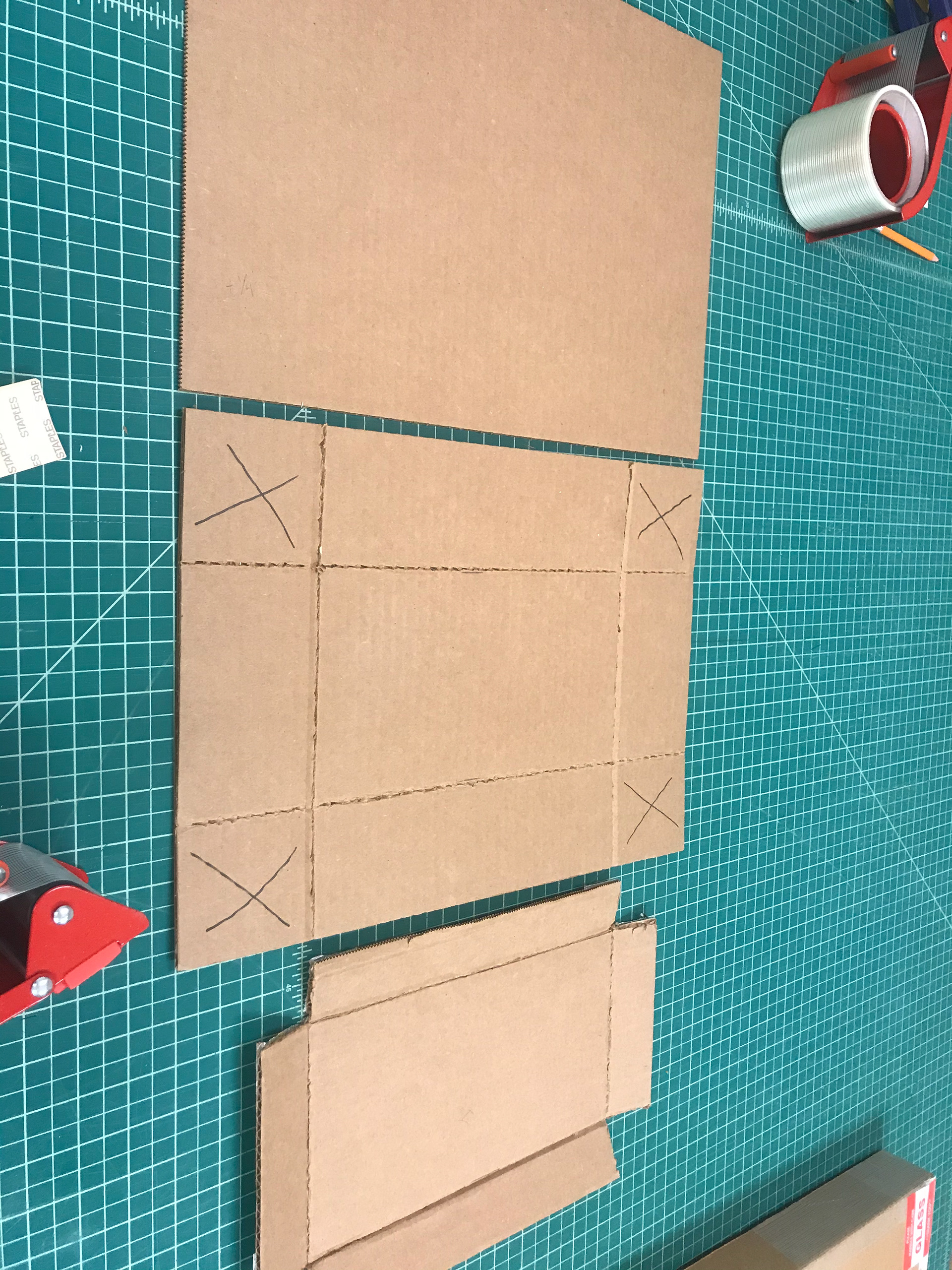
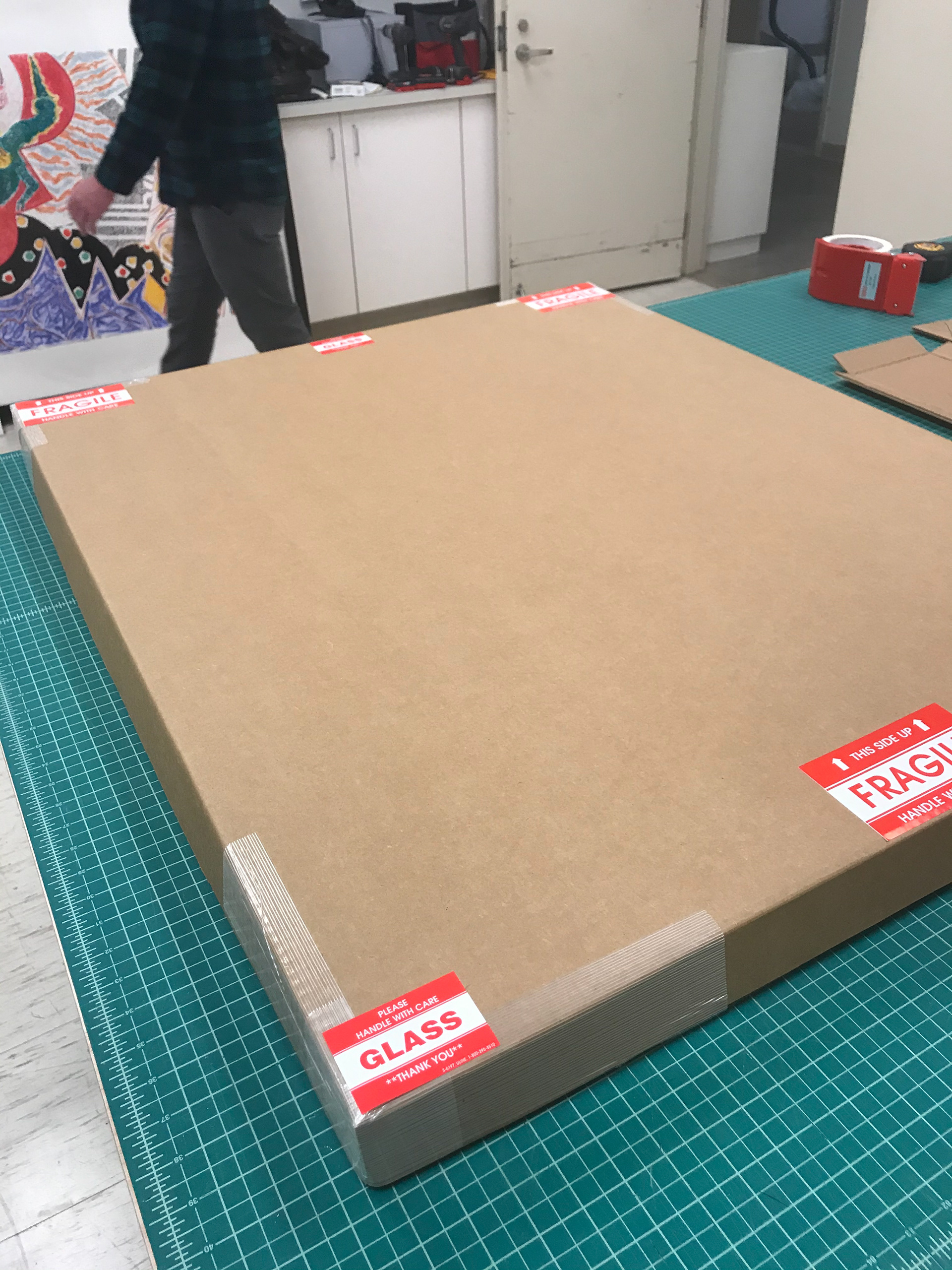
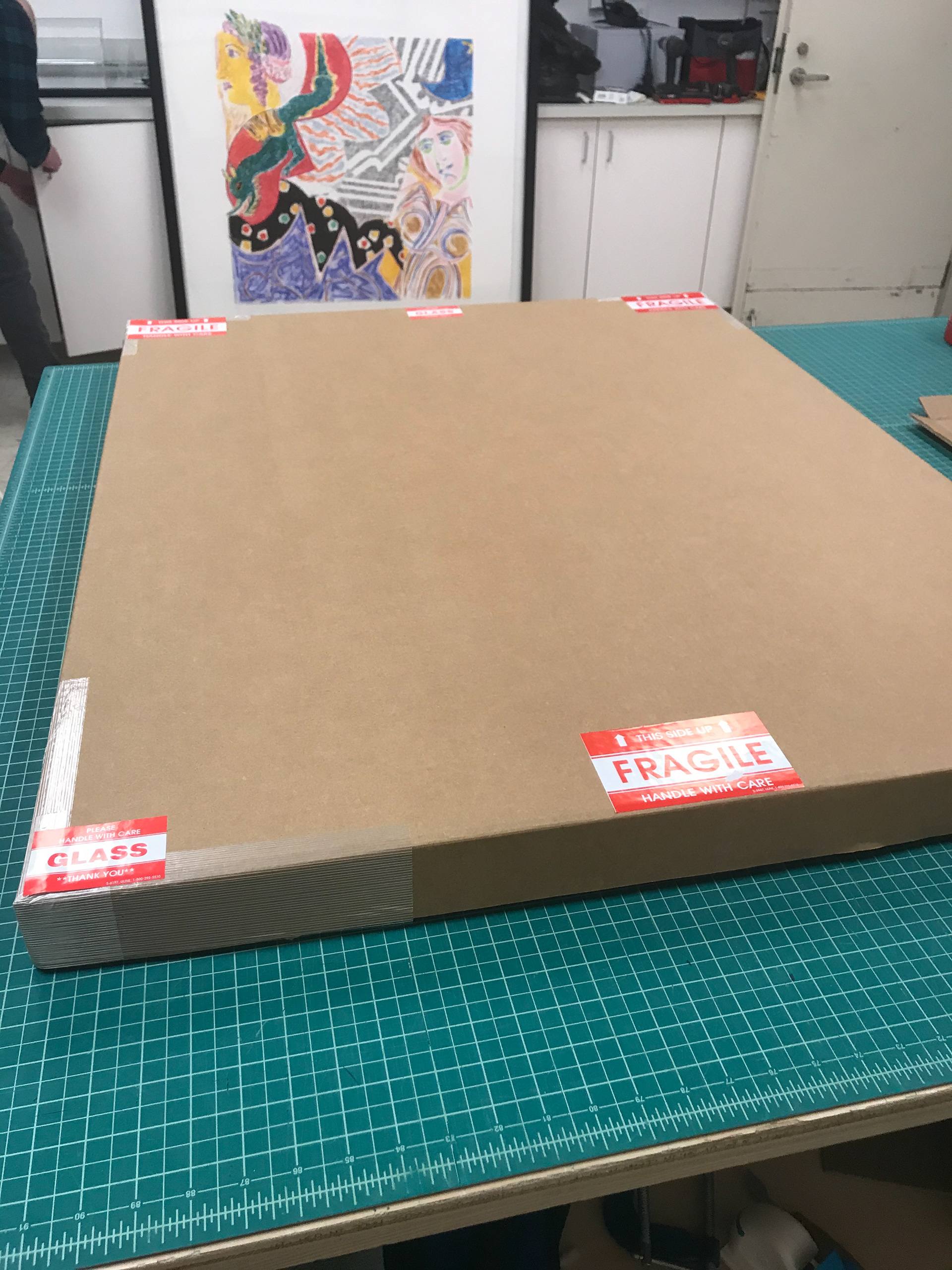

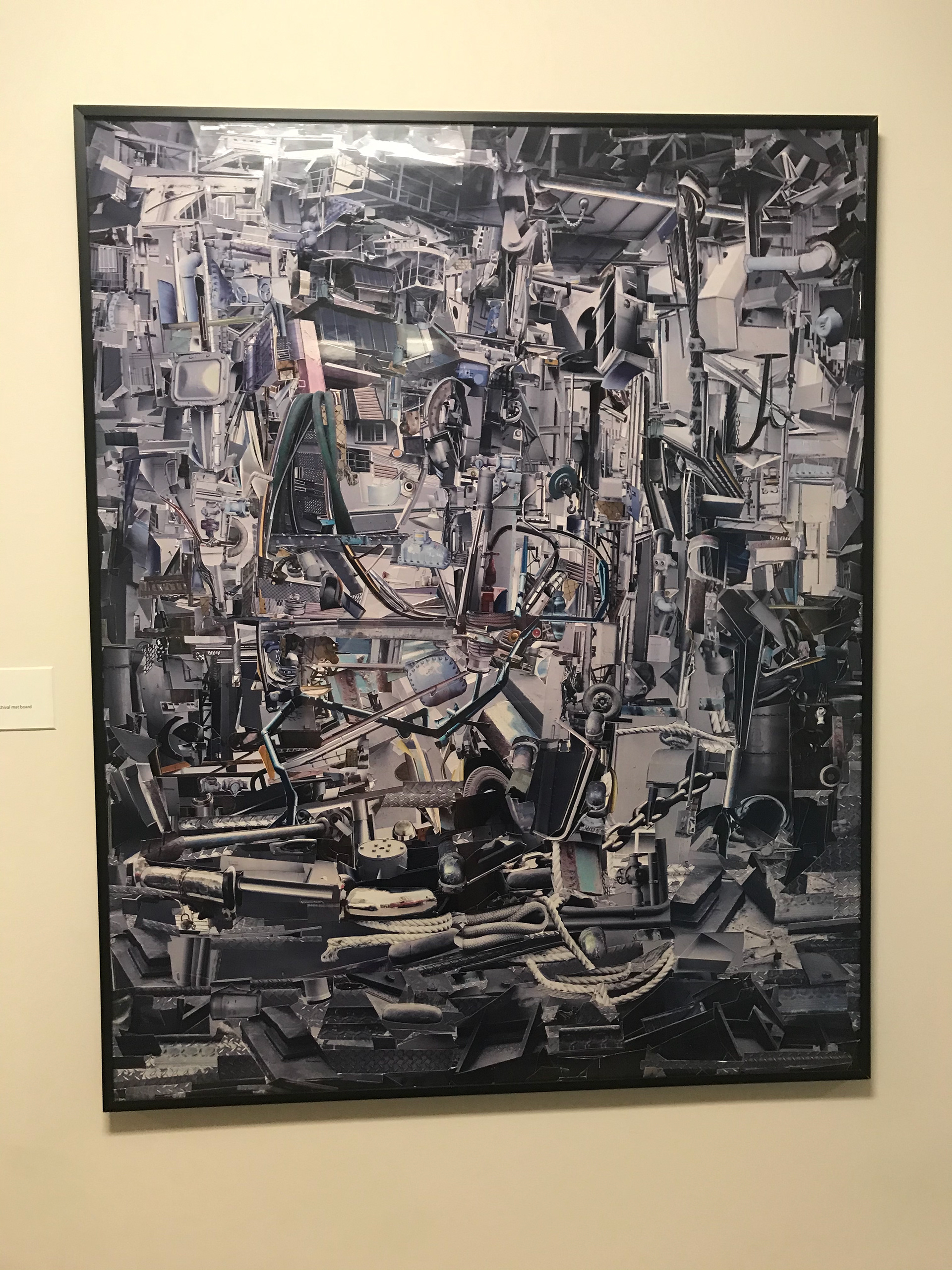
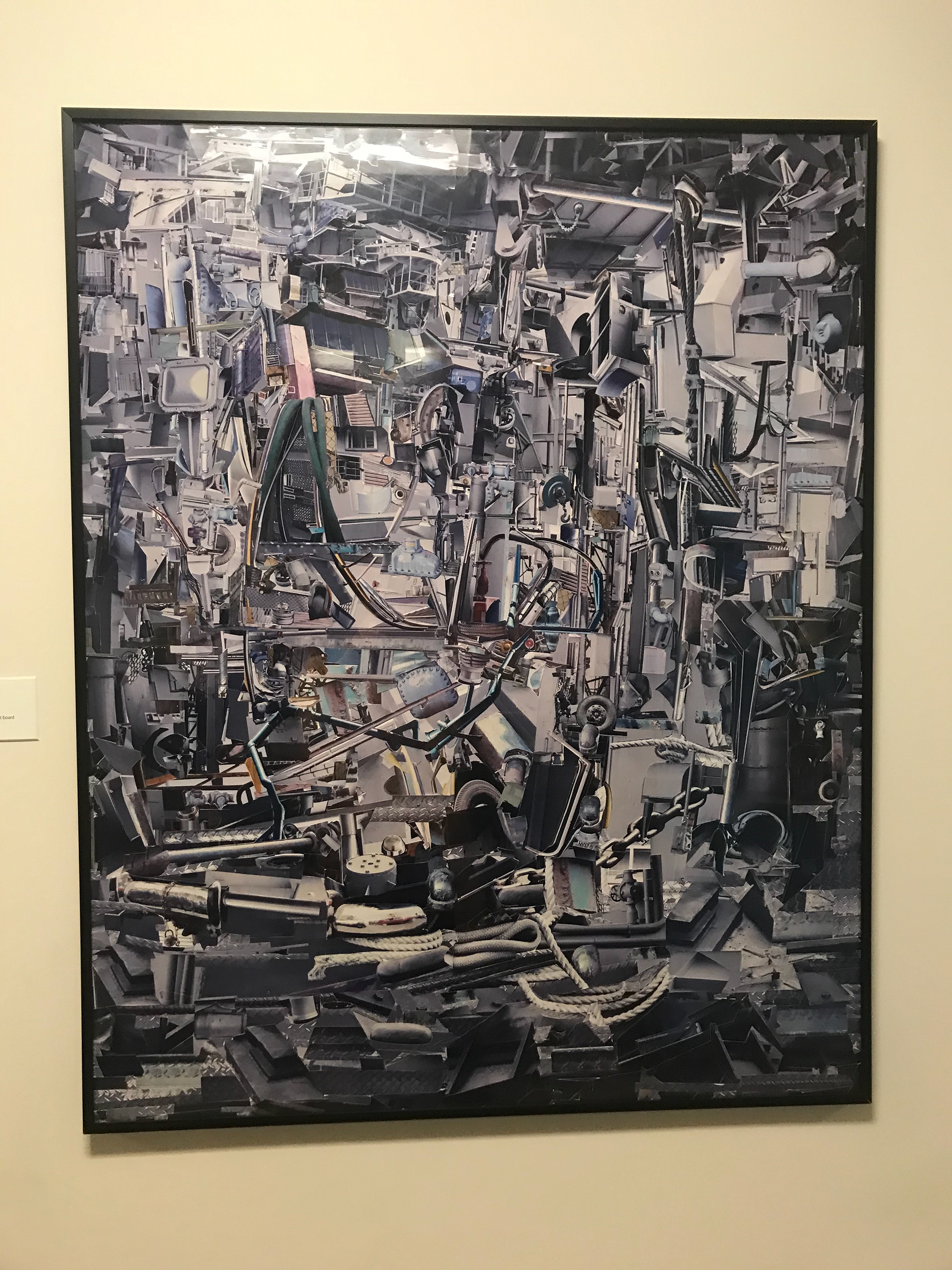
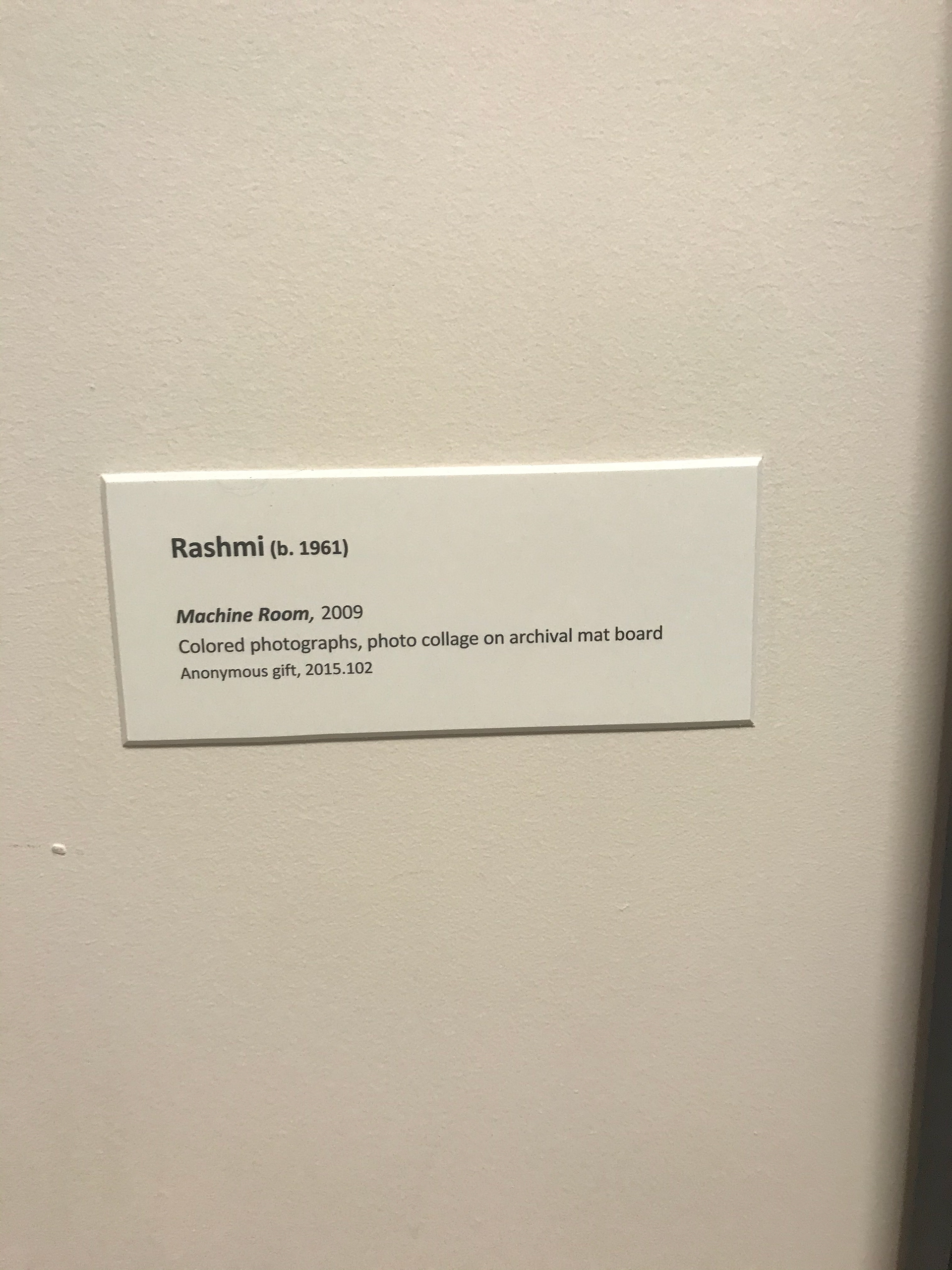
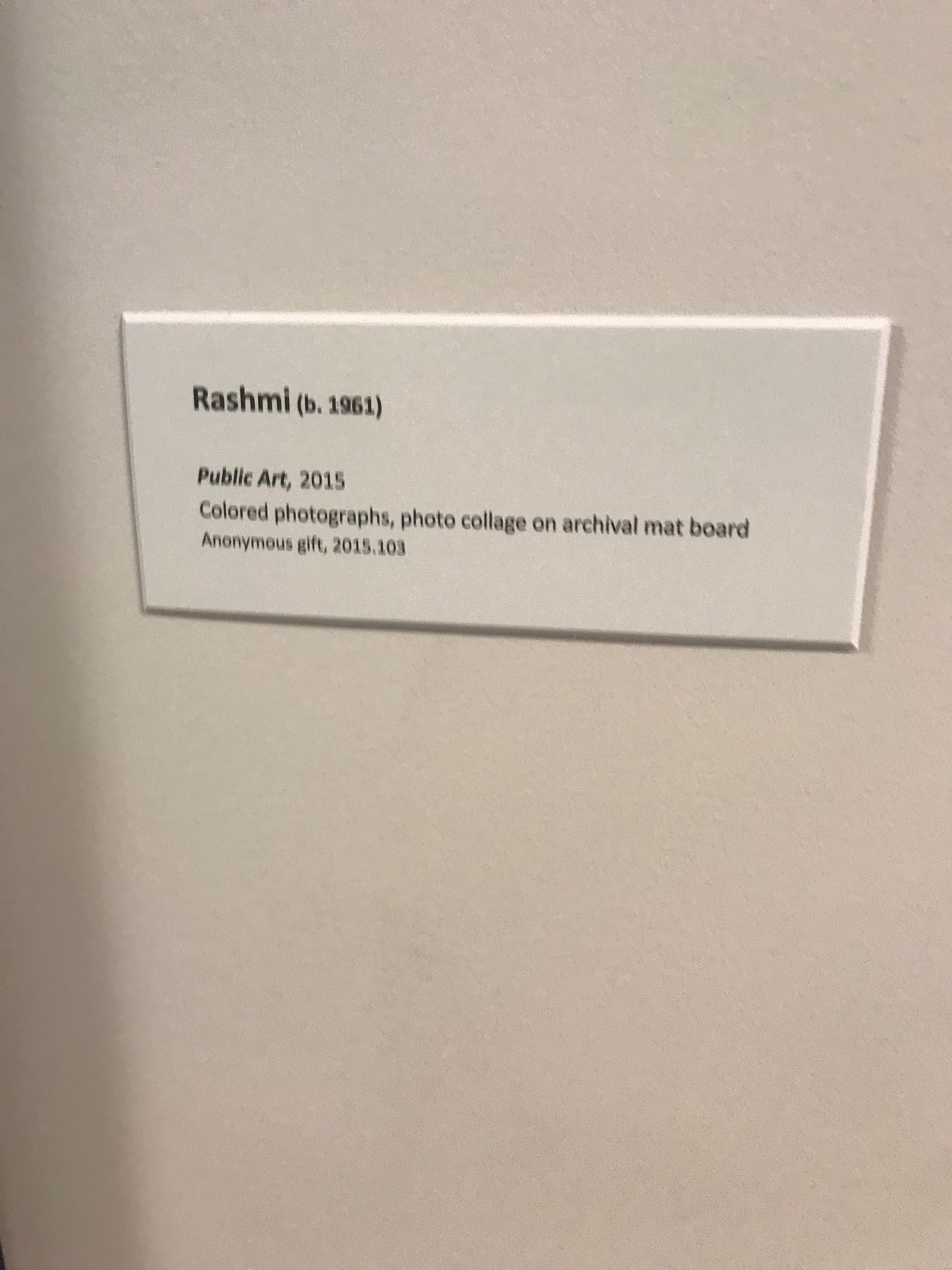
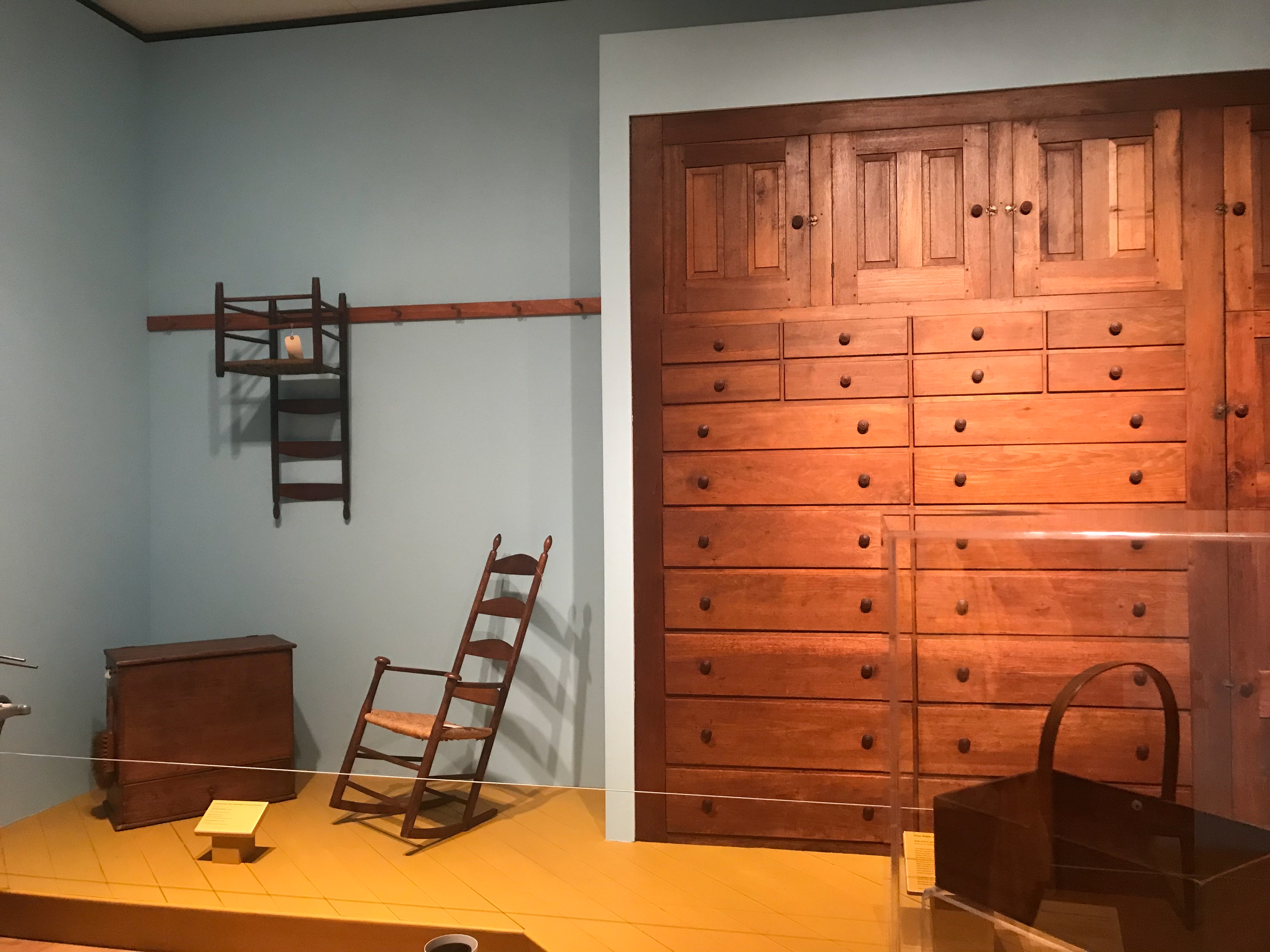
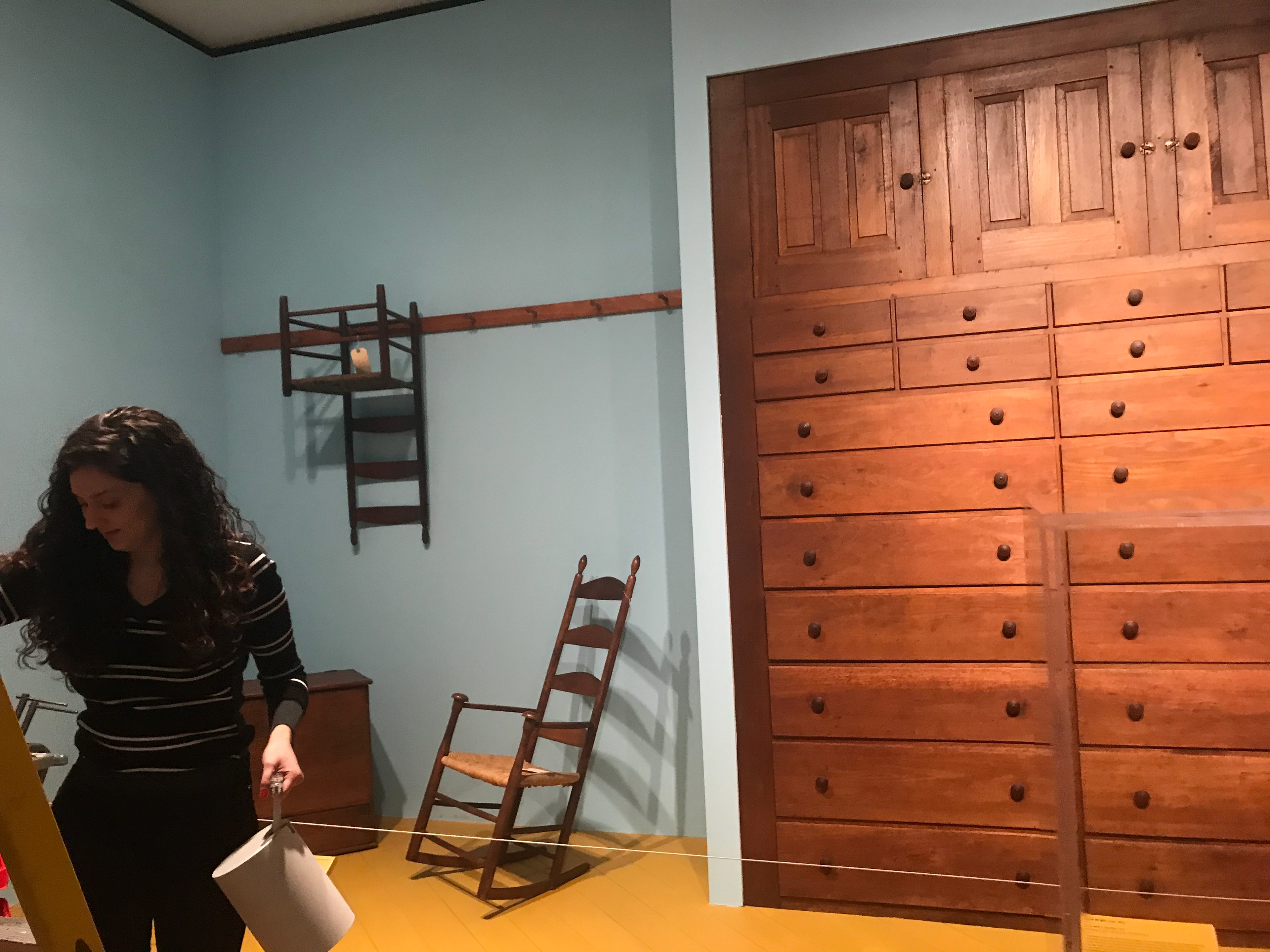
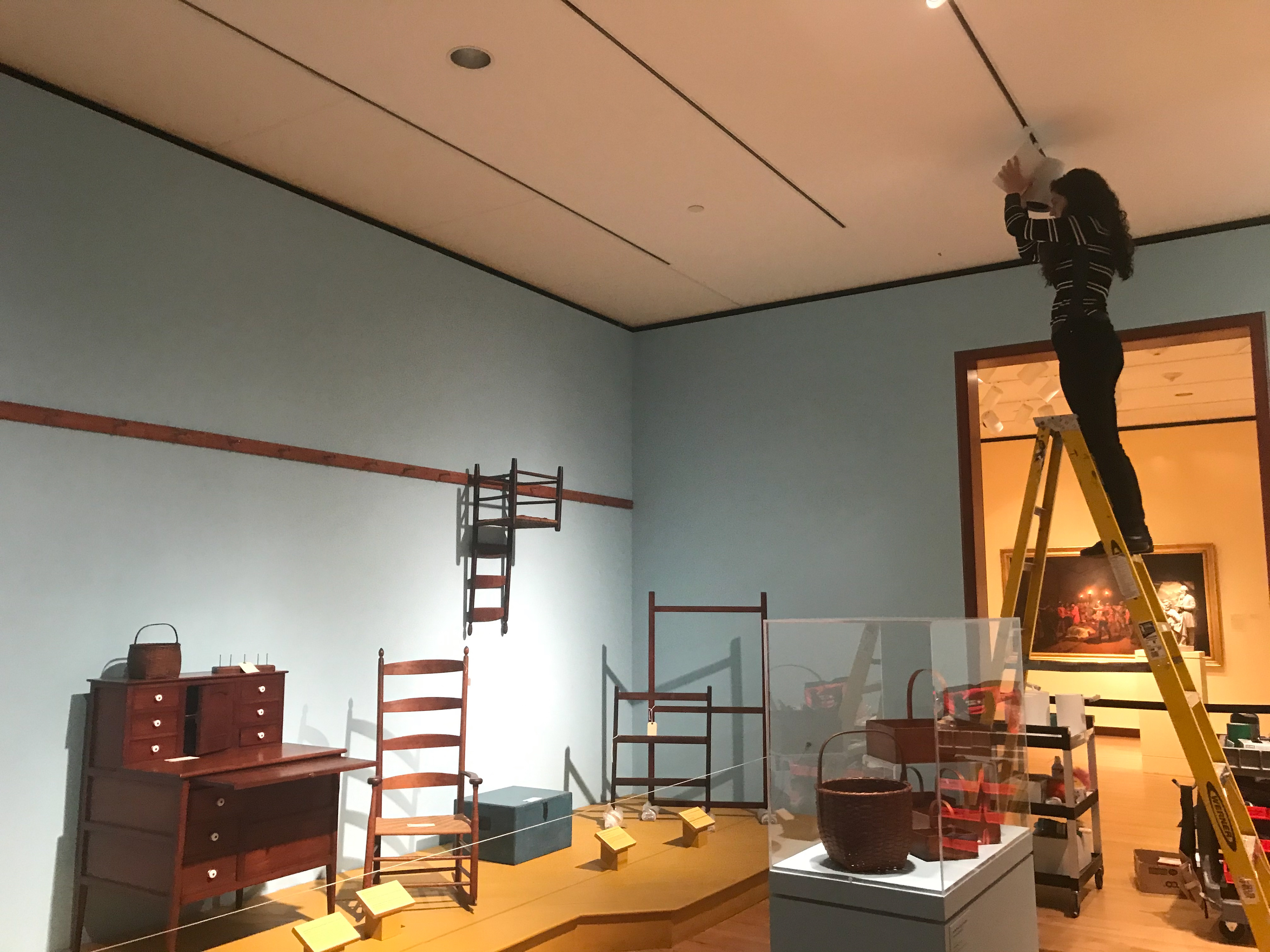
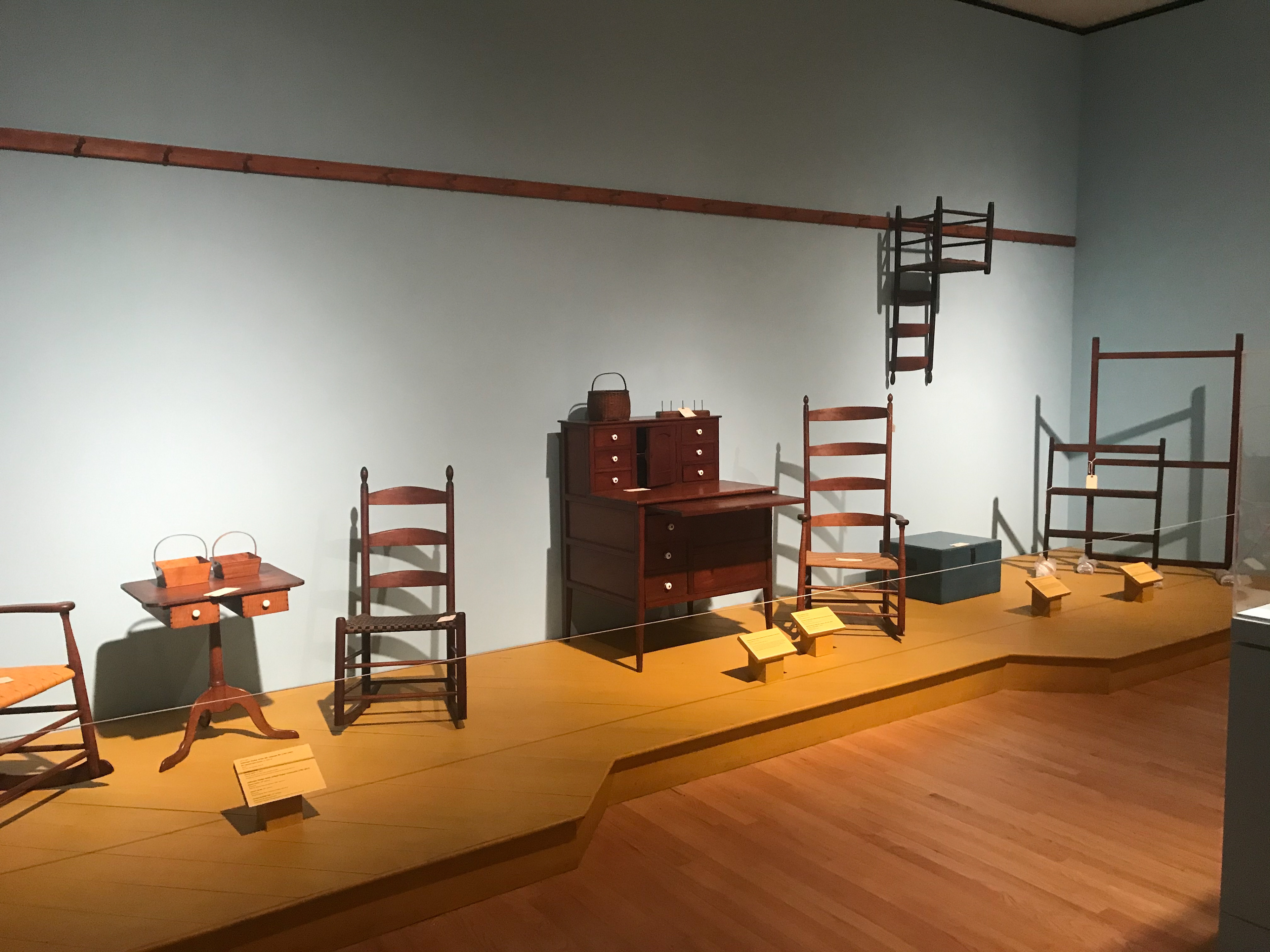

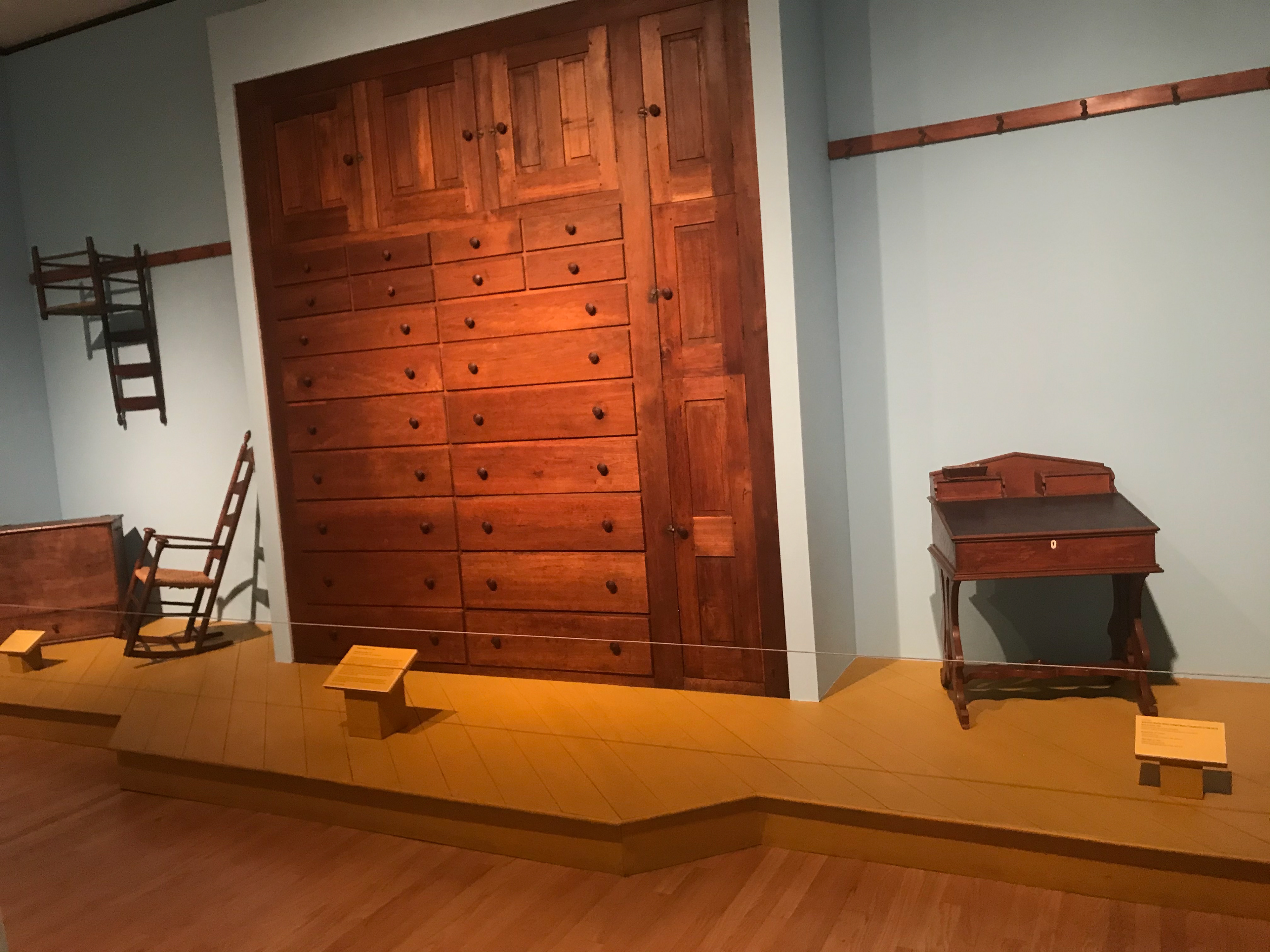
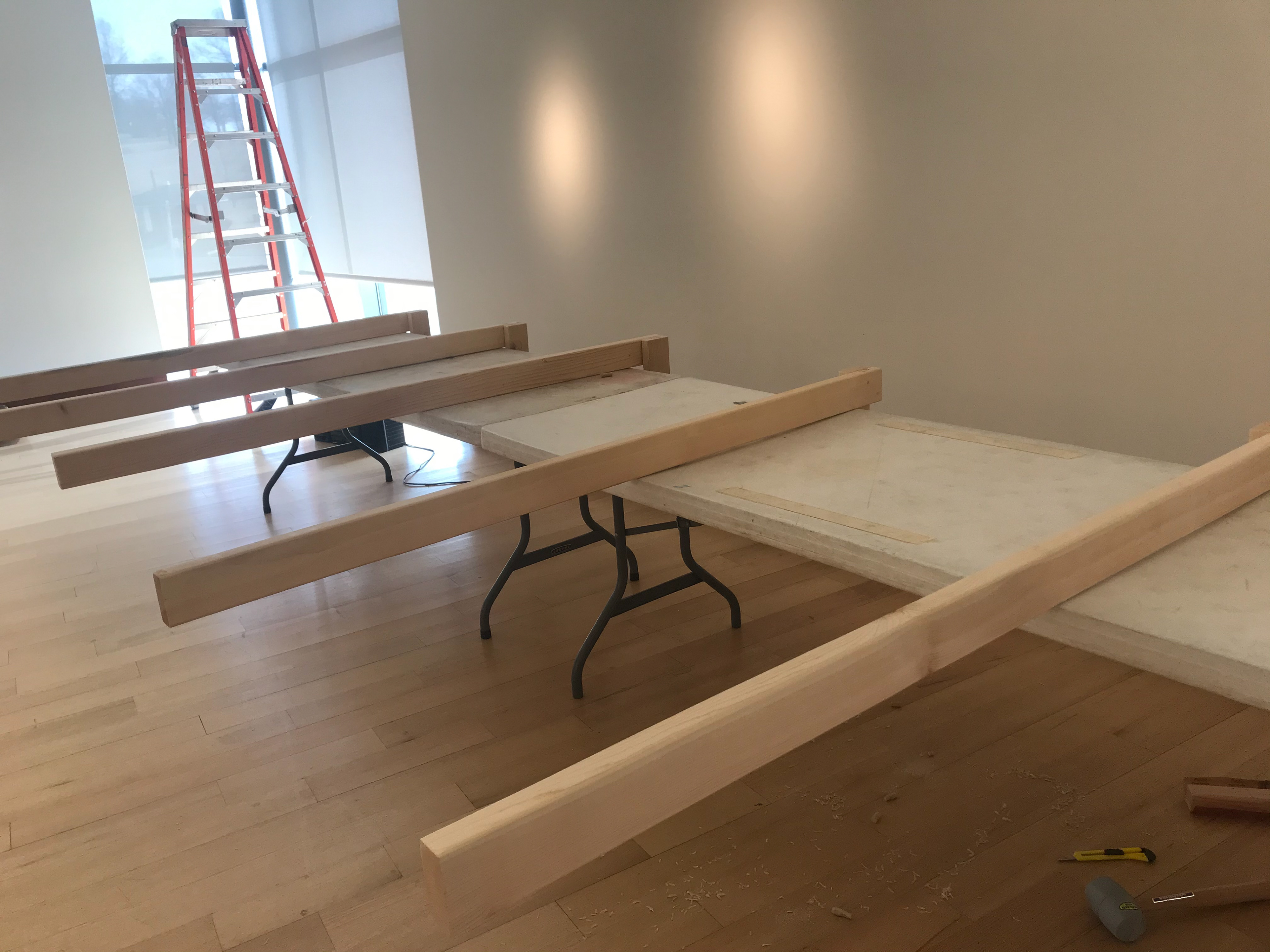
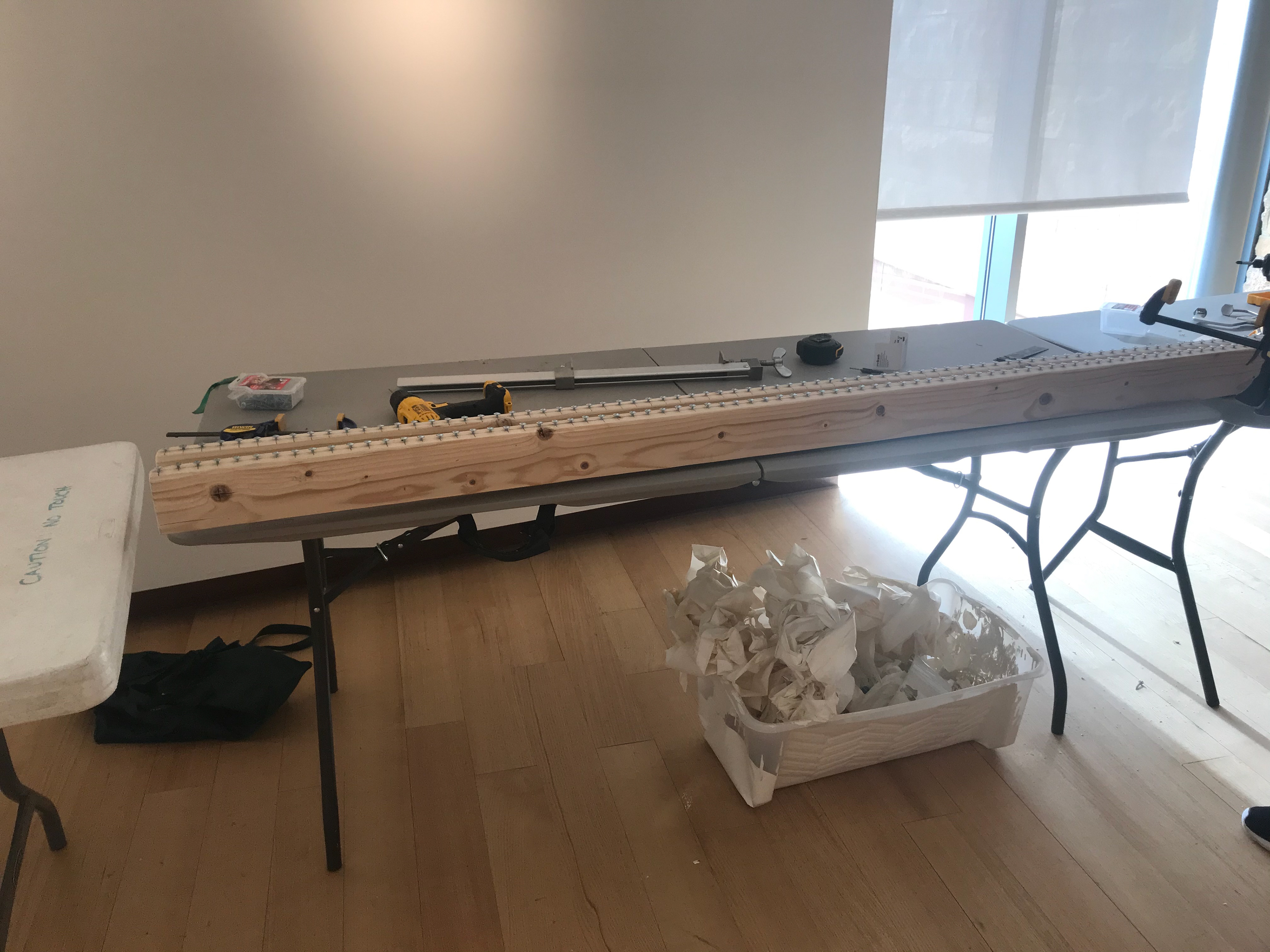
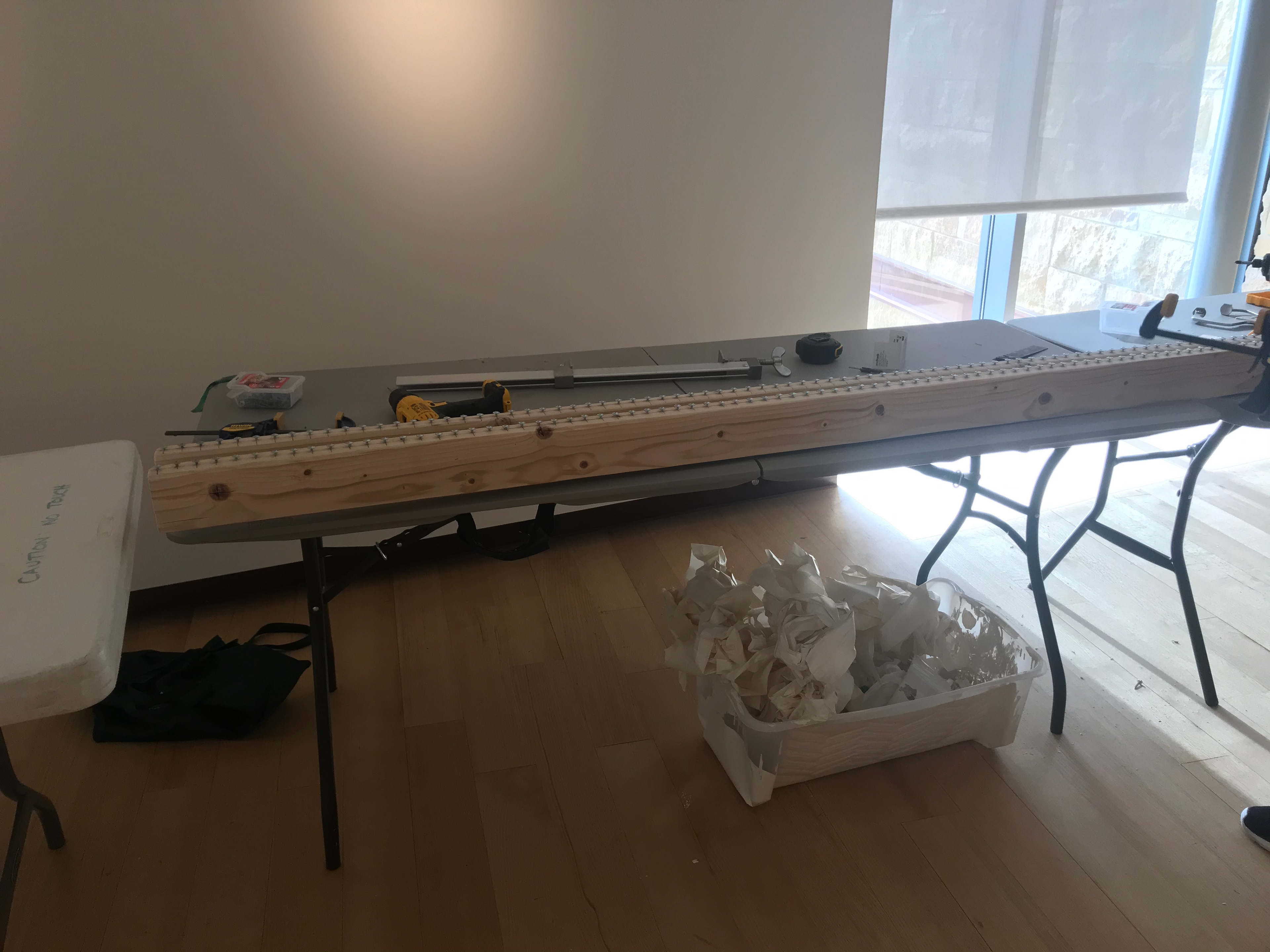
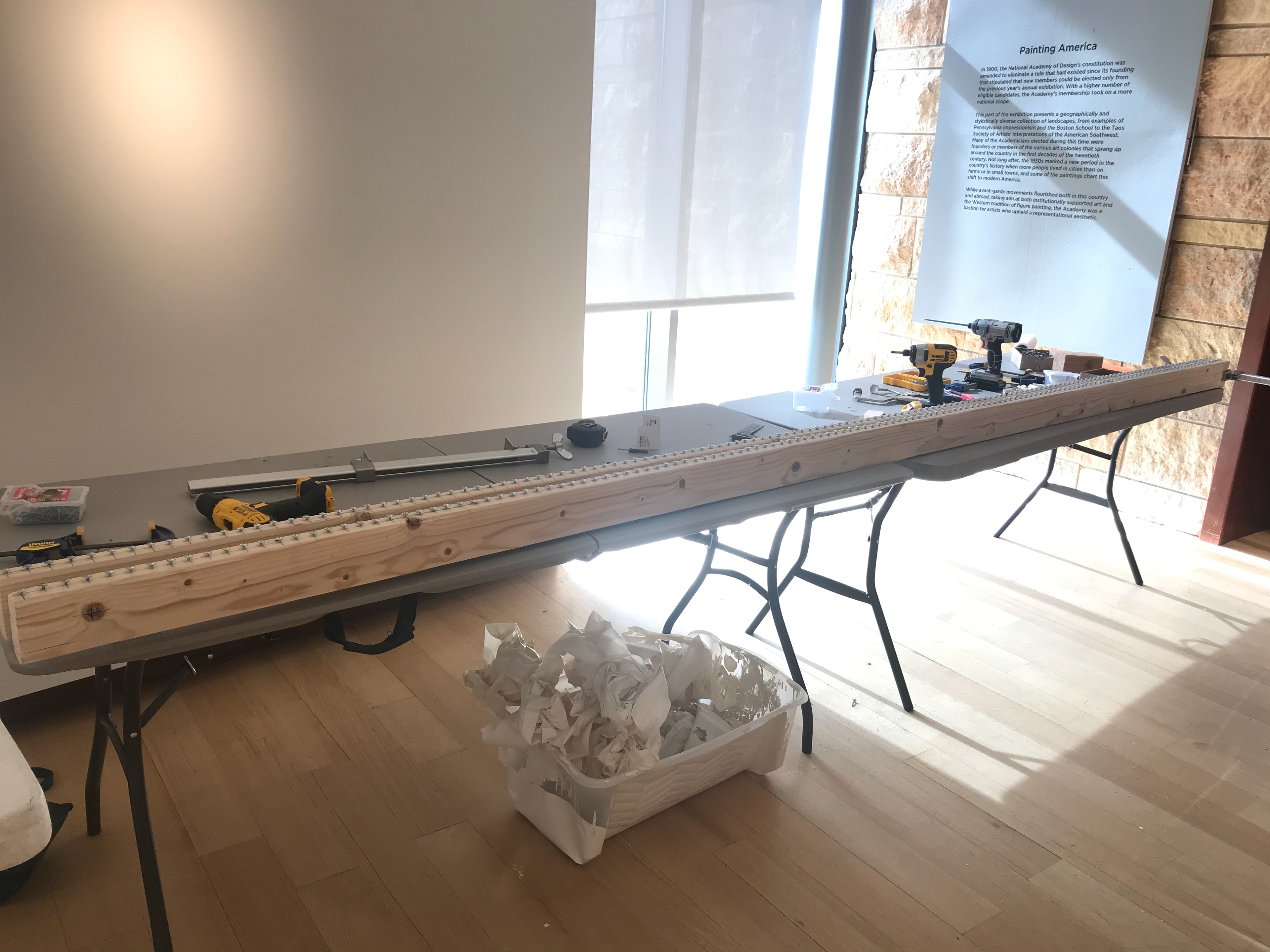
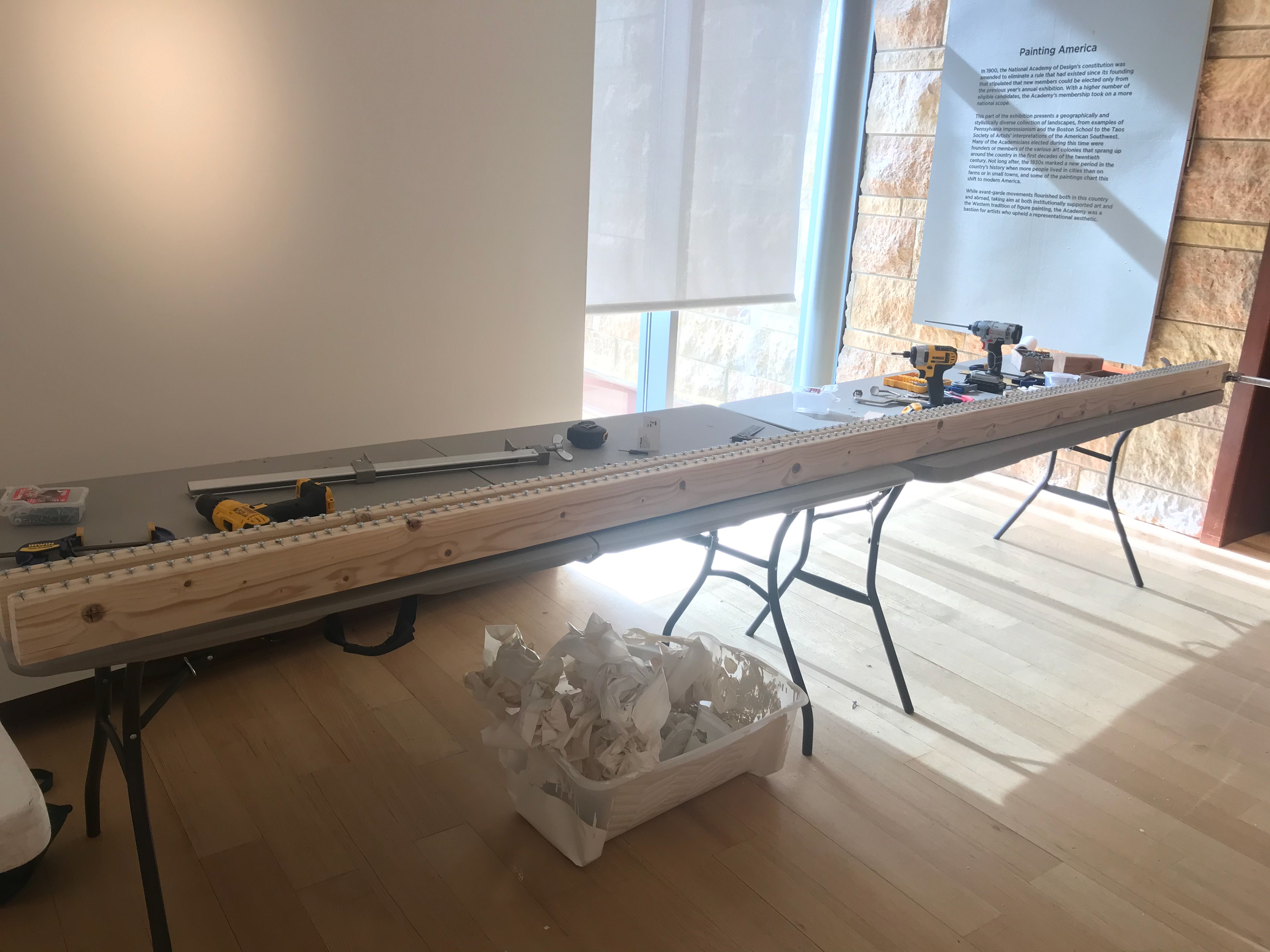
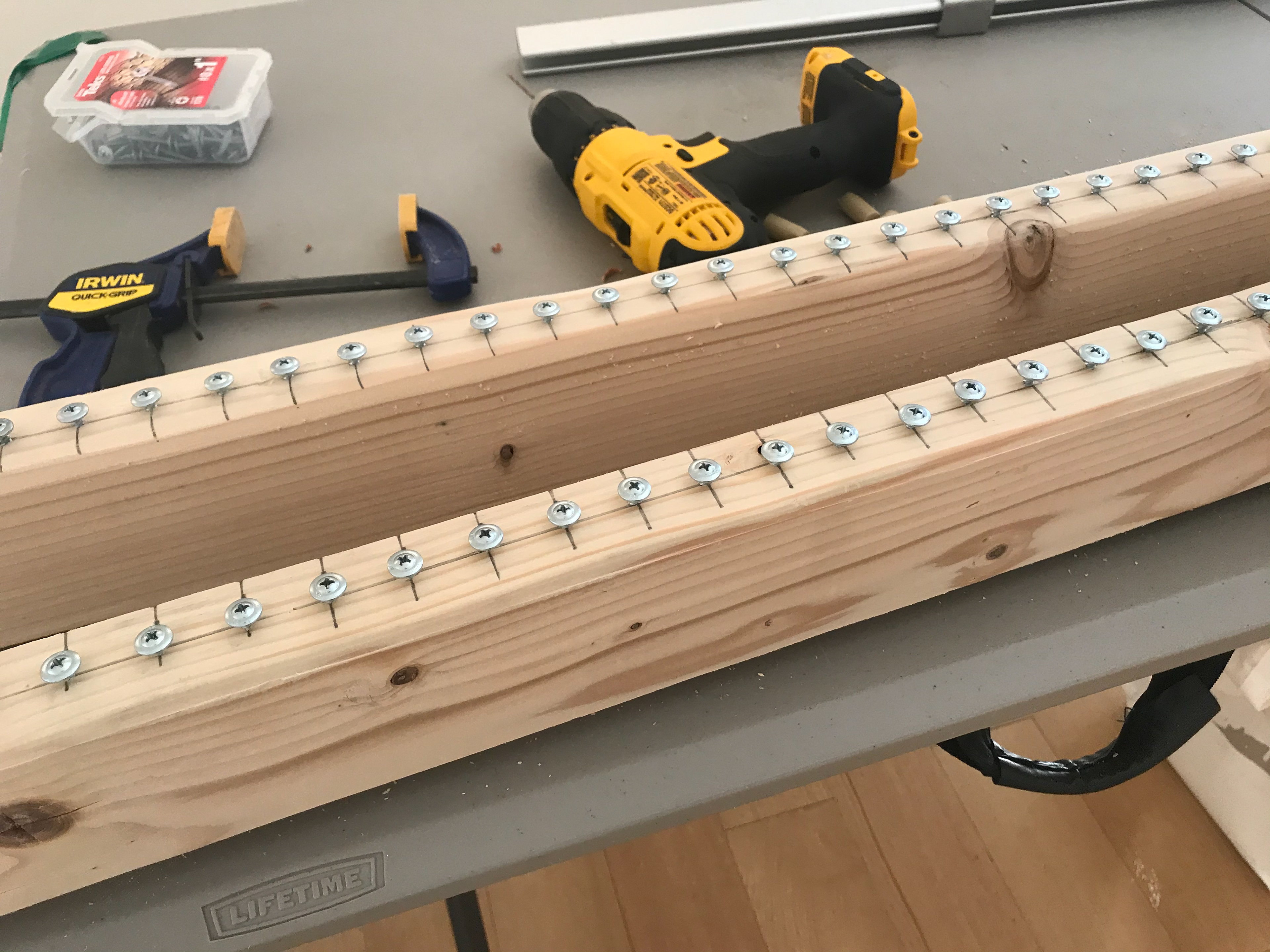
Journal: Week 5: 17-19 February 2020
What I did at the NBMAA…February 17th was Presidents’ Day so no one was at the museum. On February 19th we started by covering up The Cycle of Terror and Tragedy by Graydon Parrish with a wall. The piece needs to be covered for events with children and food. The wall will be up until around September. To prevent and damage to the piece they cover it with the wall. Then we went upstairs to install the weaving wall. The placement had to be approved by Lisa who had to first get approval via phone for Min and others involved in the Albers exhibits.
What I got out of reading American Encounters, chapter 6…Chapter 6 was about the Antebellum Period which lasted from 1828 until 1861. During this time the world began to speed up with the invention of steamboats and trains. There was a lot of tension caused by the widening gap between managers and workers and due to the slavery debate. The culture at the time was very sentimental meaning they valued honestly and simplicity, they were obsessed with death and the separation of the workplace from the home. Due to industrialization men began working outside of the home. The role of women was supporting the men and care for the children, they were tied to the home. However, some women pushed these boundaries and created art that we still talk about today. Lilly Martin Spencer was one of the only women invited to join the National Academy of Design in New York, however, she was not given voting rights. Her piece Domestic Happiness (1849) depicts a husband and wife cuddling while watching the children sleep, the wife’s gesture lets the viewer know that she has domestic control. At the time there was a large community of American Sculptures sending work out to Italy or living in Italy. Women were not allowed to do manual labor so they would sculpt out of clay or plaster and an Italian assistant would replicate the work in marble. One example is Beatrice Cenci (1856), by Harriet Hosmer. Hosmer depicts a woman who was wronged by a man. Beatrice was a young girl who was sentenced to death for meditating the murder of her father. A man who physically and sexually abused her and her mother and was physically abusing her brother. In Hosmer’s sculpture Beatrice is laying on a prison bench with her rosary. Edmonia Lewis was a half Chippewa, half black female sculptor. She attended Oberlin College which was the first college in the US to permit Native Americans, African Americans, and women in addition to white men. Lewis started creating in the US before making her way to Italy. She created The Old Indian Arrowmaker and His Daughter (1872) which illustrate an Indigenous man teaching his daughter how to create arrow heads. This piece shows hope for the future which I think reveals great strength during such a hard time for the Native Americans. American Woman's Home by Catherine E. Beecher and Harriet Beecher Stowe is a book about how to decorate a gothic styled home. One example of a craft in the book is creating picture frames out of twigs because bringing the outside in creates fish air and provides children with a love for nature. Quilting was a very popular activity among women. Sarah Johnson was only 14 when she created Stars and Pinwheel Medallion Quilt. This was her fourth guilt which was not uncommon because girls were taught to be master seamstresses by age 4 or 5. Mary Simon managed to start a business through guilting. She would sell quilt block to wealthy women who would sew them together and claim the work as their own. Friendship quilts and social awareness quilts were created by groups of women. Friendship quilts were given as gifts to friends whereas social awareness quilts were used to raise money and awareness to issues. Many were sold at anti-slavery fairs. Shaker culture at the time had different ideas from the rest of the country. The Shakers, founded by Mother Ann Lee didn't believe in slavery, private property, or male dominance. Actually, the first circular saw was invented by a Shaker woman, Tabitha Babbitt.
Journal: Week 6: 24-26 February 2020
What I did at the NBMAA…I started my day on February 24th by taking more photos of the Create Space for the marketing department. Visitors have created more tiles and notes since I last took photos, so they wanted more before it was taken down. Once photos where done I aided in breaking down the spaces. This involved boxing all of the creations to be stored, moving all the tables and chairs to their rightful locations, and removing the vinyl from the walls. Afterwards, we removed the walls, first by removing the toe-kicks. These are held to the base of the walls with velcro, so I just had to peel them off. We then began removing the walls. We could move them around the room on the pallet-jack, however they can’t fit in the elevator upright. My job when we move walls is called footing, this means I go on the opposite side that the wall is being lifted and I push with all my strength to keep it from sliding. We begin flipping the wall by laying it flat on a pedestal and then Mike and Keith lift the wall again so Gabby can remove the pedestal and it is set down on the pallet-jack. Next, Mike and Keith flip the wall on to its side while I foot. Lastly, a board is adhered to the wall to serve as a handle for the guys to lift the wall while I place a dolly underneath. We are then able to wheel it downstairs. Once we removed the walls, we had a meeting with Min to discuss The Year of Women. When you walk into the museum the first room will feature portraits of female artists like Carrie Mae Weems, Yoko Ono and many more. These portraits will replace the colonial portraits. On February 26th, since all the colonial portraits were removed, we needed room to store them. Gabby and I started by looking for gaps in the racks to store artworks and marking them with sticky notes. We then moved more walls from the upstairs gallery, which took up most of our day. In between removing walls, I got to practice condition report with Gabby.
What I got out of reading MRM5: Section 3: The Basics I, II, and III: Hypotheticals… In museums objects sort of collect in storage, some are old and unnecessary to the collection, some have been abandoned, and some are completely unknown. The term “old loans” refer to loans that expire but their owners are unable to be found so the object must remain in storage. It can be very difficult to return these loans, so some states allow conversion. Conversion means that after a certain period of time a museum can claim ownership of old loans. To avoid accumulating old loans, museums should maintain records of the lenders name, address and phone number, the description of the object, and the beginning and end dates of the loans. They should update these records frequently. Museums must have good deaccession policy. A museum can deaccession an object if it: is not within mission, cannot be maintained, is not useful to them, is duplicate of another collect, or has acquired illegally. The process of deaccessioning is: written justification legal verification, physical examination, getting an outside opinion of value, internal review, board approval, and notifying the donors. FIC objects or found in collection are objects that are missing accession numbers and records whereas undocumented objects are objects without accession numbers that are similar to other objects. If FIC objects are claimed by an heir the museum may return it if case is strong but they will deny the request in writing if it’s weak. Both FIC and undocumented objects will receive a number as if they are owned by the museum except the number will indicate if they are undocumented. When loan requests are submitted to a museum they must include: the title of the exhibition and purpose for loan, the length the loan period, the location and exhibition dates. In order for an outgoing loan to be approved, the curator must evaluate the object, followed by the conservator or registrar examines object, next the registrar checks for other commitments, and then of course it needs approval by director or board. The packing and shipping loans is mutually agreed on by both the borrower and the lender. When a loan is received the unboxing must be photographed for damages and so it can be repacked the same and the original box should be kept in a safe place. Then, object inventoried, a condition report completed, the lender notified and damage of missing parts, the object is labeled and installed and handled to lenders specifications and lastly, the loan is documented. When a loan is returned a condition report should be done immediately. If damage is found the borrower and insurance should be notified. Travel exhibitions have many requirements and restrictions include but not limited to lighting, climate, security, shipping, and photography. Often a courier is required to travel with the work and watch the unboxing. A checklist, a packing list and instructions, crate list, list of equipment needed to receive and install objects, a list of display furniture, mounts and graphics also travel with the shows. In addition to, the list of lenders specific requirements, a certificate of insurance, indemnity documents if appropriate, and a condition report notebook. Before a travel show is approved there must be a preliminary checklist and budget. This checklist includes accession number, artists, titles, object dates, medium or materials, dimensions, and credit lines. For an in-house exhibition the file must include: budget, checklist, conservation info, installation notes, label copy, lenders list, loan agreements, packing and shipping info, photographic material and security notes. Installation of shows requires that all the objects arrive on site at least 3 weeks before the opening. Gallery floor plan maps should be drawn out to out work placement of the artworks before they are placed. Before the reception security and object safety should be reviewed with museum staff.
What I got out of reading Miller, American Encounters, chapter 7… The plains Indians used a visual language to tell stories of their hunts. A good example of this is Crow shields. These shields were designed by the Crow Warriors and they depict their visions, only the one who had the vision can use the shield. Their clothing would also show their hunts. George Caitlin profited off documenting the Natives. His goal was to “capture a dying race”. After Caitlin painted Portrait of Mah-to-toh-pa, "Four Bears", Second Chief, in Full Dress, the natives were impressed by how realistic the painting was. Caitlin created an “Indian Gallery” with 422 painting from 48 different tribes. His collection of work documented the customs and ceremonial life of the Natives. His work showed how everyday life on the plains was for them. Caitlin’s collection included tipis, painted robes, headdresses, medicine bags, war clubs, and pipes in addition to paintings. Today, Natives are able to reference Caitlin’s paintings to replicate traditional, ceremonial dress. Caitlin was cruel but also somewhat helped the natives. He was a horrible person who didn’t care about the Natives at all, he just wanted to make money and gain fame from original work. However, he kept an account of the culture that they wouldn’t otherwise have. Though the Natives had specific tasked that differed for men and women, they were considered equal, and both could reach high power and prestige. The natives believed in balance and this definitely comes across in women’s art which was typically very geometric. Quillwork was a popular medium. It was completed using porcupine quills. The Lakota believe that guilt work was delivered to them in a dream where a girl was visited by Double Woman (supernatural being) who taught her how to use the quills to create. By the late eighteenth century beads became widely desired by the Plains and Crows. They would trade a horse for only 100 beads. Beadwork came to replace quillwork because beads were easier to work with. They were easily seen on to fabric for ornamentation. Some Natives benefited from trading but many just caught disease that wiped out whole tribes. In Alaska, the Eskimo tribes prefer more specific classification like Yupik or Inupiaq. The Tlingit had a pictorial style that was influenced by their Haida and Tsimshian neighbors in Canada. The Tlingit loved cedar as a material. “Potlatches” were give-away ceremonies were art was gifted. The Box of Daylight Raven Hat, by a member of Tlingit Culture created in Taku Village, Southeastern Alaska depicts a myth of a chief that would hoard sunlight in a box causing the world to live in constant twilight before Raven, a hero stole the box and released the sunlight for the world. Whalers learned a lot about survival from the natives. Native women actually created cloaks for whalers to keep warm. Natives helped the Anglo-saxons that mostly brought them harm.
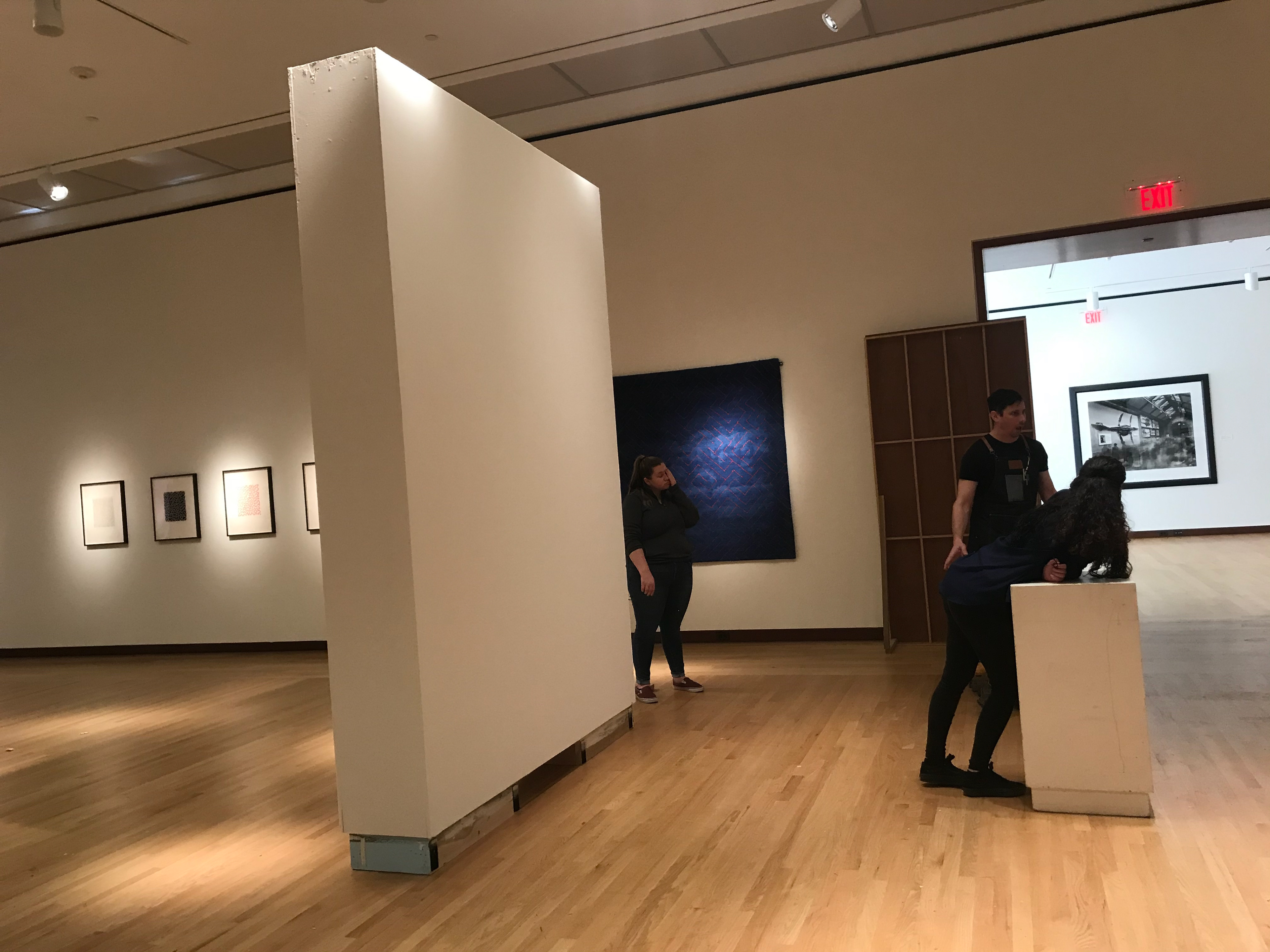
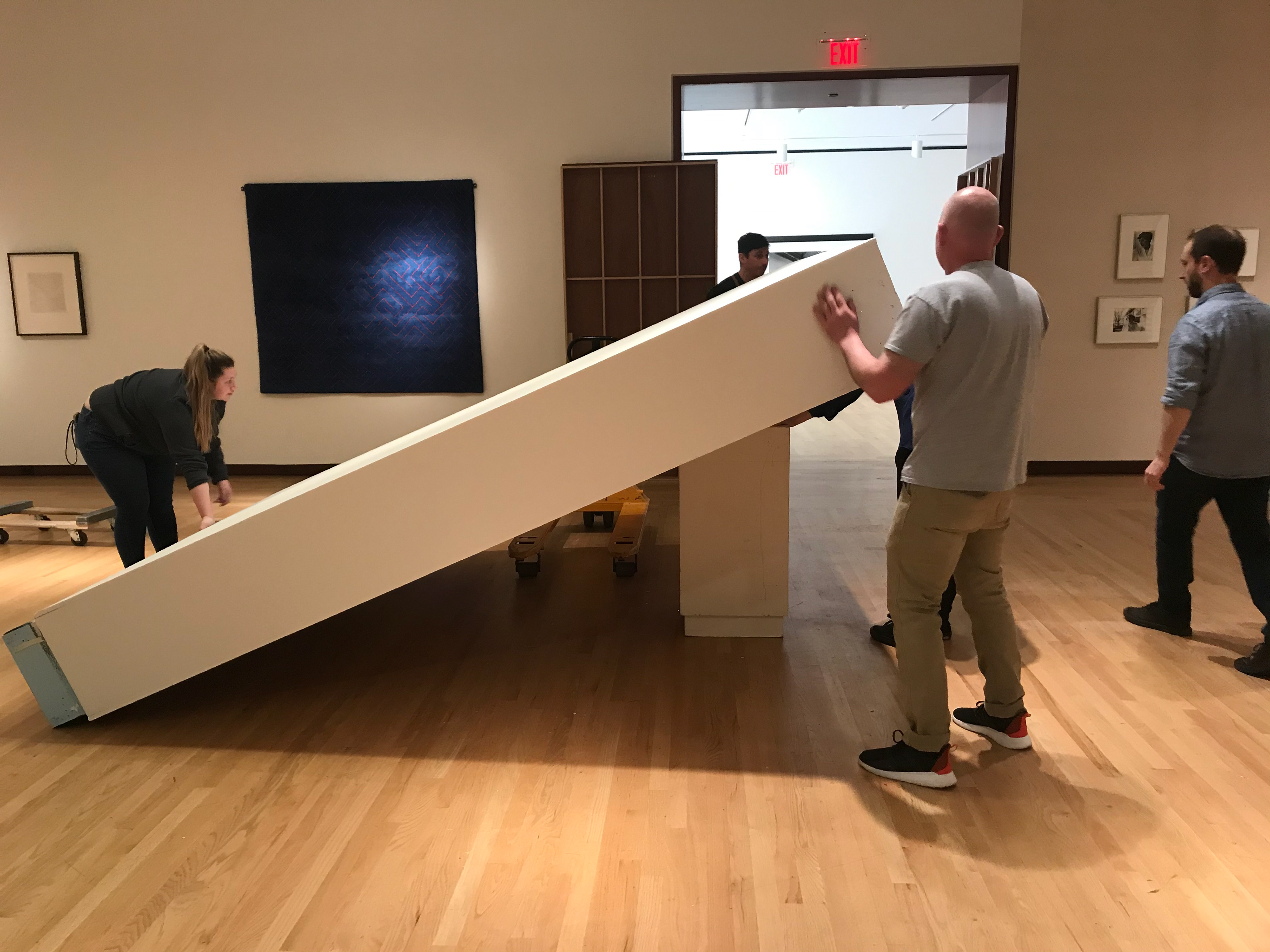
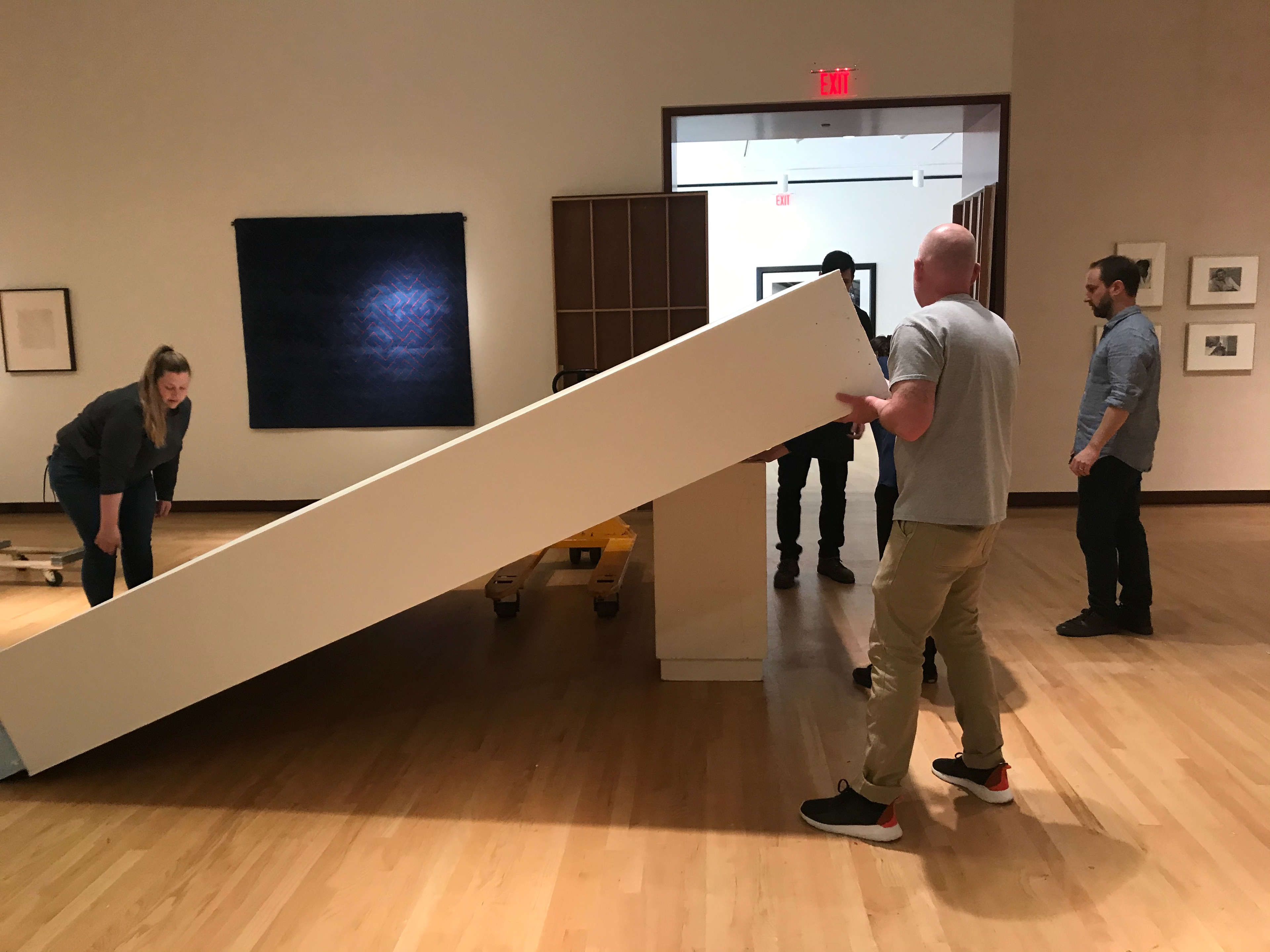
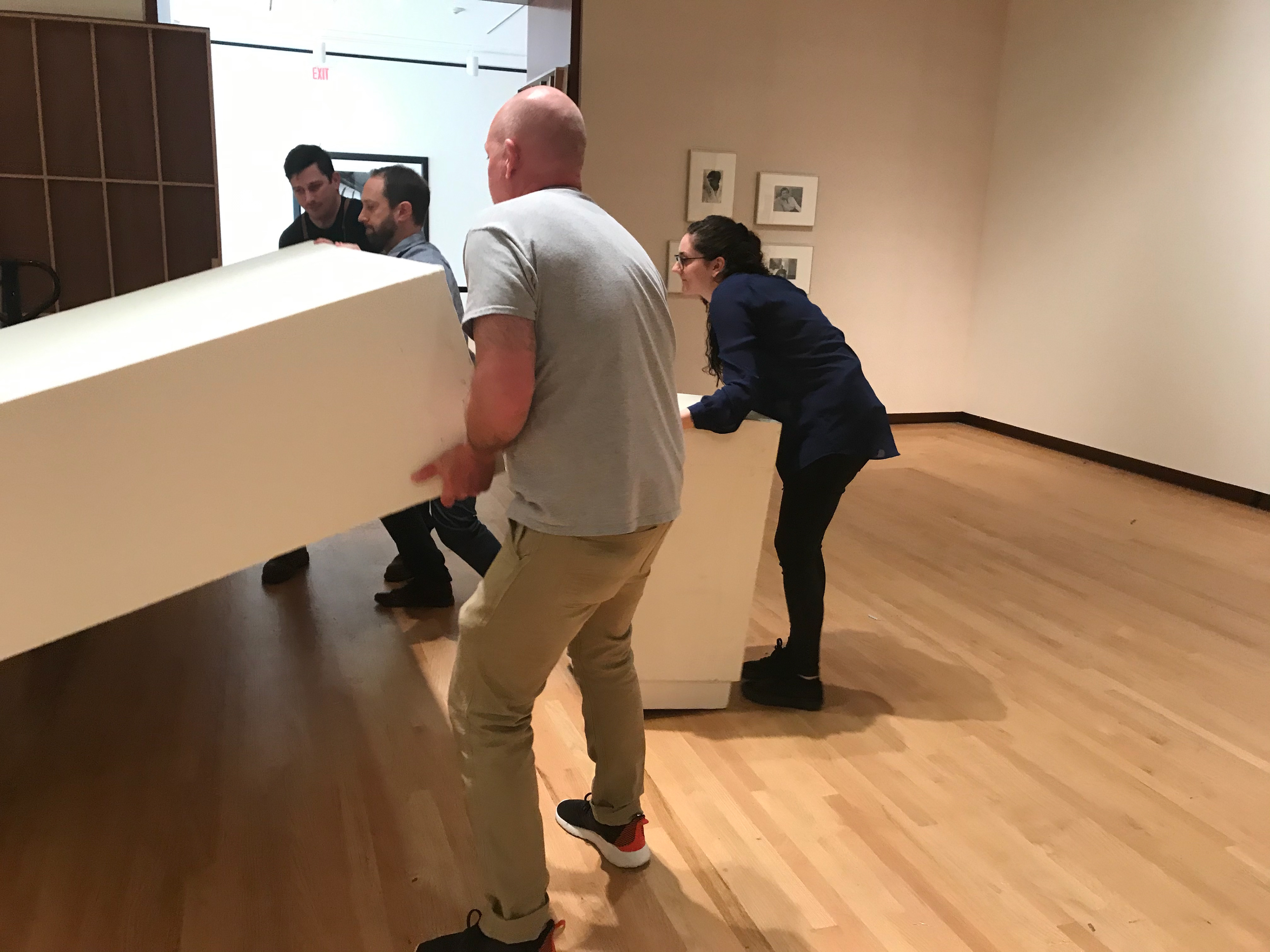

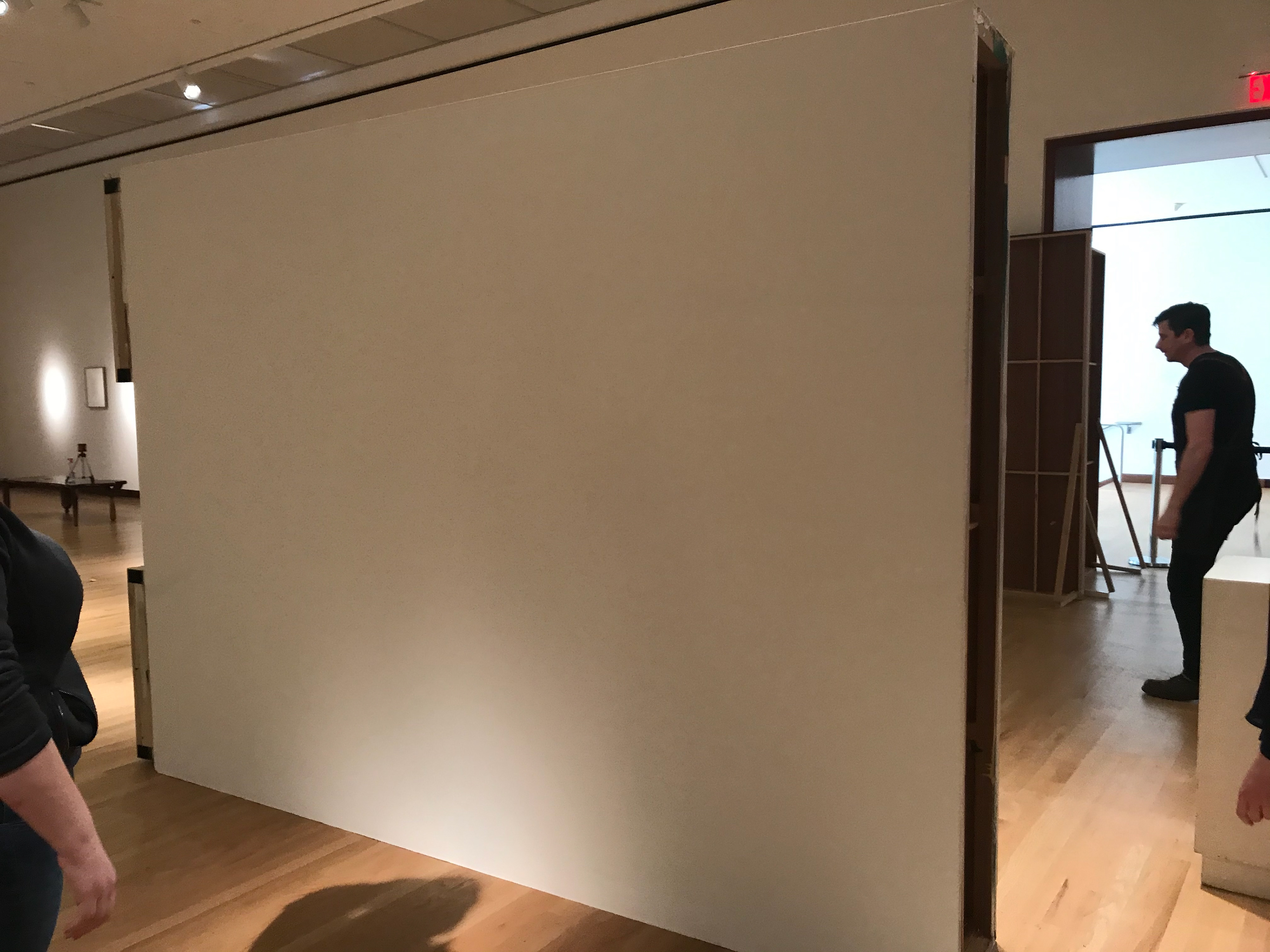
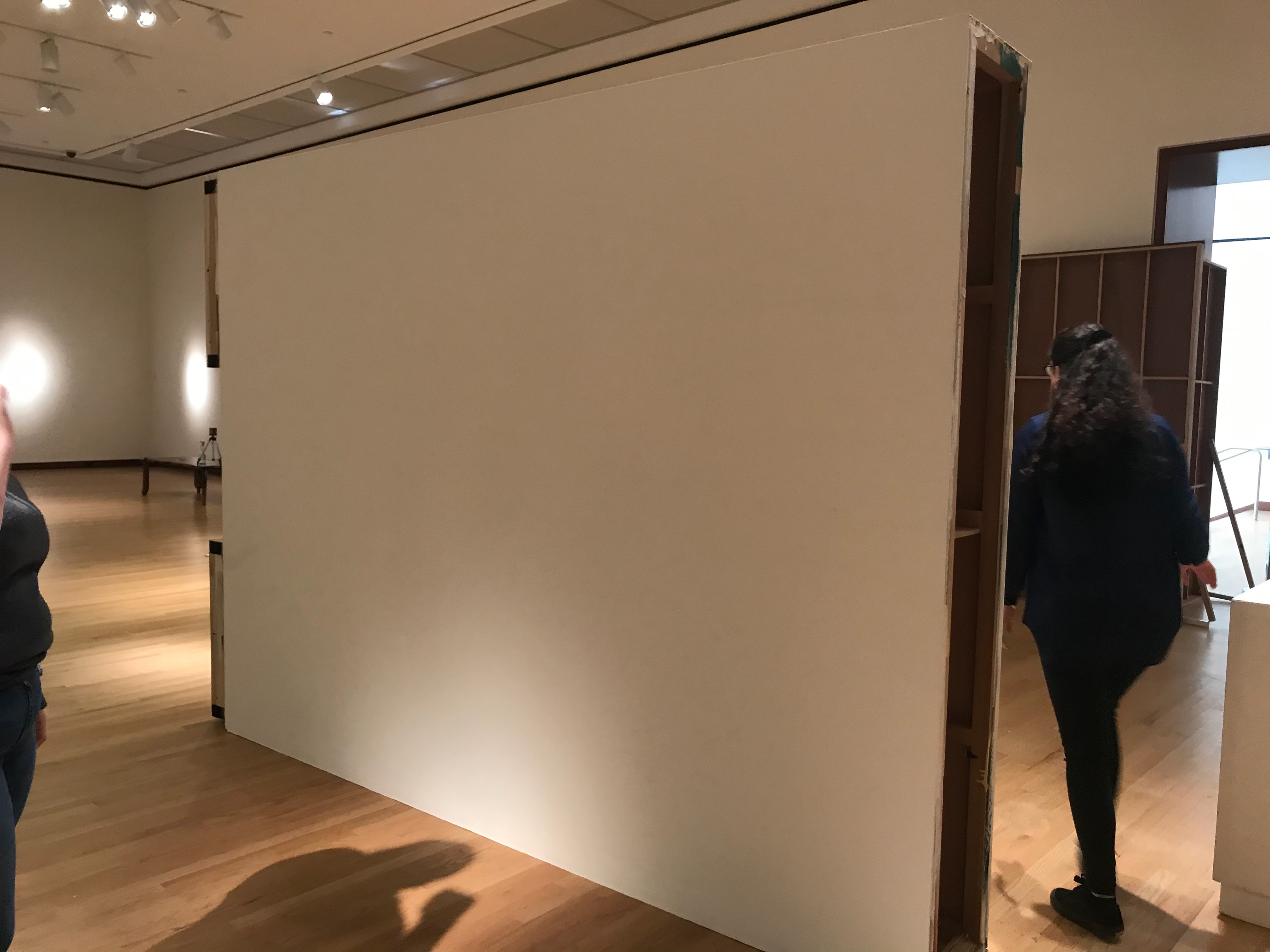
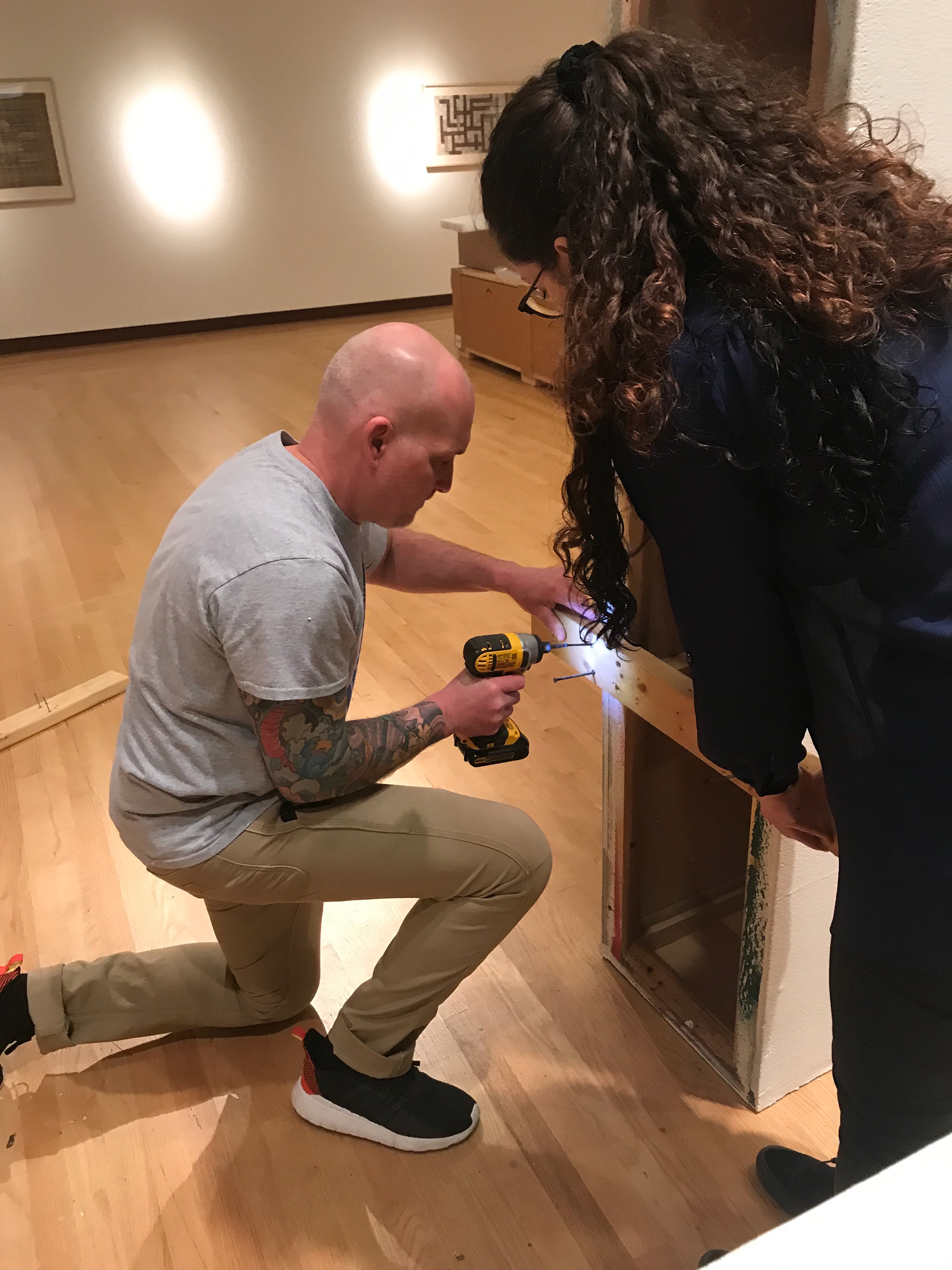
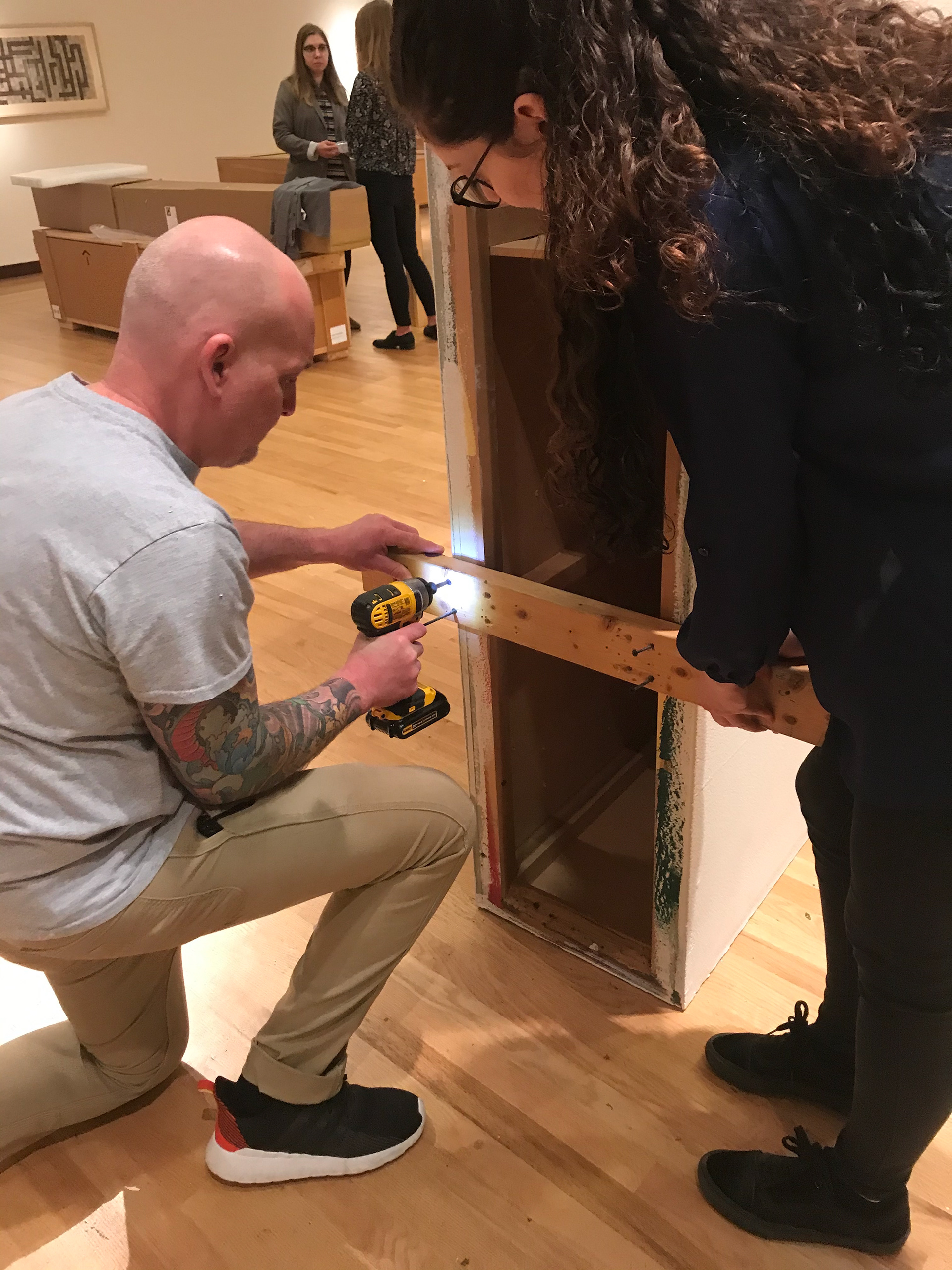
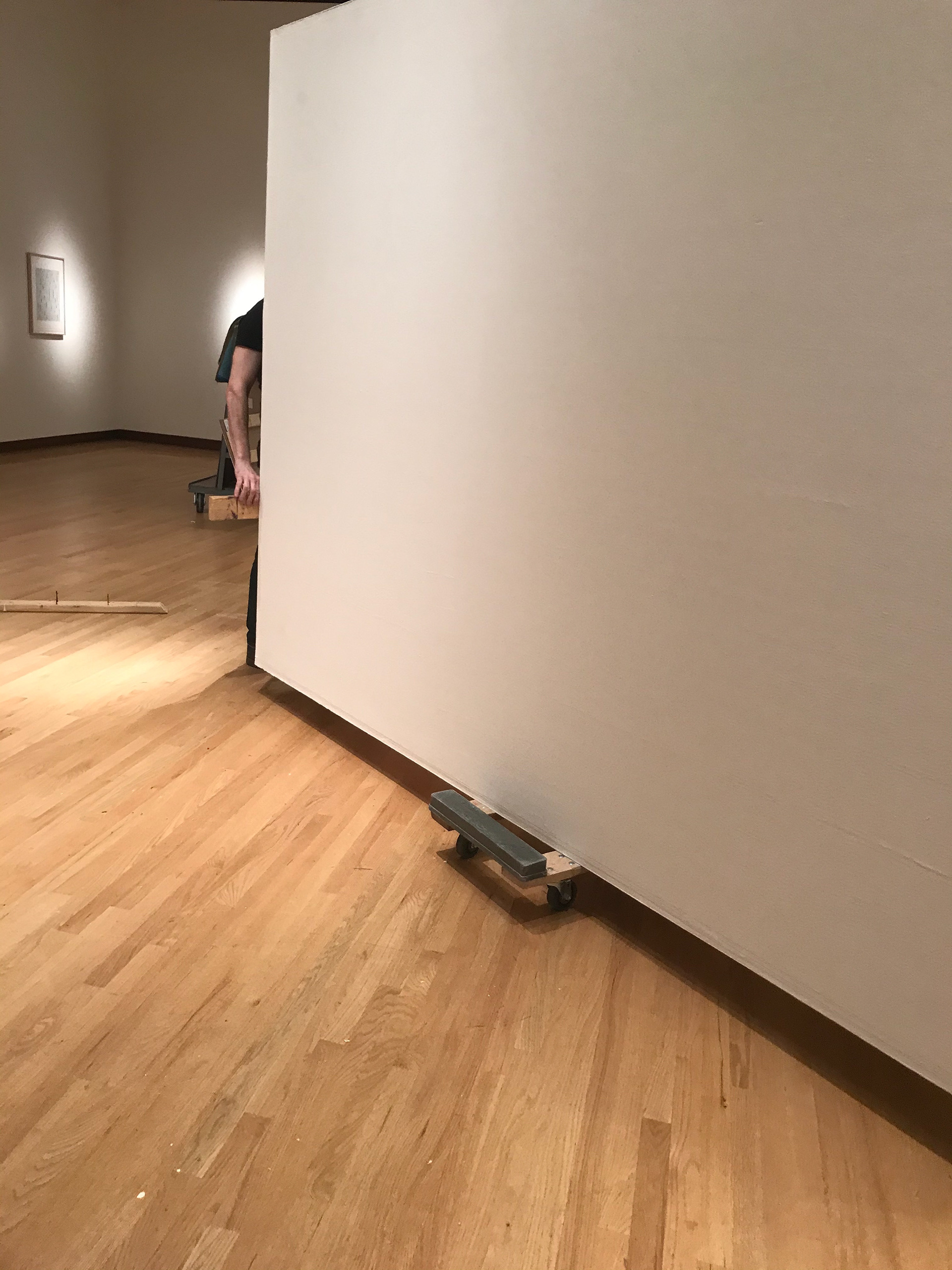
Journal: Week 7: 2-4 March 2020
What I did at the NBMAA…When I arrived at the museum on March 2nd, I was immediately put to work painting the front gallery. It was painted completely white to have a clean look behind the women artist portraits which Mike drove to Vermont to pick up. By the time I finished painting, I had an hour left so I went upstairs to meet Fritz, the curator from the Anni Albers Foundation and Sam, the collections manager. I watched Fritz and Gabby complete a condition report, marking down every wrinkle in the tapestries. The tapestries were both stored and mounted in archival acrylic tubes to minimize wrinkling. After this I was asked to do some weaving on the wall. On March 4th, I completed gallery maintenance, with the stress of installing Anni Albers, it had not been completed for some time. It took me an hour to complete the entire museum. I then went to find Keith and Gabby with Bob, installing the vinyl in the freshly painted room. They instructed me to find Mike who tested my box making skills, first having me create a box to hold wood scraps and then a box to fit another box. Then I painted a wooden board white for Keith. After that, I went to watch the installment of Anni Albers. The way Fritz hangs are different from him traveling exhibits are normally done. He unpackages all the artwork and lays are out so he can move it around before its hung, this is normally not allowed but luckily it is his decision. Gabby said Fritz’s way is the best way, normally they need to use cardboard in place of art to get an idea for sizing. It is sad reliving what it was like in the outside world, art was so pretty in person, those were the days. The museum is now closed due to Covid-19.
What I got out of reading Miller, American Encounters, chapter 8…Chapter 8 was about nature. Coming from England, the Americas was whiles and miles of nature, untouched by man. The anglo-saxons believed it was beautiful and decided to paint it before they ripped it down, destroyed it and paved over it, taking centuries off the planet’s lifetime. Emerson and Thoreau begged their viewer to treat nature as a treasure but of course the greedy, disgusting humans did not listen, as is our nature. John Trumbull was one of these artists warning the ignorant Americans. His painting, Niagara Falls from an Upper Bank on the British Side waste of the first paintings created of Niagara Falls. It depicts the posh walking by one of the few beauties of nature that is still around today, which I guess is a win for Trumbull. Niagara Falls was only preserved for profit but that’s beside the point, it’s good to have a piece of nature remaining, no matter how minuscule. At the time, American’s had a weird obsession with cemeteries. For city-dwellers cemeteries were the closest access to nature since it had already begun to quickly dwindle. Picnics in cemeteries were not uncommon. Frederick Law Olmsted (1822-1903) and Calvert Vaux (1824-95) took this as a call to action and designed Central Park, the first urban park to bring nature back into dismal city life. Urban parks served as an escape for aristocrats and working-class alike. Augustine D. Taylor discovered how to lower housing costs with the invention f the balloon frame. This frame used 2x4s and nails rather than a heavy more complex structure. Even today this method makes housing in the US way more affordable than in the UK. William Munson's painting of Eli Whitney's gun factory in New Haven, Connecticut shows where the first guns with interchangeable parts were invented. I grew up learning about Eli Whitney living in Hamden, my parents used to send me to summer camp at the Eli Whitney Museum. The Hudson River School was developed by Thomas Cole to preserve nature. People would travel in warm weather to sketch nature with Cole, then in the winter months they would complete the painting in studio. Cole’s painting Expulsion from the Garden of Eden was a warning to humankind. It was split in two, half was a beautiful paradise and the other was a society in disarray. Yet another warning to preserve the environment that went right over the heads of self-obsessed humans. Cole would be so disappointed but certainly not surprised by the state of the environment today. I’m sure he’d be cheering Greta Thunberg on. According to NBC News, after just a few weeks of quarantine caused by Covid-19 the environment is improving. Without boat traffic in Venice the water ways have begun to clear up. Also, according to Lauri Myllyvirta, an analyst at the Centre for Research on Energy and Clean Air in Finland in the last month China has emitted 25% less carbon dioxide. Cole would probably be grateful for Covid-19 keeping everyone indoors.
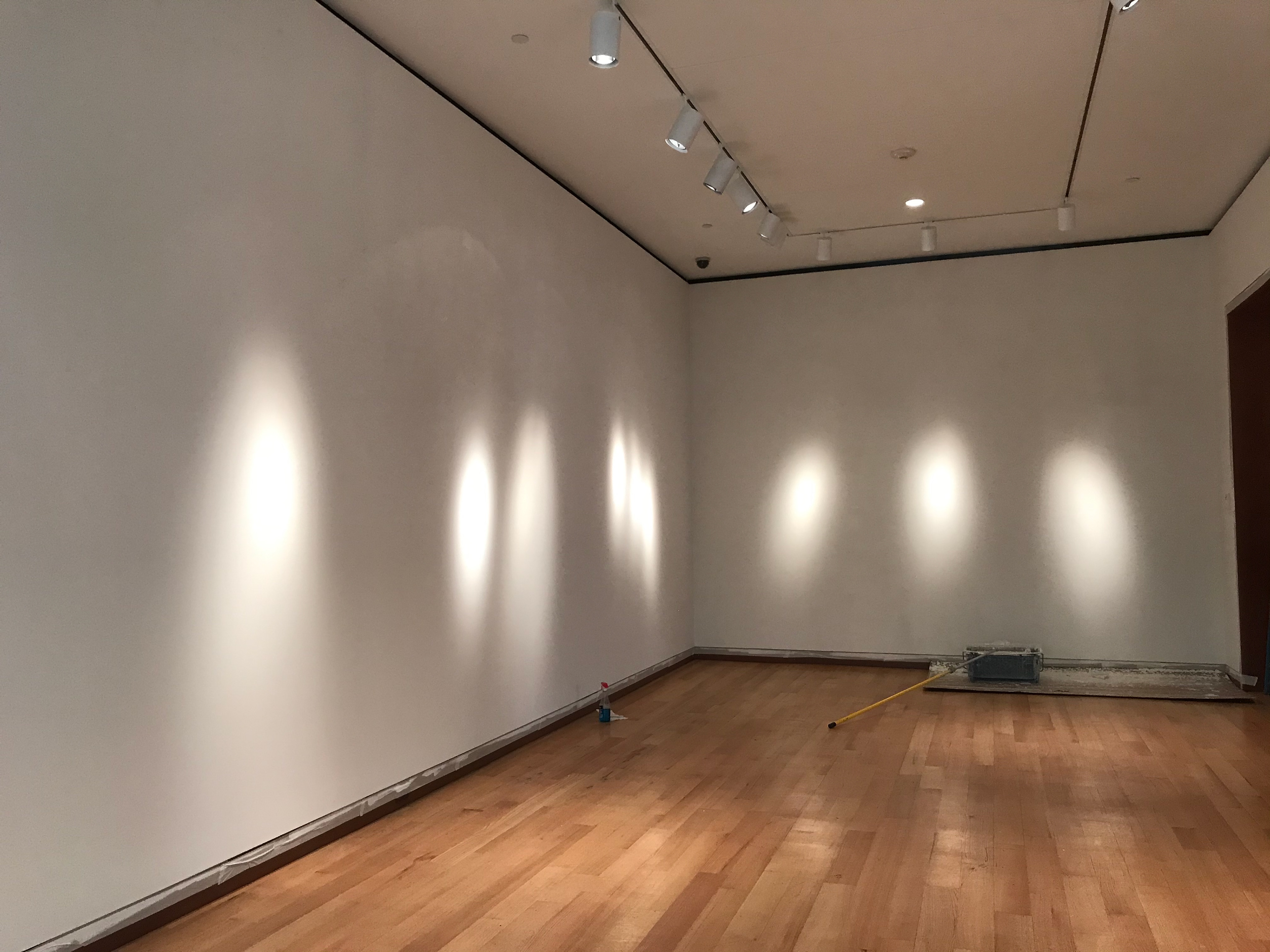
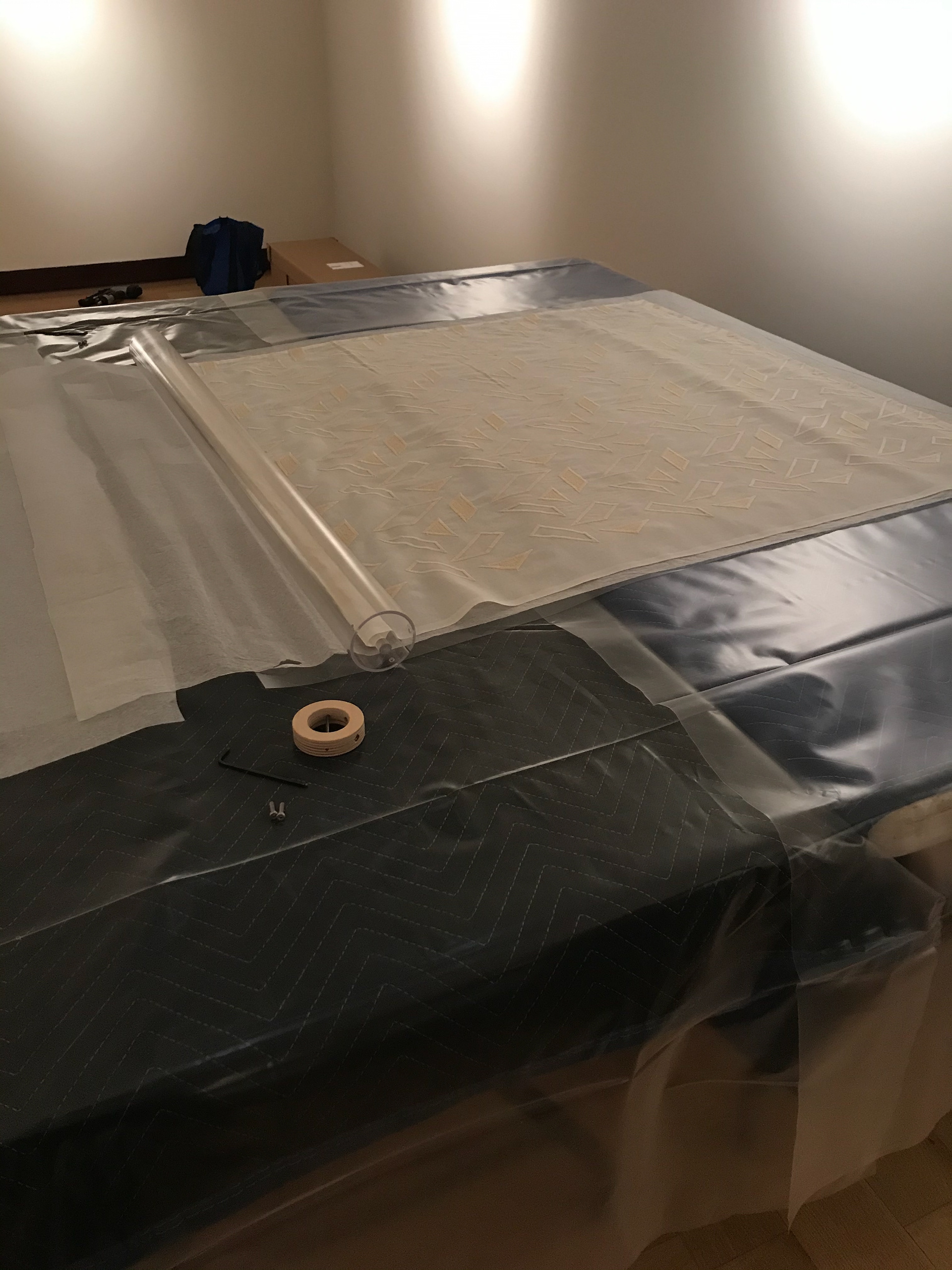

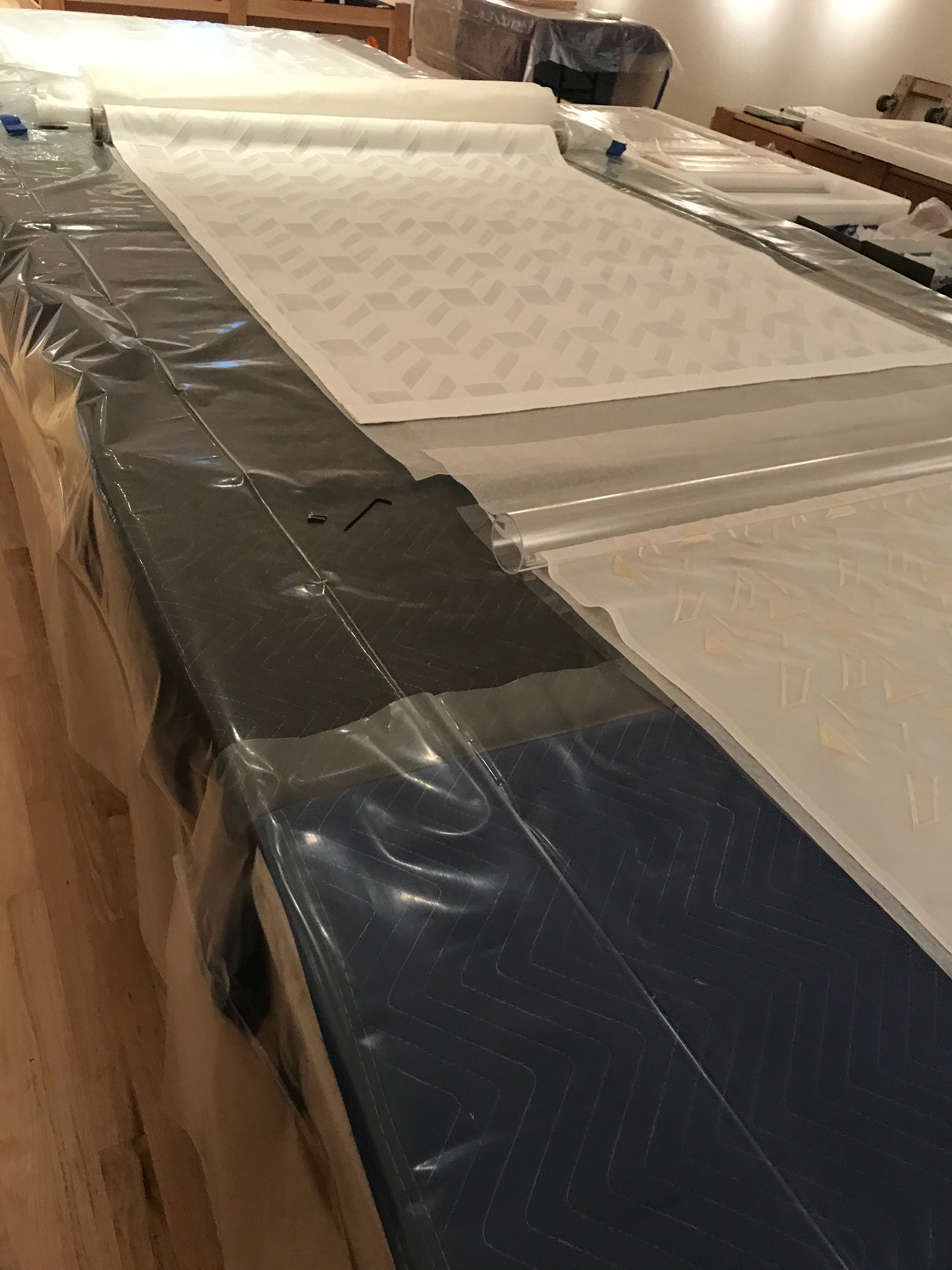
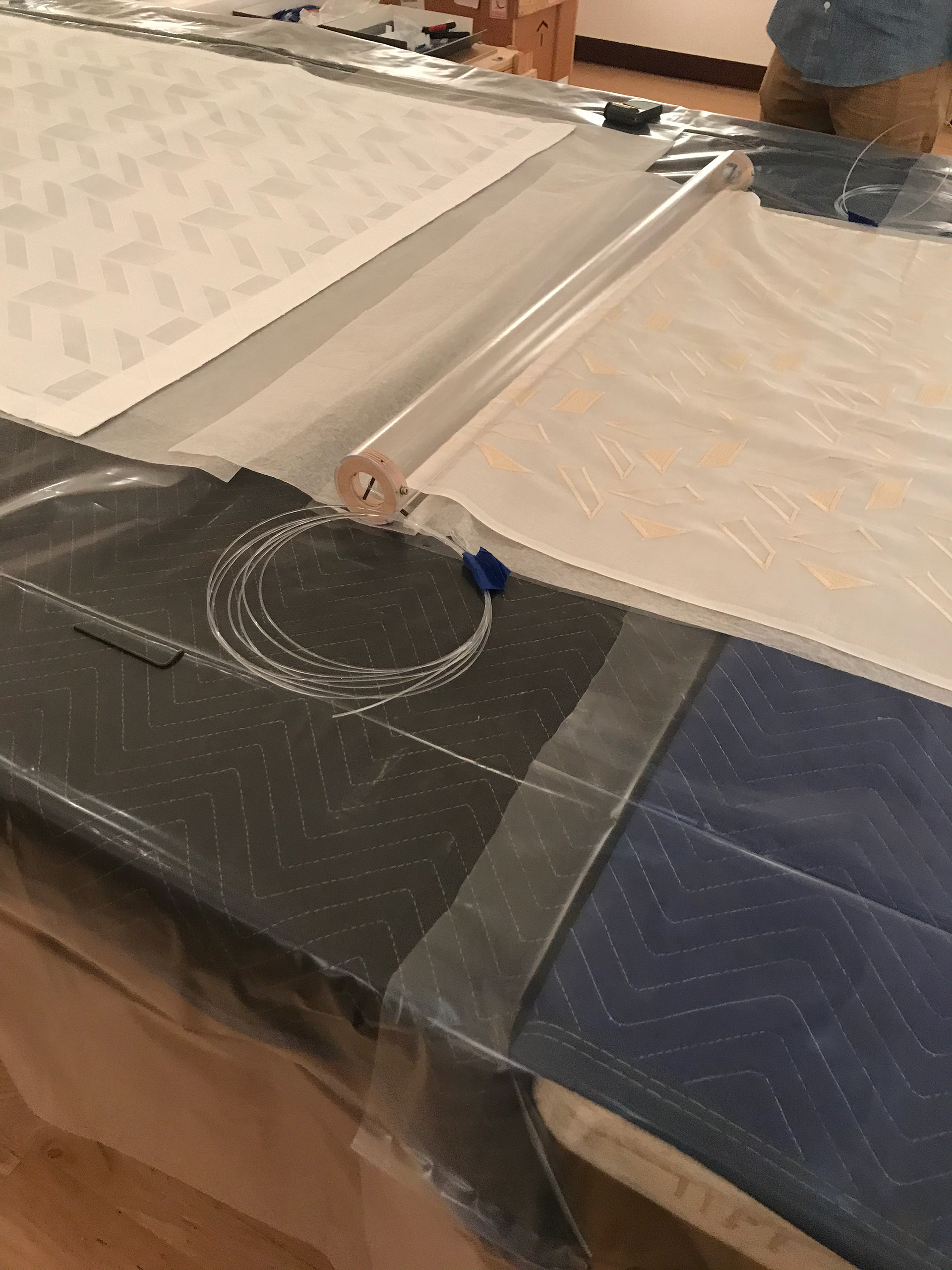

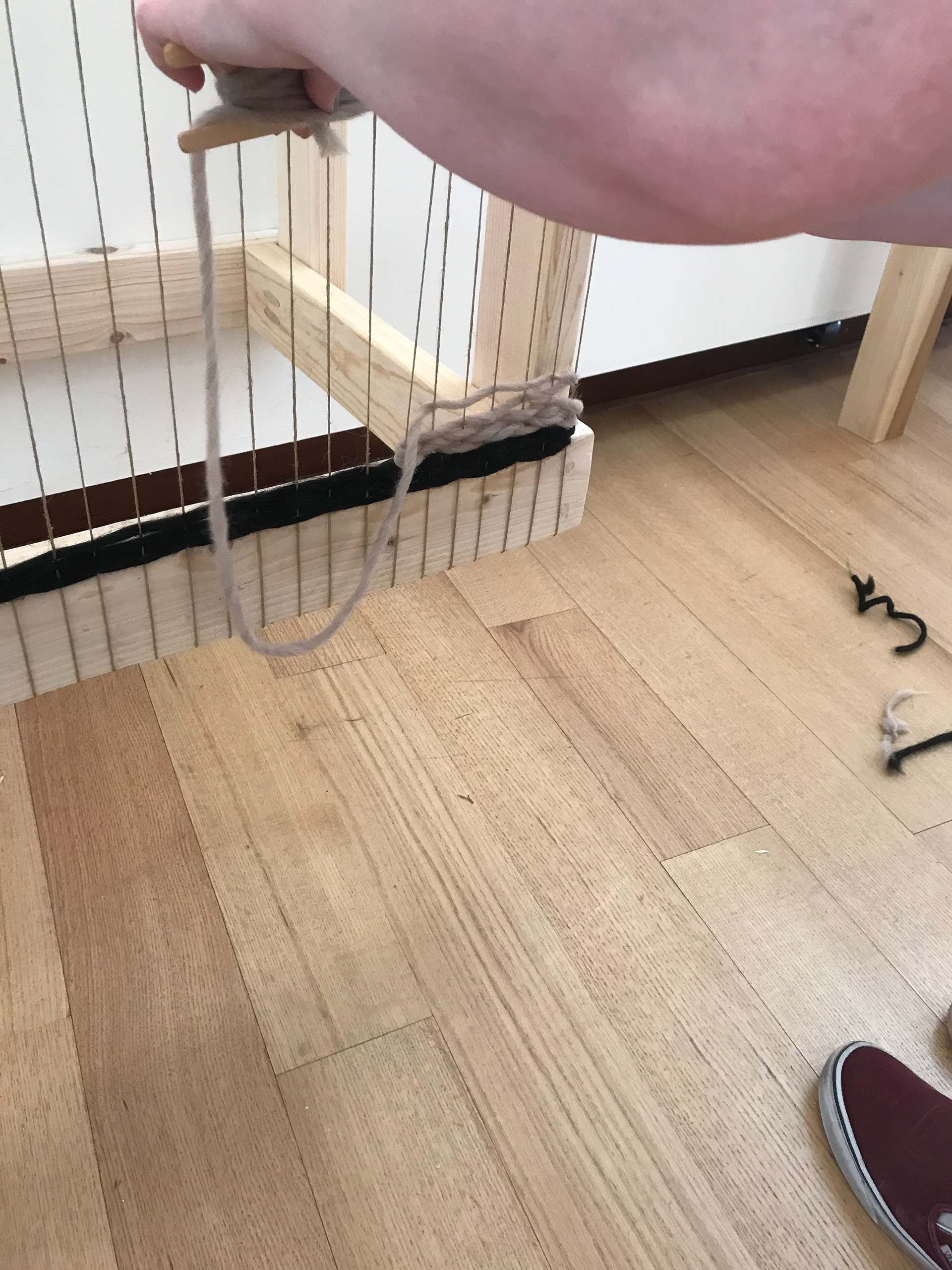
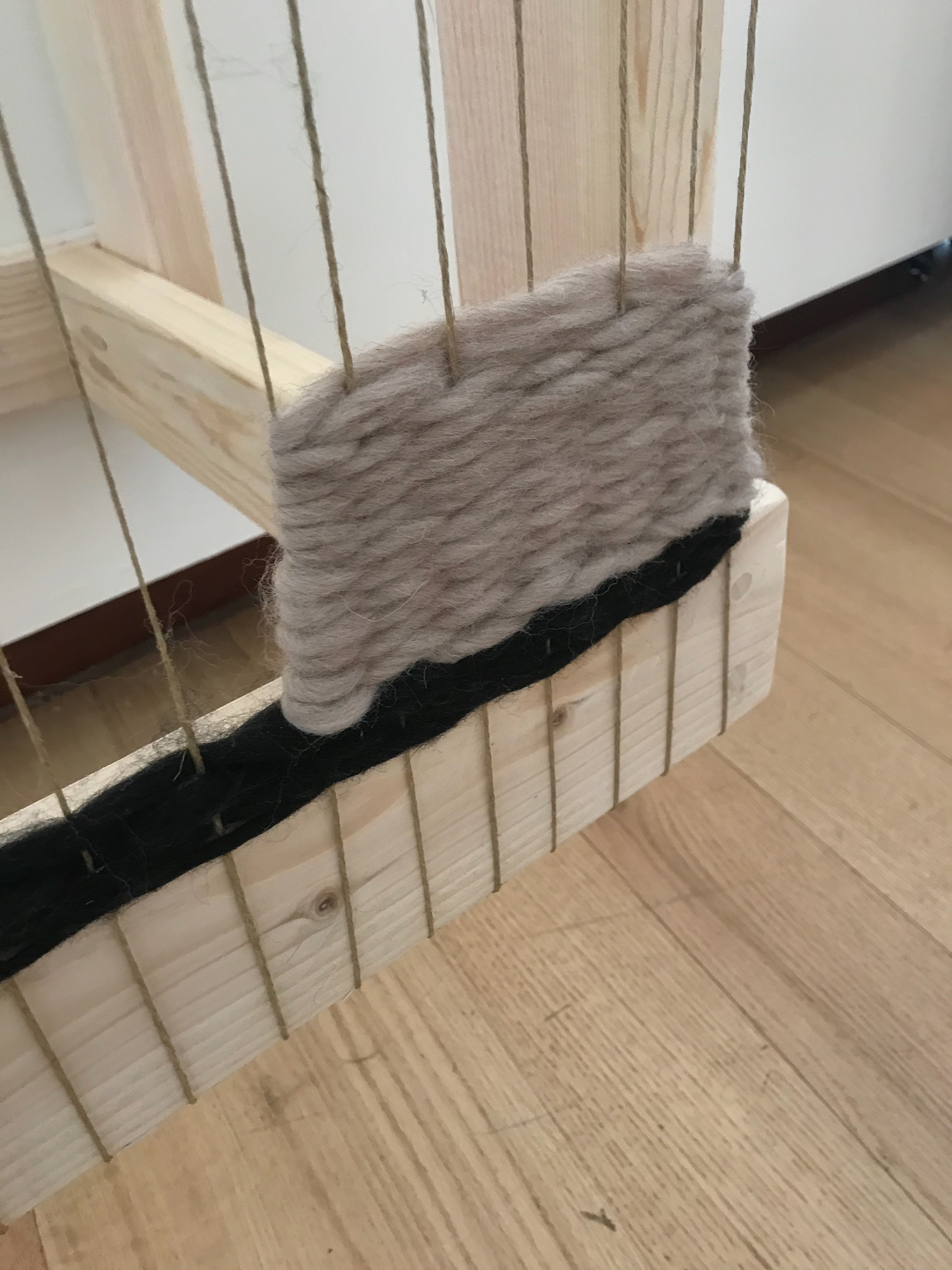
Journal: Week 8: 9-11 March 2020
What I did at the NBMAA…On March 9th our focus was creating space. Space is a big issue for the collections department. First, we cleared out a C-Bin which are extra thick cardboard boxes designed to hold many heavy pieces of art at once. Then, I cut cardboard dividers for the C-bins. Next, we threw out a bunch of old pallets, it was a real spring-cleaning sort of day. We then moved the final wall out of the Anni Albers exhibit. It’s so amazing in there, it’s a shame it won’t be seen. It was supposed to open to the public today (March 19th) but now the whole museum is closed. We then began rearranging, there were a bunch of Winslow Homer pieces that were pulled out of storage for Kara Walker that we put back into storage. Lastly, we stored all the colonial works. March 11th, also known as my last day of museum fun before Covid-19 out a damper on things, we had a photographer come to the museum and I got to spend the whole day working with her and Alexis who is the Development Assistant at the NBMAA. We were photographing pieces of art donated to the museum for an online auction. There was supposed to be a gala as well but I’m assuming its canceled. We photographed all the art on a white backdrop. We got done rather quickly so I went to build new C-bins with Mike. Since the bottoms are uneven, I had to cut foam core to fill the gaps. The museum is closed until at least April.
What I got out of reading MRM5: Section 4: Records Management…This section was about the job of a registrar which I learned is Gabby’s job. Before computers, museums kept many paper records that the registrar was responsible for, these included: a card catalog(the list of the entire collection in numerical order), a category/subject/classification file(file based of an appropriate classification system, materials and or subject matter), accession/object/document files(files kept in accession order that the curatorial department can file), maker/artist files(file with information about the artists), donor files(identified donors), location files(workable report that records object motion), object photo files(photos documenting condition, identification, insurance claims, exhibition planning and more), incoming loan files(filed documenting ownership, condition, use, and agreed upon loan conditions), Outgoing loans(correspondence, agreement, shipping papers, borrowers receipt, condition report, insurance certificates) and Exhibition files(files from planning throughout the exhibition of a show). In addition to all this the registrar is also responsible for keeping up with tax development like the IRS Form 8283 for donations. They also keep the master log that contains identification numbers from the link between the object and information about object and the worksheet which is an accession sheet completed when and object is accepted to permeant collection. Other registrar responsibilities include condition reports, copy righted licenses, loan agreements, record maintenance and to duplicate records and keep them in a safe backup location far away in order to protect them. Computers help registrars a lot now. Rather than keeping all these paper files, most museums have a CMS or a Collections Management System. At the New Britain museum or system is called TMS or The Museum System. It helps Gabby sort out the locations, descriptions, pictures, donor of objects and many other things. This system is also accessible by most of the museum’s staff, making it very easy to locate objects. There are many standards used for documenting, these standards are provided by the CDSA and CCO in the US and SPECTRUM in the UK. A data dictionary furnishes a definition of each of the fields or data elements that combine to create a documentary record of an object. The rules for data entry include having periods between the numeric values of the numbers, hyphens between parts letters, and for objects with parts letters or collections distinctions, insert a space between numeric values and letters. Of course, there are also data structure standards that provide guidelines for the structure of documentation system. In the UK they have The Collections Trust: promotes the development of documentation standards. There are many things put in place to ensure CMS runs smoothly. System management is maintenance and protection of system hardware, software, and data and their integration into museum operations. The museum makes sure that CMS is secure. The registrar keeps a backup in case system crashes. A museum normally has a system administrator or a trained staff member who can troubleshoot and manage the system. There is also a system manual that has information on hardware, software, technical support contacts, policies on system use, and instructions. TMS and the NBMAA connects to their website to increase public interest in our collection. DAMS is a system designed to manage, track, display and authenticate various files, their versions, and related information. DAMS works best with raw photos that are uniquely numbered and have persistent identifiers for the photos. Having CMS really benefits registrars.
Miller, American Encounters, chapter 9…The Emancipation Proclamation gave freed blacks civil rights in 1863. However, this did not end racism. There were many racist caricatures of African Americans in the newspapers. One example of this is The Ignorant Vote - Honors Are Easy by Thomas Nast. He portrayed and Irishman and an African American man weighed equal on a scale. He is stating that both races are ill equipped to vote. The Irish were facing a lot of racism after their recent immigration to the country. Nast was a very well know cartoonist for Harper’s weekly so this cartoon would have been seen by many. He produced around 3000 cartoons for them. Nast’s cartoons at one point fought racism. They only became racist after the civil war. Every Dog(No Distinction of Color) Has His Day discussed how there is racism to any non-Anglo saxons, it just depends on the time. This piece specifically referred to racism towards the Chinese. Thomas Ball creates Emancipation Group to celebrated Lincoln for ending slavery. However, since Lincoln is town if over a kneeing slave I think it shows that Anglo-Saxons will always see themselves as superior. The Freedman by John Quincy Adams Ward is about the uncertainty to the future. African American still need to fight for equality. Lucinda Ward Honstain created An Emancipation Quilt in 1867. Honstain was a seamstress that was very focused on social issues. Judging by this guilt it is hard to tell whether Honstain is standing for or against African American because she portrays many stereotypes. Robert Gould Shaw led the 54th Regiment, an all black military troop. The whole troop died together, including Shaw and were buried in a mass grave. Shaw’s family was asked if they wanted to relocate Shaw to a private grave and they insisted he would like to stay with his troop. A memorial sculpture was created by Augustus Saint-Gaudens which depicted Shaw with the 54th Regiment. However, despite the families wishes the troop was not individual named until many years later. Up until this point, all the works I have discussed have been Anglo-saxons telling the Stories of African Americans. Now I will discuss African American Artists. Harriet Powers was a slave who was freed. She created quilts that discussed how marginalized black women are (they still are today). These pieces were Popular Religion and Black Emancipation. Henry Ossawa Tanner was a black artist who studied under Thomas Eakins. He experiences a lot of harassment studying at the Pennsylvania. Tanner’s piece is called The Banjo Lesson and it features a little boy being taught the banjo by and older, African American gentleman.
What I got out of reading MRM5: Section 4: Records Management…This section was about the job of a registrar which I learned is Gabby’s job. Before computers, museums kept many paper records that the registrar was responsible for, these included: a card catalog(the list of the entire collection in numerical order), a category/subject/classification file(file based of an appropriate classification system, materials and or subject matter), accession/object/document files(files kept in accession order that the curatorial department can file), maker/artist files(file with information about the artists), donor files(identified donors), location files(workable report that records object motion), object photo files(photos documenting condition, identification, insurance claims, exhibition planning and more), incoming loan files(filed documenting ownership, condition, use, and agreed upon loan conditions), Outgoing loans(correspondence, agreement, shipping papers, borrowers receipt, condition report, insurance certificates) and Exhibition files(files from planning throughout the exhibition of a show). In addition to all this the registrar is also responsible for keeping up with tax development like the IRS Form 8283 for donations. They also keep the master log that contains identification numbers from the link between the object and information about object and the worksheet which is an accession sheet completed when and object is accepted to permeant collection. Other registrar responsibilities include condition reports, copy righted licenses, loan agreements, record maintenance and to duplicate records and keep them in a safe backup location far away in order to protect them. Computers help registrars a lot now. Rather than keeping all these paper files, most museums have a CMS or a Collections Management System. At the New Britain museum or system is called TMS or The Museum System. It helps Gabby sort out the locations, descriptions, pictures, donor of objects and many other things. This system is also accessible by most of the museum’s staff, making it very easy to locate objects. There are many standards used for documenting, these standards are provided by the CDSA and CCO in the US and SPECTRUM in the UK. A data dictionary furnishes a definition of each of the fields or data elements that combine to create a documentary record of an object. The rules for data entry include having periods between the numeric values of the numbers, hyphens between parts letters, and for objects with parts letters or collections distinctions, insert a space between numeric values and letters. Of course, there are also data structure standards that provide guidelines for the structure of documentation system. In the UK they have The Collections Trust: promotes the development of documentation standards. There are many things put in place to ensure CMS runs smoothly. System management is maintenance and protection of system hardware, software, and data and their integration into museum operations. The museum makes sure that CMS is secure. The registrar keeps a backup in case system crashes. A museum normally has a system administrator or a trained staff member who can troubleshoot and manage the system. There is also a system manual that has information on hardware, software, technical support contacts, policies on system use, and instructions. TMS and the NBMAA connects to their website to increase public interest in our collection. DAMS is a system designed to manage, track, display and authenticate various files, their versions, and related information. DAMS works best with raw photos that are uniquely numbered and have persistent identifiers for the photos. Having CMS really benefits registrars.
Miller, American Encounters, chapter 9…The Emancipation Proclamation gave freed blacks civil rights in 1863. However, this did not end racism. There were many racist caricatures of African Americans in the newspapers. One example of this is The Ignorant Vote - Honors Are Easy by Thomas Nast. He portrayed and Irishman and an African American man weighed equal on a scale. He is stating that both races are ill equipped to vote. The Irish were facing a lot of racism after their recent immigration to the country. Nast was a very well know cartoonist for Harper’s weekly so this cartoon would have been seen by many. He produced around 3000 cartoons for them. Nast’s cartoons at one point fought racism. They only became racist after the civil war. Every Dog(No Distinction of Color) Has His Day discussed how there is racism to any non-Anglo saxons, it just depends on the time. This piece specifically referred to racism towards the Chinese. Thomas Ball creates Emancipation Group to celebrated Lincoln for ending slavery. However, since Lincoln is town if over a kneeing slave I think it shows that Anglo-Saxons will always see themselves as superior. The Freedman by John Quincy Adams Ward is about the uncertainty to the future. African American still need to fight for equality. Lucinda Ward Honstain created An Emancipation Quilt in 1867. Honstain was a seamstress that was very focused on social issues. Judging by this guilt it is hard to tell whether Honstain is standing for or against African American because she portrays many stereotypes. Robert Gould Shaw led the 54th Regiment, an all black military troop. The whole troop died together, including Shaw and were buried in a mass grave. Shaw’s family was asked if they wanted to relocate Shaw to a private grave and they insisted he would like to stay with his troop. A memorial sculpture was created by Augustus Saint-Gaudens which depicted Shaw with the 54th Regiment. However, despite the families wishes the troop was not individual named until many years later. Up until this point, all the works I have discussed have been Anglo-saxons telling the Stories of African Americans. Now I will discuss African American Artists. Harriet Powers was a slave who was freed. She created quilts that discussed how marginalized black women are (they still are today). These pieces were Popular Religion and Black Emancipation. Henry Ossawa Tanner was a black artist who studied under Thomas Eakins. He experiences a lot of harassment studying at the Pennsylvania. Tanner’s piece is called The Banjo Lesson and it features a little boy being taught the banjo by and older, African American gentleman.
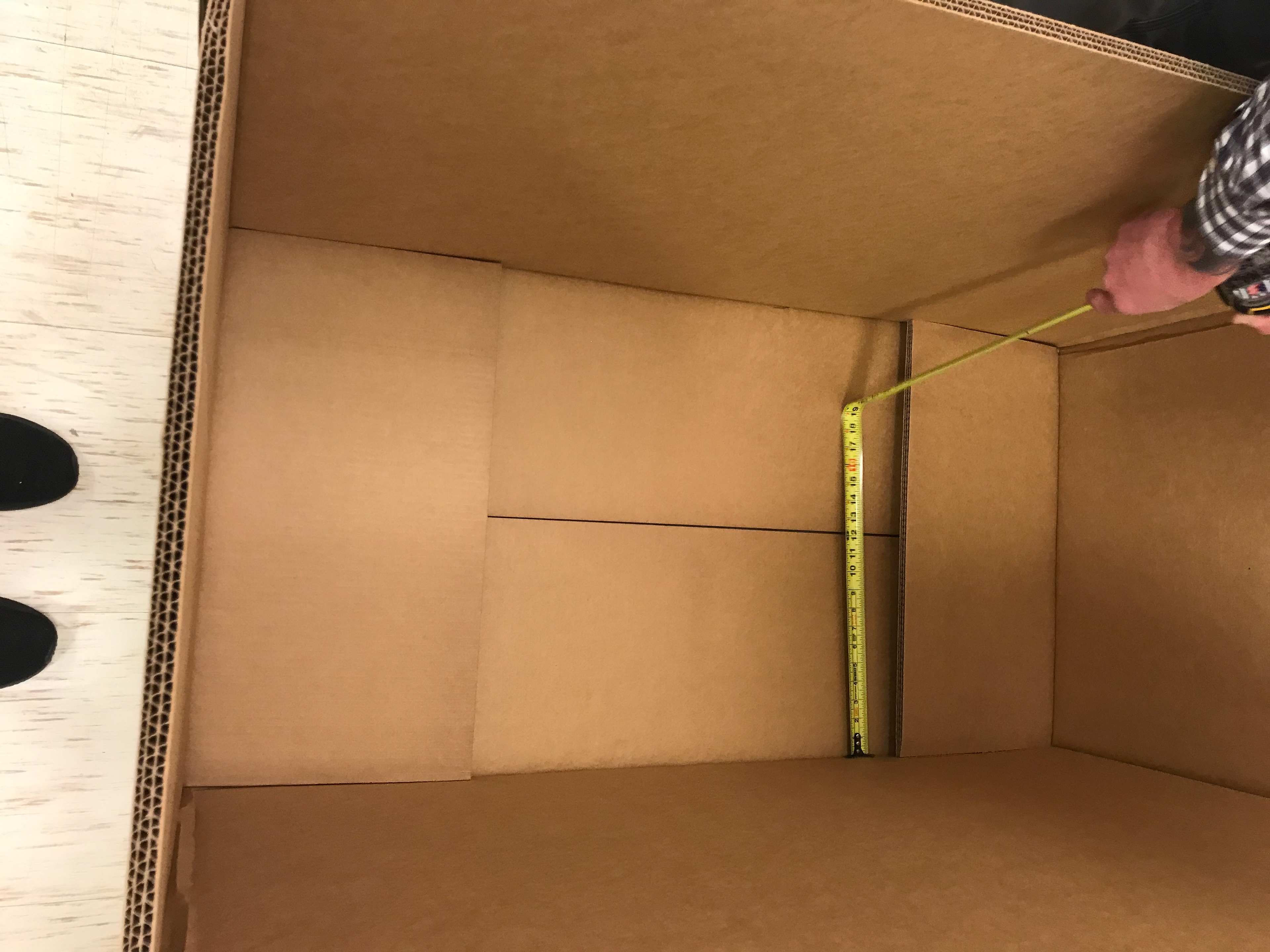
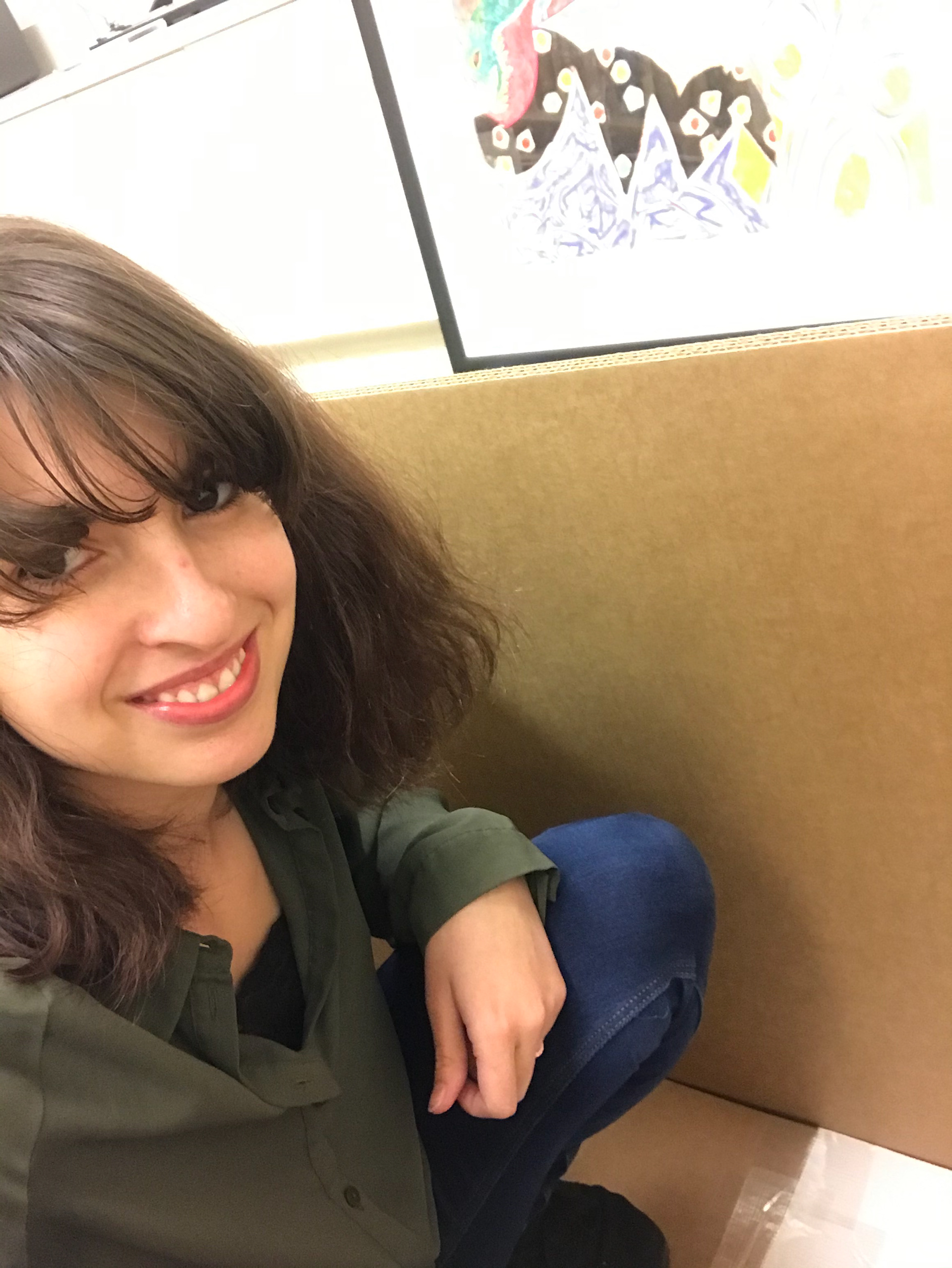
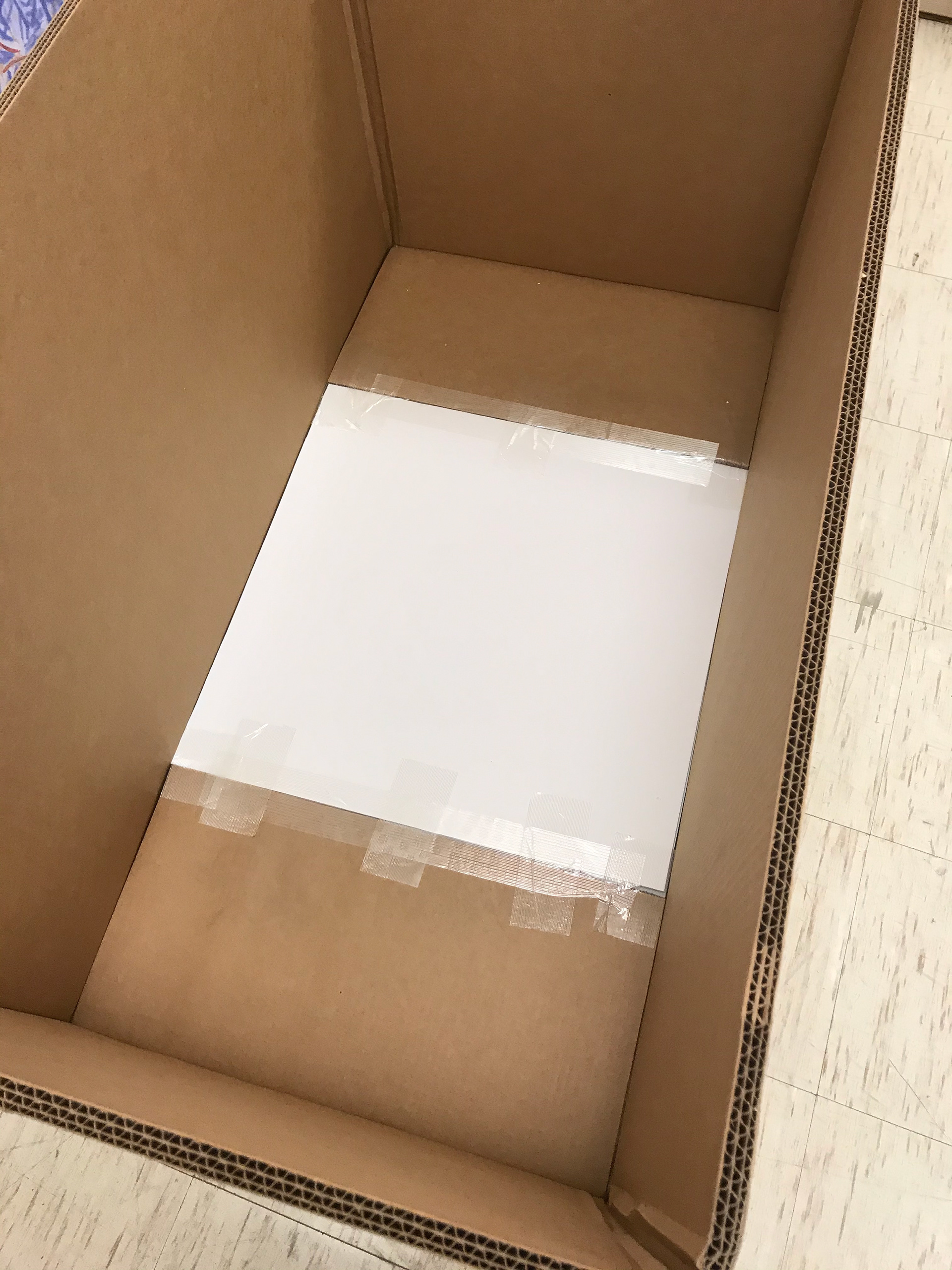
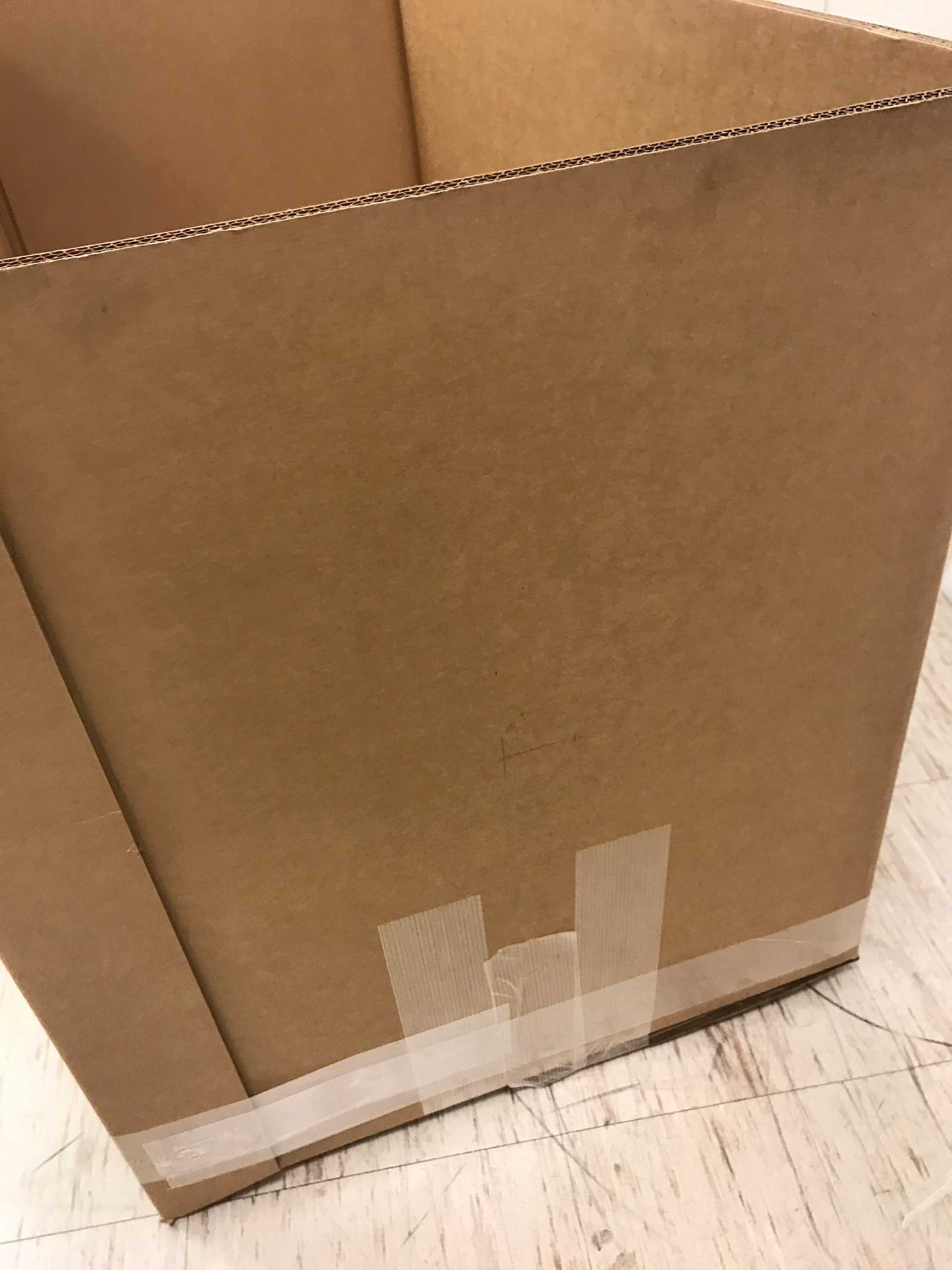
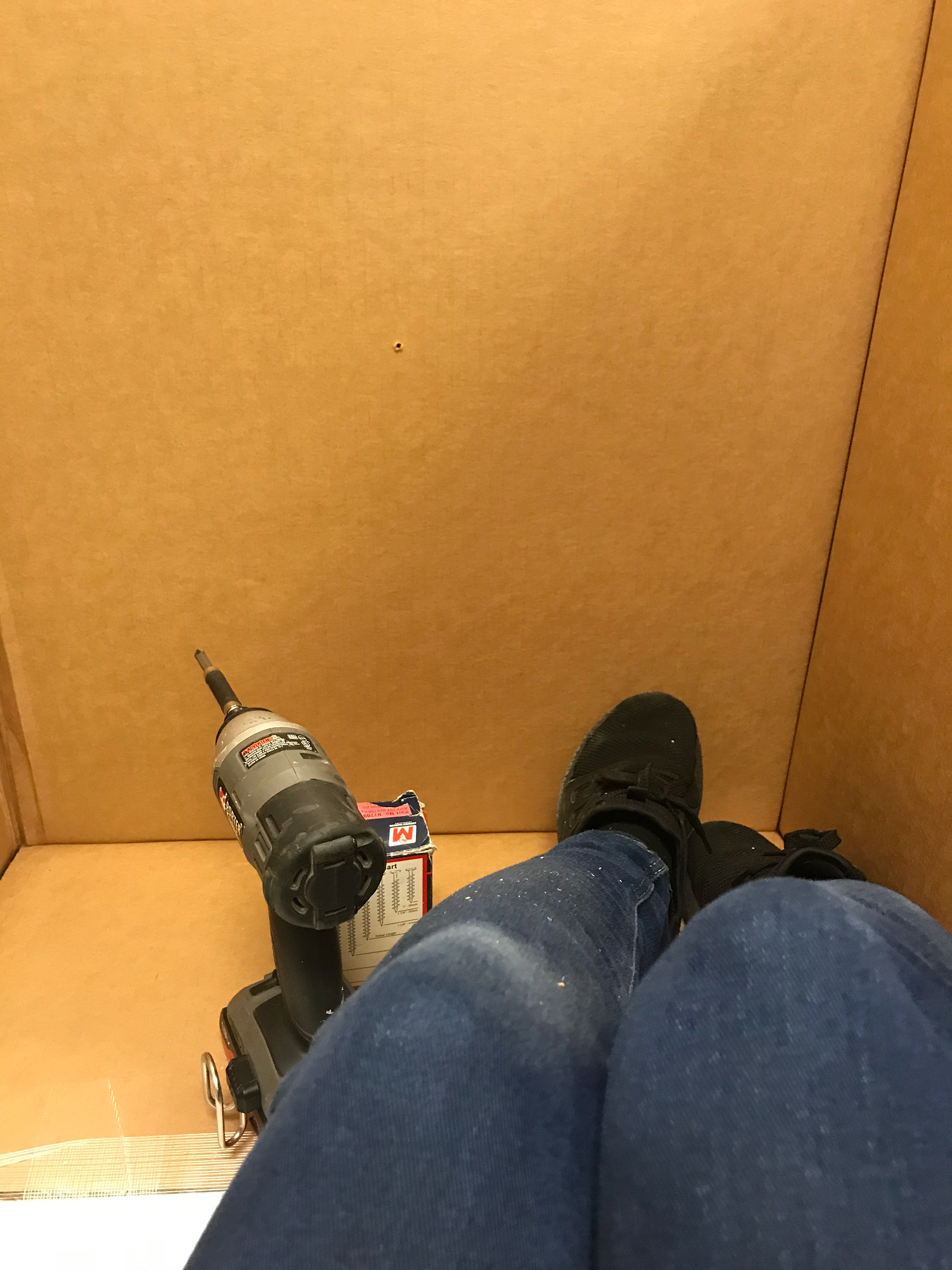
Journal: Week 9: 23-25 March 2020
What I did at the NBMAA…The NBMAA will be likely closed past the beginning of April so I am being released from my lease and returning to NJ to live with my father.
What I got out of reading MRM5: Section 5: Collections Management…
This section started by discussing the numbering of objects to keep track of the collections. Permanent collections are numbered like so: 2010.1: transaction, first of the year 2010, 2010.1.1: first object is a single unit, 2010.1.1.1-10: first object is a set of 10 pieces, and 2010.1.1a,b: first object is a pair, two parts. Temporary records are numbered a bit differently: TR1.2010: transaction, first of the year 2010, and TR1.2010.1: first object in the transaction. Loans are indicated with an “L”: L1.2010: first loan of 2010 and L1.2010.1: first object in the first loan of 2010. Unique numbers are important in order to keep track of an object, its context, and information related to the legal status. Logically a number system should be sequential. Damage is going to happen once and awhile. Human interaction is the most common cause of damage to artwork so handling procedures are important to protect the collections. The registrar or collections manager has the final say about who is permitted to handle the objects. Some museums do not permit the interns or volunteers to handle the artwork and others do as long as they are being supervised. Procedures differ for 2D works, 3D works and furniture. Common object rules are: prepare yourself, take your time, and plan ahead. Be mindful of the amount of light an object can handle. Light can damage objects. When handling artwork: always keep food and drink away from objects, make sure your hands are gloved and your clothes are clean before handling an object, make sure your pathway is clear before transporting art work, examine your object and be aware of fragile areas, make sure your gloves and tools are clean, only carry one object at a time, use proper posture while carrying heavy objects and use two people if necessary, use a ladder to reach objects a over your head and be aware of your physical limitations. Framed paintings should stored in a consistent environment, examine closely before touching, use both hands when carrying, use a padded truck or cart to move large paintings, don’t lean painting against the wall, use padded blocks, tape glass when shipping framed works to prevent the glass from damaging the work if it breaks. The best way to store framed works is by hanging them on racks. Textiles should never be worn, they should be handled with extreme caution, in storage they can be rolled in an archival tube or they can be folded, heavy textiles should never be pierced with holes for hanging, accession numbers can be on tags that are hand-sewn to the fabric if it is a loose weave. Works on paper should never lift paper by the edges, slip a thing support underneath to lift it, if a work must be turned over, first put an archival tissue and another board on the top, they should be stored in archival folders, never use clips or staples, if a mat is used then it must be archival, matted works are better for storage, keep in low humidity, and protect from over exposure of light. Books are fragile and should be treated gently. Books should be stored with books of like size and if stored vertically should be placed in away that prevents the pages from sagging, do not over stock shelves, each book should be easily removable, books with loose pages or damaged binding should be tied with soft cotton tape, when being exhibited a book should be under low light, books with undamaged edges can be infrequently dusted with a hog hairbrush. Ceramics and glass may handled with ungloved, clean hands unless the ceramic is porous or unglazed, hold ceramics by the base, place padding between objects when they are being transported on carts. When handling furniture, it must not be dragged, only lift chairs from underneath the seat, large pieces of furniture should be moved by at least two people, if furniture has multiple parts it should be taken apart and moved in pieces, and carry marble and glass tops vertically rather than flat to prevent cracking. When handling musical instruments cotton gloves must be worn, you should cover instruments during transport to prevent thermal shock, and an instrument should never be lifted by or rested on keys, the bridge, strings or any other delicate component. When moving sculptures from the rear of a storage shelf, first move all the items in front, inspect the object before touching, transport them in the same position that they were being stored, and use a cart when moving several items. If any damage occurs it should be immediately reported to a supervisor so photos can be taken and an incident report created, the lender must be notified if the object is a loan, object should not be cleaned or moved until the report is complete, if the incident occurred to an issue with a mount or pedestal, they issue should be fixed before the object is returned, and if damage occurred during shipment the packing materials should not be discarded and the shipper should be notified. Then museums measure objects they either use the English system or the metric system. The English system is expressed in inches within 1/16th of an inch and the metric system is in centimeters to one decimal place. Yardsticks, rulers or measuring tapes are used to measure objects. Calipers and otseometric boards are used for 3D objects. Height, width and sometimes depth is taken for 2D objects and height, length or width and depth are taken for 3D objects. A condition report can: establish the exact conditions of an object, benchmark the rate of deterioration, differentiate otherwise identical objects, document an objects condition history, set priorities for conservation, suggest a default monetary value, and make future handlers aware of seen and unseen problems. Tools for documentation include: soft lead pencils, writing paper, examination forms, computer, and a camera. Tools used for measuring are cloth tape measure, calipers, and a clear plastic flexible ruler. The tools for handling and support are clean white cotton gloves, nitrile gloves, acid-free, lignin-free board, acid-free tissue paper, padded muslin rolls and blocks, and a flatbed dolly. A flashlight, pen or crevice light, a portable incandescent light and an ultraviolet light can all be used for illumination. For magnification a 10x hand lens, a jeweler’s loupe, a 55x microscope and/or a head-mounted magnifier can be used. The registrar or collections manager may also choose to use a hand mirror, a dental mirror, a magnet, a natural hairbrush, probes, tweezers, and/or an air blower. A condition report should include accession number, type of objected, artist, title, the date created, dimensions, number of parts, object composition, types of damage, extent of damage, location of damage, previous repairs, dates and reason for damage if known, examiner’s name and date of examination. Photographs should include identifying numbers, scale, color chart and date of image. All objects should be marked with the accession number to prevent them from getting lost. A photographer can save files as tiff, jpeg, png, or raw. Files can be stored on a hard drive, on a server or most likely both. To ensure proper color management, use proper exposure and bracketing. Museums can have in-house photographers or hire freelance photographers. I won’t go into too much detail about photography because the information in this book is too outdated and is probably wrong because the photography industry has evolved so much since this book was written. When this book came out digital photography was just starting to be used.
Miller, American Encounters, chapter 10…Due to the transatlantic cable artists American artists began to move from nationalism to internationalism. More young Americans gained success in Europe and they know longer felt loyal to American themes. A switch happened where women were more likely to view art than men, however the art world remained male dominated. America became obsessed with Japan once again and the term Japonisme was coined which is a love for all things Japanese. Japanese woodblock prints inspired many artists and pushed the arts beyond naturalism. One of the artists inspired by Japonisme was Mary Cassatt. Since being a woman in the American art world Cassatt first moved to Paris in 1865 and there she flourished. She was exhibiting in the Paris Salon by 1868, making her the only American to exhibit with the Impressionists. Cassatt mainly focused on mothers and children as a subject. Like male impressionists, Cassatt’s 1889 Mother and Child used abstracted brush work. It depicts a child struggling to stay awake within his mother’s arms. Their linked arms show a strong bond. Tanner also moved to Paris, but he was escaping racism rather than sexism. The French considered Tanner to be one of the best US born artists. He was even accepted into the Paris Salon in 1894. After this he became focused on depicted the New Testament. He felt an attachment toward Christianity because of his father. He created The Annunciation of 1898 after visiting the Middle East. This allowed him to create a more ethnic looking Mary as opposed to all the European Mary’s. His trip also inspired her textiles. Tanner painted the cycle of Christ in historical Palestine. The world fairs were very important to learning about other cultures, however they were rooted in racism. They became about pushing Western commodities, like soap for example on the Eastern World. The World Fair advertised a hierarchy of races. However, The World Fairs inspired quilt makers. Crazy Quilts named after their lunatic visual extravagance were inspired by The World airs. They were derived from "crazed," as applied to the all-over crazing in some Japanese ceramics where the surface glaze is cracked or broken up into an irregular pattern. The pattern on these guilts looked cracked or broken. When M. M. Hernandred Ricard (1838-1915) began the work, she entitled My Crazy Dream in Boston in 1877 she didn’t expect it would be completely outdated by the time she finished, 35 years later. At the center, she embroidered a giant peacock and a small elephant with a house, six human figures, and a dog. The sky is created with various blue silks and the corners contain Japanese fan designs. On the left corner she embroidered her name and the title of her work. The last artist I would like to discuss is Elizabeth Hickox who was a basket weaver in California. She was sponsored by Grace Nicholson, an art dealer who paid Hickox $500 a year so that she could devote herself to her craft. Nicholson dedicated the first floor of her house as a gallery for Native art and she would sell the pieces to collectors. Nicholson made Hickox a brand that Americans sought out or their homes.
Journal: Week 10: 30-01 March-April 2020
Miller, American Encounters, chapter 11…This Chapter started with the story of photographer Clover Hooper-Adams…from the perspective of her husband and the artists who created her memorial. This made me sick, so I did my own research on Hooper-Adams. She suffered from depression due to the restriction placed on women and the death of her father and she turned to photography to cope. She was a portrait and landscape photographer whose work ranged from serious to humorous. A good example of her humorous photos is Three dogs at tea in garden. Many of her portraits depicted human in chairs but outside in nature. I feel this juxtaposed nature and the effects on humankind quite nicely. Hooper-Adams was also known as an animal lover. Some sitters for portraits of George Bancroft and Francis Parkman, the architect H.H. Richardson, and the jurist Oliver Wendell Holmes, Jr. Her portraits of woman and children are also notable but I could not find a list of names. 48 of her photos are located at the Massachusetts Historical Society. After the death of her father, Hooper-Adams lost her life to depression by drinking the potassium cyanide that she used in developing her photos. My research on Clover Hooper-Adams came from the Massachusetts Historical Society (https://www.masshist.org/features/clover-adams) and Britannica (https://www.britannica.com/biography/Marian-Adams). Now I guess I should mention that her husband was Henry Adams who commissioned Augustus Saint-Gaudens to sculpt a memorial for her in Rock Creek Cemetery, Washington, D.C. In the sculpture she is seated on a rock bench with her back upright and her right arm raised, its spread fingers barely touching her chin in a gesture of contemplation. Her eyes are looking down to know she is looking inward to herself. Saint-Gauden’s intention was to make her sexual ambiguous which she was at the time but looking at the sculpture with modern eyes, she comes across a bit feminine. Saint-Gaudens wanted her to come across as, “Beyond pain, and beyond joy”. This chapter reviewed women who were trying to push their way forward in a male dominated art world. Ellen Day Hale was an American artist in Paris who submitted a self-portrait to the Paris Salon in 1885. Self-portraiture was essentially like a rich of passage for artists so the fact that she submitted a self-portrait was forcing people to recognize her as an artist. Her portrait was called Lady with a Fan (Self Portrait). She depicted herself look almost like a young boy rather than a 35-year-old woman. She wanted to appear sexually ambiguous. Cassatt was mentioned again in this chapter. Though France provided her more freedoms than the US she was still not permitted to paint public spaces like concerts and bars. Cassatt uses her work to portray women as complex beings rather than sexual objects. In The Loge is my new favorite piece by Cassatt. It depicts a woman enjoying the arts, watching an opera while a man is objectifying her through his opera glasses. She pays him no mind and just emerges herself in the show. Cassatt depicts the woman as curious and present in the arts. Cecilia Beaux’s Dorothea and Francesca showed a relationship between two close friends who lean on each other. This image demonstrates and act of femininity. Beaux was a single woman all her life who had a very successful career in the art world, yet she denied feminism. She was making as much of a contribution to the world as any other man, but she did not believe she should have the right to vote. She thought that women were happier in domestic roles which was odd because she wasn’t in one herself. If she thought all women wanted that then why didn’t she want it? Her stance confused me a bit, I wish she was alive so I can interview her about it.
Journal: Week 11: 6-8 April 2020
Miller, American Encounters, chapter 12…Lewis Hine had the same mission as Jacob Riis except he did it in a humane way, created stronger photos and made a real difference. Hine brought us inside the world of the immigrant poor rather than situating us from the outside looking in. The big change he made came from his work with victims of child labor. He would smuggle his camera into factories to take portraits of children working in horrible conditions. Cameras were not permitted of course, because those on the top did not want the world to see how they treated their workers. This work by Hine lead directly to the federal legislation in 1916 that prohibited child labor. Little Mother in the Steel District by Hine depicts a little girl nurturing her baby, except her baby isn’t a doll it is her sibling that she is taking care of, probably because her parents are at work but there can be 100 different reasons. Hine gives this girl an identity through his portrait. The girl looks so self-sufficient and grown up. Now we will switch gears and discuss Georgia O’Keeffe who was conventionally trained, first at the Chicago Art Institute and then at the Art Students' League in New York City under William Merritt Chase. Synaesthesia was the principle that sound could be depicted in abstracted colors which is how much of Georgia O’Keeffe’s work was created. She didn’t just create work from music, she was inspired by many sounds even the sound of cows mooing. In the 1920s, O’Keeffe began painting flowers which are the pieces she’s most famous for. Flowers were unfortunately known as a subject for amateur female painters but O’Keeffe painted them in a whole new way. Her work was often subjected to the false critiques of men in the art world, this was the fault of her partner, Stieglitz who would take nude photos of her and exhibit them. This made men associate her work with sex. The assumption is often made that her flowers are intended to look like sex organs, which is something O’Keeffe has declined. Paul Rosenfeld actually assumed O'Keeffe exposed women's sexual feelings to men. This makes me think he may be a little ignorant in that area… There is nothing wrong with Stieglitz creating art depicting his love nude as long as she’s consenting. However, it seems he just did it to bring people into his gallery which is wrong. He knows that sex sells and he exploited that. It is a shame that these photographs brought even more sexism upon her. In the book, it actually says that critics have stated, “…her expressive power came directly from her womb…”. What does that even mean? I think that is the most sexiest critique of art that I have ever heard. I’d like to hope the art world has come just a little bit farther beyond that…
Buck and Gilmore, MRM5: Section 5: Collections Management I, II, and III: Hypotheticals…This weeks reading was about slowing down deterioration which can be done through careful handling and proper storage. Procedures for deterioration mitigation should include: appropriate environmental conditions, proper handling and maintenance, integrated pest management, emergency preparedness and response, and reformatting/duplication. The environment should be 70°F +/- 2°F with humidity at 50% +/- 5%. An improper environment can cause chemical, biological, and mechanical deterioration. Light is radiant energy. The 3 types of radiation that affects the object condition are: visible radiation(lux or foot-candles(fc)), ultraviolet(UV) light(microwatts/lumen(mw/lm)) and infrared(IR). To ensure the safety of the objects, avoid using these materials: cellophane tape, cotton wool, foam rubber and urethane foam, masking tape, metal clips(stainless steel is and exception), nail polish and remover, paper that’s not acid free, most plastics, rubber bands, rubber cement, white glue, and wood products. Instead, try these storage materials: acid-free paper, cotton fabrics, plastic paper clips, polyester batting, polyester film, polyethylene microfoam, polypropylene bags, special adhesive, and special envelopes and mounts. Environment stability is very important so a centralized HVAC or climate-control system is important to keep the temperature and RH levels consistent. Security is obviously necessary to protect the art from left. First, the museums must do background check before hiring, then they should operate on a key card system to monitor who accessed which area, and they should also have computer monitoring system. This weeks reading then moves on to discuss inventory, starting with some fairly obvious advise. The AAM states when it comes to inventory you should: know what stuff you have, know where it is, and take good care of it. To keep track of inventory you must identify objects that require conservation, identity objects that require special storage conditions, document the location and movement history and document the collection in the event of catastrophic loss. The types of inventories: Various inventory/a complete inventory/a 100% inventory/wall-to-wall inventory/ baseline inventory is the most comprehensive inventory and the goal is to document the location of each object, a partial or section-by-section inventory is limited in its scope to some logical unit, such as only objects on display and a random or spot inventory is also limited in scope and the goal is to verify the location of a representative sampling of objects which check the reliability of the museums locations records. An inventory should include: the accession number, the tombstone information, current location, the inventory staff member and date; and it may also include: a brief condition assessment, a digital image, dimensions, and an assessment of storage needs. When preparing for the inventory you will need to: conduct retrospective data entry, design queries and data-entry screens, design forms and reports, organize storage, create a location authority, write guidelines for the staff and hire or train staff. When you actually go to conduct inventory you walk through the whole museum and storage, verifying the locations of the objects and inspecting them. Every time an object is moved you must record the accession number, the old location, the new location, the date of the move and the name of the person moving the object. Preparation refers to preparing an object to enter the collection. When preparing an object you must: use stable, non-reactive materials, use reversible, non-damaging materials, provide a proper environment, document all activities, retain the association of objects and their documentation, consider each object as unique, consider the museum’s procedures on how objects are to be placed, and respect the object. Some objects may require storage furniture like mounts or boxes. All materials used with museum objects must be acid-free. Rigging objects helps move heavy objects. It usually involves a forklift, a chain hoist or a block and tackle. We rig the walls with a pallet jack when we move them around the NBMAA. Dollies and hand trucks can also be very helpful in moving heavy objects. I used a dolly almost every day at the museum. Risk assessments are preformed before and object is packed and transported, this assessment includes an examination of the object, a knowledge of the transportation environment, a review of the facility, and consideration to how the object with be installed at the final destination. The types of crates include: a one timelone-way crate, a two-way create, a touring crate, a breakaway crate, and a slate crate. The types of internal packaging include: a brace pack(wooden brace), cavity-pack/foam cut-out, contour bracing, foam lined box, double-crating, slot style, t-frame slots, rack style, sliding tray and tray pack. Soft packing is packing an object in a way that offers structural protection without a hard crate. When shipping by airplane a courier must attend, you must consider the size and weight, and freight rates will apply. When shipping by mail it’s best to use express mail or art handlers. A courier needs a condition report and photo, a copy of the loan agreement, evidence of insurance, a list of representatives at the borrowing institution, a hotel reservation and details, contact information for the borrower, plane tickets and passports, contact information for the drivers and security guards at both ends of the trip. Couriers are needed for irreplaceable objects, fragile objects, and for dangerous shipping routes. Directors, curators, registrars, and conservators are all qualified to be couriers. Couriers witness the packing and unpacking, must stay with the shipment, prevent delays whenever possible, must have no conflicting obligations, must uphold museum standards, must be present for the pre-evaluation of shipping difficulties and must have a strong knowledge of the object. The courier must provide a copy of the loan agreement, a list of contact information of the borrower and lender, a transit schedule, insurance information, a crate list, handling instructions, condition reports, photos, and a copy of the customs invoice to the borrower
Journal: Week 12: 13-15 April 2020
Miller, American Encounters, chapter 13…Marguerite Thompson was one of the many American artist who traveled to Paris. She was inspired by the work of the Fauves and she visited Gertrude Stein, as you do when you’re an artist in Paris in the early 1900s. She also of course, gained further exposure to Matisse. In 1912 her and her husband, William Zorach returned to New York. The eventually relocated to Provincetown for its bohemian culture. Marguerite initially trained as a painter but switched to to tapestry in the 1910s because she enjoyed the bright colors of Fauvism, she felt she could get brighter colors with tapestry. Most of her work was nature related, it celebrated nature. She created Maine Islands in collaboration with her husband, an American version of Matisse's Le Bonheur de Vivre. She faced challenges with tapestry work since it was considered a feminine art form but like she said, “All the constructions and relations you find in painting are in the tapestries-just the technique and the materials are different.” Josephine Baker was a performance artist. She had a stage persona where she dances topless with a skirt made from bananas. This was to bring attention to fantasies of African women. It was a satirical performance that brought attention to the confines of sex and race. Romaine Brooks was a lesbian artist who enjoyed her freedom in the safety of Paris. Her family was not excepting but she was able to use her inheritance to fund her life in the community of lesbian artists. Brooks's portrait of her friend Una, Lady Troubridge is rather desaturated with the exception of her bright red lip stick. She has a huge monocle, an intense bob and two dogs that help create her personality. The male gaze is a common thing we see in art but very rarely, at least in art history do we see the male gaze targeting men, one example of this is Distinguished Air by Demuth. Demuth was a gay artist creating in the New York Dada scene. He painted watercolors of the city and men in bath houses and on beaches. Marsden Hartley was another example of an artist putting the male gaze. He created a hilariously weird piece called Christ Held by Half Naked Men which honestly doesn’t need any further descriptions. It’s exactly what you think it would be, a portrait of baby Jesus being held by a bunch of half-naked men. Another artist in New York Dada was Picabia. He created a cool portrait of Stieglitz called, Picabia's lei, C'est lei Stieglitz: Foi et Amour where he portrayed him as a box camera. Picabia was fascinated with machines influences on humans, explaining why he would portray Stieglitz as the machine he uses to create. The bellows on the camera are fading, making them not ideal which is meant to link Stieglitz’s creativity and masculinity.
Journal: Week 13: 20-22 April 2020
Miller, American Encounters, chapter 14 and 15…Chapter 14 was mostly about films. I decided to look some of them up and watch them. Sheeler and Paul Strand created one of the first videos full of New York City landscapes. The film is 7 minutes long and is paired with quotes by Walt Whitman. The film starts and ends with a scene of the New York City skyline. These broad shots are very common in films today but was all new at the time. What I really enjoyed in the film was all the people rushing around, it shows the character of NYC. I also like the scenes of men building sky scrapers. It shows a city in progress. The next film I watched was Harold Lloyd's Safety Last of 1923. This was so bizarre but cool that they were able to complete this at the time. It honestly did look pretty real. The man character was a man who was trying the scale a sky scrapper for love. He was originally only supposed to scale one floor and his friend was supposed to pull him in a window, however the police were chasing him, so the friend kept going higher. According to the book, the main character was supposed to get some sort of cash reward upon completion, but I saw no indication of that. This film was filled with anxious. I kept thinking he was going to reach victory but then he would fall, or something would happen that meant he couldn’t get through the window. Even towards the end when he finally reaches the roof he fell and wound-up swinging from a rope before it cut to him on the roof in the arms of his love. This movie actually gave me a bit of anxiety so I can imagine how amazing people would’ve found it at the time. The Crowd by King Vidor was created a few years later. This film was about a boy who lost his father and had to take on new responsibilities. He had to move to a new city and find a job. He was an ordinary boy with standard dreams, there was nothing particularly exciting about him, except he was just like the majority of the audience. He wanted to have an ordinary job, create a home, and find love. The direction of photography was so well thought out. The scene where he finds out his father is dead uses force perspective to make you focus on the boy and create emotion. Film makers at the time was so unbelievably creative, King Vigor discussed some of the special effects in this video: https://www.youtube.com/watch?v=SQOxFFQn1vw. To give the allusion of a camera panning up a sky scrapper, they built one flat on the floor so they could sort of walk over it. This is what they had to do with the technology they had available, and they made it work. I am so glad I watched and researched these films. I found them really inspiring. These film makers were so smart. They could create these amazing effects out of nothing. I think if I use the ingenuity these guys used, combined with modern technology that I could make some amazing things.
My favorite artist from chapter 15 was Maria Martinez so I will start by discussing her, after that we will just see where my stream of conciseness takes us next. Maria Martinez and her husband Julian spent their honeymoon doing live demonstrations of their pottery making at the World’s Fair in St. Louis (this is my type of honeymoon). Maria was one of the first natives to sign her work. The combination of her signature and the demonstrations started to get her fame. Maria was known for her thin walls and extremely polished pottery and Julian was know for his matte technique that he would uses netted to a shiny black field. Pottery in painting could bring a significant amount of money into indigenous communities. Painters made about $900 a year and potters had no problem making twice that salary. This was a lot of money at the time. Maria became even more successful than that. Pottery with her signature went for top dollar. The couple was actually two of the first natives to own a car. Julian even painted their ford with his own matte style that they used on the pots. Their wealth upset others in their community, so Maria made it a group project. Various friends and members of her family would collaborate on her pots and then she would sign them so they could all get paid. She shared her wealth and success. Awa Tsireh was one of the most well know Native painters. Awa Tsireh was his Spanish name, but he later began using his Native name, “Cattail Bird” because it made the white people think his art was more “authentic”. He painted Koshare on Rainbow in the 1920s. It’s a painting of Pueblo striped clowns joking around while sitting on a rainbow. There are two serpents in the painting that have a design based of Pueblo pottery-painting coming out of their tails. Dorothy Dunn attempted to keep native art alive by teaching native painting at the Studio School at the Santa Fe Indian School. She wasn’t they only one trying to keep this traditional art for alive. The Spanish Colonial Arts Society worked to pair Hispanic artists to wealthy patrons. Their goal was to initiate the production of folk arts for a new audience which brought and income to these indigenous artists. The New Mexico Association on Indian Affairs sponsored an annual Indian Market and gave out an Indian Arts Fund the support Native Mexican artists. Though many people did not care about the fate of the indigenous people of the Americas, there were some society and associations who did what they could to at least keep their arts alive. Luckily in the early 1900s natives were still able to bring in good money from their art.
My favorite artist from chapter 15 was Maria Martinez so I will start by discussing her, after that we will just see where my stream of conciseness takes us next. Maria Martinez and her husband Julian spent their honeymoon doing live demonstrations of their pottery making at the World’s Fair in St. Louis (this is my type of honeymoon). Maria was one of the first natives to sign her work. The combination of her signature and the demonstrations started to get her fame. Maria was known for her thin walls and extremely polished pottery and Julian was know for his matte technique that he would uses netted to a shiny black field. Pottery in painting could bring a significant amount of money into indigenous communities. Painters made about $900 a year and potters had no problem making twice that salary. This was a lot of money at the time. Maria became even more successful than that. Pottery with her signature went for top dollar. The couple was actually two of the first natives to own a car. Julian even painted their ford with his own matte style that they used on the pots. Their wealth upset others in their community, so Maria made it a group project. Various friends and members of her family would collaborate on her pots and then she would sign them so they could all get paid. She shared her wealth and success. Awa Tsireh was one of the most well know Native painters. Awa Tsireh was his Spanish name, but he later began using his Native name, “Cattail Bird” because it made the white people think his art was more “authentic”. He painted Koshare on Rainbow in the 1920s. It’s a painting of Pueblo striped clowns joking around while sitting on a rainbow. There are two serpents in the painting that have a design based of Pueblo pottery-painting coming out of their tails. Dorothy Dunn attempted to keep native art alive by teaching native painting at the Studio School at the Santa Fe Indian School. She wasn’t they only one trying to keep this traditional art for alive. The Spanish Colonial Arts Society worked to pair Hispanic artists to wealthy patrons. Their goal was to initiate the production of folk arts for a new audience which brought and income to these indigenous artists. The New Mexico Association on Indian Affairs sponsored an annual Indian Market and gave out an Indian Arts Fund the support Native Mexican artists. Though many people did not care about the fate of the indigenous people of the Americas, there were some society and associations who did what they could to at least keep their arts alive. Luckily in the early 1900s natives were still able to bring in good money from their art.
Buck and Gilmore, MRM5: Section 6: The steps for formulating a risk management include: identifying the risks, identifying strategies to eliminating risks, and setting priorities and establishing a plan for implementation. The five stages for controlling risks are: avoid the source, block the agent, detect/monitor the agent, respond to mitigate the problem and recover from the problem. The eight levels of control are location, site, building, room, cabinet, specimen, policy and procedure. Risk management is proper planning. Insurance must be included in the risk management plan. The minimum is calculated by calculating the museums probable maximum loss. It’s about considering the worst possible scenario. Property insurance should specify property like the permanent collection, loan collection, items on purchase approval, etc. The policy should include categories of materials, property not covered on the policy, valuation, appraisal, and loans. You want to be sure insurance covers property off-site and in transit. The terms of the policy define the premiums, record keeping, reports and notices. The policy requires the museum to handle property with professional judgement. If an object is lost a museum can file and collect but if it is found it is owned by the insurance company. A museum can but it back. A deductible is the amount which a museum is expected to pay on each loss. A certificate of insurance is proof of insurance. When filing a claim, you should take photographs of damage, collect environmental data, and take states from witnesses. Notes should be taken immediately, and the museum’s agent is to be contacted by phone and in writing. Museums should be prepared to respond to emergencies. A Disaster preparedness plan should be written up. A plan should outline potential risks, include a list of contacts and their roles, evacuation procedures and floor plan, an assessment of damage and mitigation plans, supply checklist, contacts for specialty services, emergency preparedness and response, maintenance checklist and a bibliography. When responding to a problem you should implement emergency notifications, secure the area, identify the source of the problem, notify insurance, conduct an assessment for hazards and damage, document, protect priority collections, stabilize temperature and humidity, plan next steps, gather supplies, contact specialized services, set up and implement salvage areas, communicate, and coordinate. There should be a field guide to emergency response, and it should include a response team leader, an emergency response liaison, a health and safety coordinator, a security coordinator, an administrative and financial coordinator, a supplies and equipment coordinator, a communications coordinator, an assessment coordinator, a documentation coordinator, and a salvage coordinator. Museums must protect the work from stored product and fabric feeders, Wood destroying insects, general feeders and nuisances and health hazards. Pest avoidance is the best method but sometimes chemicals are necessary, in which case the least toxic option is best. You may need to contact consulting entomologists and pest control companies. Inspection should be done frequently, look for signs of pests, set sticky traps, pheromone grapes, have pests identified, and keep records. Make sure the museum stays clean to prevent pests. Registrars tend to take leadership rolls when a situation arises. They are trained to analyze and address actions that may affect the preservations of collections. Museums desires to be greener and are seeking LEED certification. Which means that they operate green and sustainably. Switching to LED lighting uses less energy. Hybrid Solar Lighting is another option the museum may consider. HVAC systems are necessary for conservation but are not the greenest. Things can be done though like recycling the carbon rather than throwing out the whole filter every year. Museums also try to reduce, reuse, and recycle.
Journal: Week 14: 27-29 April 2020
Miller, American Encounters, chapter 16…Mexican artists had a strong influence on murals in the United States. Many of these artists were commissioned to create murals in the US as part of the New Deal. Diego Rivera was one of these Mexican muralists. One of Rivera’s must well know murals in the US, that was not destroyed was his epic cycle of American Industry which was commissioned by the son of Henry Ford, Edsel Ford. The mural shows the production of a V-8 Ford in stages. It shows Ford’s well known assembly line. Rivera uses a volcano to represent the furnace that is used to produce the steel. This piece shows Rivera’s fascination with Industry in the US. In the mural, Rivera painted workers of all ethnicities which made it a powerful tool used by the cities labor organizers to join everyone together. A portion of the wall is inspired by the Aztec goddess, Coatlicue who holds the forces of life and death. Coatlicue symbolized technology brings life and death. Diego’s work in the US was symbolic of Pan-Americanism, the desire to unify the continent. This unification of course never happened but I think it would be great if the US, Metic, Canada, etc. all joined together in culture. I think a beautiful rebirth of art and knowledge could come from it. This is just a dream though…the US doesn’t play nice with others…Jose Clemente Orozco was another Mexican muralist who did work in the US. Orozco’s mural is in the library of Dartmouth College in New Hampshire. It took him a year and a half to complete Epic of American Civilization and he did it without any assistants which is not common for muralists. The Epic was 24 separate panels that discusses the culture of the Aztecs. He also painted, Gods of the Modern World, or Stillborn Education which brought to life the problems in modern higher education. All of the professors are skeletons with death’s heads and the student is depicted as a still birth and the bed is made of books. We must also discuss the women working at the same time, of course there were many, but the book only goes into detail about one this chapter. Dorthea Lange like Rivera, also worked for the government during the Great Depression. Her job was to take photos to document The Great Depression in the west. Her most famous photo is Migrant Mother. The photo features Florence Thompson, a hungry, tired mother trying to protect her children. She stares into the distance while her two children bury their faces into her for protection. Thompson became the face of The Great Depression.
Buck and Gilmore, MRM5: Section 7: When it comes to ethics, museums must ensure that: the collection supports their mission and maintains public trust, it’s held lawfully, it’s documented, access to the collection is regulated and permitted, acquisitions, disposal and loan activities are all conducted in a professional manner and hold public trust, sale of items is only done to maintain the mission, collections-related activities promote the public good, and competing claimed of ownership will be handled seriously. Museums must uphold standard ethics. Museums should have a written collections policy. Museums must not accept objects that don’t have a valid title. They must check the provenance and be sure it wasn’t acquired illegally. When objects are deaccessioned it must me done with knowledge of object significance. Deaccession must be completed by a governing body with the museum director and the curator of the collection. There should be a policy for deaccessioning Monies made from deaccessioning should be used solely to benefit the collection. Museum employees and their families are not permitted to purchase deaccessioned objects. Collections and related information must be properly recorded. Care for the collection must be done by someone who is properly trained or under supervision. Collections should be documented with professional standards. Policies should be in place in case of disaster. Museums should keep the collection and its data secure. It is important to do preventive conservation, in addition to necessary conservation and restoration. Registrars have an important role in maintains museum ethics being the one responsible for record keeping. If a community requests a sacred object be returned to them a museum must consider: where rights violated by the objects removal from the community?, Was it stolen?, Were laws, ethical standard or regulations violated in acquisition?, Is the object still essential for religious practices? before repatriation. “A copyright is a form of protection provided by a national government to creators of original works of authorship including literary, dramatic, musical, artistic, and certain other intellectual works.” “A trademark is and word, name, symbol or device, or any combination thereof, adopted and used by a manufacturer or merchant to identify his good and distinguish them from those manufactured or sold by others.” “A patent is a grant issued by a national government conferring the right to exclude others from making, using or selling the invention within the national territory.” The Copyright Law is in Title 17 of the US Code that protects original works. The owner of the copyright is the only person allowed to reproduce the work. Others must ask permission of the copyright owner. Only the copyright owner can adapt a work. This means transforming the original or altering it or recreating it in a different medium. The owner has the right to distribute a work. The copyright owner controls the listening to and viewing of the work. They also have the exclusive right to display the work. As of 1998 a copyright lasts for life plus an additional 70 years. This added an additional 20 years to the previous law. Fair use means that future artists may take influence from copyrighted works.
